Please Report Any Broken Links Or Trouble You Might Come Across To The Webmaster.
Please Take A Moment To Let Us Know So That We Can Correct Any Problems And Make Your Visit As Enjoyable And As Informative As Possible.
| Click On Image For Full Size Image | Size | Image Description | Contributed By And/Or Copyright |
||||||||||||||||||||||||||||||||||||||||||||||||||||||||||||||||||||||||||||||||||||||||||||||||||||||||||||||||||||||||||||||||||||||||||||||||||||||||||||||||||||||||||||||||||||||||||||||||||||||||||||||||||||||||||||||||||||||||||||||||||||||||||||||||||||||||||||||||||||||||||||||||||||||||||||||||||||||||||||||||||||||||||||||||||||||||||||||||||||||||||||||||||||||||||||||||||||||||||||||||||||||||||||||||||||||||||
|---|---|---|---|---|---|---|---|---|---|---|---|---|---|---|---|---|---|---|---|---|---|---|---|---|---|---|---|---|---|---|---|---|---|---|---|---|---|---|---|---|---|---|---|---|---|---|---|---|---|---|---|---|---|---|---|---|---|---|---|---|---|---|---|---|---|---|---|---|---|---|---|---|---|---|---|---|---|---|---|---|---|---|---|---|---|---|---|---|---|---|---|---|---|---|---|---|---|---|---|---|---|---|---|---|---|---|---|---|---|---|---|---|---|---|---|---|---|---|---|---|---|---|---|---|---|---|---|---|---|---|---|---|---|---|---|---|---|---|---|---|---|---|---|---|---|---|---|---|---|---|---|---|---|---|---|---|---|---|---|---|---|---|---|---|---|---|---|---|---|---|---|---|---|---|---|---|---|---|---|---|---|---|---|---|---|---|---|---|---|---|---|---|---|---|---|---|---|---|---|---|---|---|---|---|---|---|---|---|---|---|---|---|---|---|---|---|---|---|---|---|---|---|---|---|---|---|---|---|---|---|---|---|---|---|---|---|---|---|---|---|---|---|---|---|---|---|---|---|---|---|---|---|---|---|---|---|---|---|---|---|---|---|---|---|---|---|---|---|---|---|---|---|---|---|---|---|---|---|---|---|---|---|---|---|---|---|---|---|---|---|---|---|---|---|---|---|---|---|---|---|---|---|---|---|---|---|---|---|---|---|---|---|---|---|---|---|---|---|---|---|---|---|---|---|---|---|---|---|---|---|---|---|---|---|---|---|---|---|---|---|---|---|---|---|---|---|---|---|---|---|---|---|---|---|---|---|---|---|---|---|---|---|---|---|---|---|---|---|---|---|---|---|---|---|---|---|---|---|---|---|---|---|---|---|---|---|---|---|---|---|---|---|---|---|---|---|---|---|---|---|---|---|---|---|---|---|---|---|---|---|---|---|---|---|---|---|---|---|---|---|---|---|---|---|---|---|---|---|---|
| Keel Laying / Commissioning 1920 - 1923 |
|||||||||||||||||||||||||||||||||||||||||||||||||||||||||||||||||||||||||||||||||||||||||||||||||||||||||||||||||||||||||||||||||||||||||||||||||||||||||||||||||||||||||||||||||||||||||||||||||||||||||||||||||||||||||||||||||||||||||||||||||||||||||||||||||||||||||||||||||||||||||||||||||||||||||||||||||||||||||||||||||||||||||||||||||||||||||||||||||||||||||||||||||||||||||||||||||||||||||||||||||||||||||||||||||||||||||||||
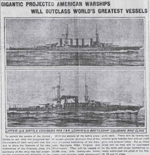 |
NR | GIGANTIC PROJECTED AMERICAN WARSHIPS WILL OUTCLASS WORLD'S GREATEST VESSELS With the picture of the battle cruiser (upper picture) is shown that of the new projected battleship of the Colorado (BB-45), Maryland (BB-46), West Virginia (BB-48) and Washington (BB-47). They will be vessels of 32,600 tons, With twenty-one knots speed and carrying eight sixteen inch guns each. There will be twenty-two smaller guns besides four anti-air craft guns and torpedo tubes. Big as these ships will be they will be outclassed by the three still newer battleships already authorized, the ships of the 49, 50, 51 class. |
Image and text provided by Ohio Historical Society, Columbus, OH. Photo from The Democratic Banner. (Mt. Vernon, Ohio) 1898-192?, 26 December 1916, Image 1, via chroniclingamerica.loc.gov. | ||||||||||||||||||||||||||||||||||||||||||||||||||||||||||||||||||||||||||||||||||||||||||||||||||||||||||||||||||||||||||||||||||||||||||||||||||||||||||||||||||||||||||||||||||||||||||||||||||||||||||||||||||||||||||||||||||||||||||||||||||||||||||||||||||||||||||||||||||||||||||||||||||||||||||||||||||||||||||||||||||||||||||||||||||||||||||||||||||||||||||||||||||||||||||||||||||||||||||||||||||||||||||||||||||||||||||
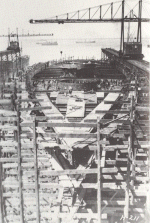 | 140k | Keel of the West Virginia (BB-48) under construction at Newport News Shipbuilding, Newport News, VA., on 7 August 1920. | USN photo from the Mariners Museum, courtesy of Myron J. Smith Jr, from his book "Mountainer State Battlewagon", from Pictorial Histories Publishing, Missoula, Montana. | ||||||||||||||||||||||||||||||||||||||||||||||||||||||||||||||||||||||||||||||||||||||||||||||||||||||||||||||||||||||||||||||||||||||||||||||||||||||||||||||||||||||||||||||||||||||||||||||||||||||||||||||||||||||||||||||||||||||||||||||||||||||||||||||||||||||||||||||||||||||||||||||||||||||||||||||||||||||||||||||||||||||||||||||||||||||||||||||||||||||||||||||||||||||||||||||||||||||||||||||||||||||||||||||||||||||||||
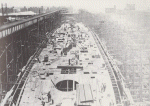 | 188k | Construction of the West Virginia (BB-48) on 2 May 1921. She is about 30% built at this stage. | USN photo from the Mariners Museum, courtesy of Myron J. Smith Jr, from his book "Mountainer State Battlewagon", from Pictorial Histories Publishing, Missoula, Montana. | ||||||||||||||||||||||||||||||||||||||||||||||||||||||||||||||||||||||||||||||||||||||||||||||||||||||||||||||||||||||||||||||||||||||||||||||||||||||||||||||||||||||||||||||||||||||||||||||||||||||||||||||||||||||||||||||||||||||||||||||||||||||||||||||||||||||||||||||||||||||||||||||||||||||||||||||||||||||||||||||||||||||||||||||||||||||||||||||||||||||||||||||||||||||||||||||||||||||||||||||||||||||||||||||||||||||||||
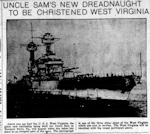 | NR | UNCLE SAM'S NEW DREADNAUGHT TO BE CHRISTENED WEST VIRGINIA The West Virginia (BB-48) was authorised 29 August 1916, and the contract for her construction signed 5 December of the same year, supplementary contracts being signed 29 May 1917, and 19 June 1920. The keel was laid 12 April 1920. This seeming delay, it is understood is due to the fact that during the war, the navy gave priority to the completion of ships actually needed urgently and which could be finished during the war, in preference to using material and labor on a huge ship which could not have been completed within the time necessary for war use, anyway. | Image provided by: Library of Congress, Washington, DC. Photo & text by The Washington Times. (Washington [D.C.]) 1902-1939, 16 October 1921, SUNDAY MORNING, Image 2, courtesy of chroniclingamerica.loc.gov. | ||||||||||||||||||||||||||||||||||||||||||||||||||||||||||||||||||||||||||||||||||||||||||||||||||||||||||||||||||||||||||||||||||||||||||||||||||||||||||||||||||||||||||||||||||||||||||||||||||||||||||||||||||||||||||||||||||||||||||||||||||||||||||||||||||||||||||||||||||||||||||||||||||||||||||||||||||||||||||||||||||||||||||||||||||||||||||||||||||||||||||||||||||||||||||||||||||||||||||||||||||||||||||||||||||||||||||
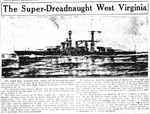 | NR | The Super-Dreadnaught West Virginia (BB-48) | Image and text provided by West Virginia University. Photo by The Wheeling Intelligencer. (Wheeling, W. Va.) 1903-1961, 18 November 1921, Image 1, courtesy of chroniclingamerica.loc.gov. | ||||||||||||||||||||||||||||||||||||||||||||||||||||||||||||||||||||||||||||||||||||||||||||||||||||||||||||||||||||||||||||||||||||||||||||||||||||||||||||||||||||||||||||||||||||||||||||||||||||||||||||||||||||||||||||||||||||||||||||||||||||||||||||||||||||||||||||||||||||||||||||||||||||||||||||||||||||||||||||||||||||||||||||||||||||||||||||||||||||||||||||||||||||||||||||||||||||||||||||||||||||||||||||||||||||||||||
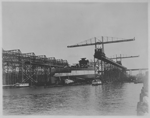 014848u | 564k | Stern view of the West Virginia (BB-48) in Shipyard for Christening Ceremony. | Photo courtesy of usswv.lib.wvu.edu. Photo courtesy of Daniel Hacker. |
||||||||||||||||||||||||||||||||||||||||||||||||||||||||||||||||||||||||||||||||||||||||||||||||||||||||||||||||||||||||||||||||||||||||||||||||||||||||||||||||||||||||||||||||||||||||||||||||||||||||||||||||||||||||||||||||||||||||||||||||||||||||||||||||||||||||||||||||||||||||||||||||||||||||||||||||||||||||||||||||||||||||||||||||||||||||||||||||||||||||||||||||||||||||||||||||||||||||||||||||||||||||||||||||||||||||||
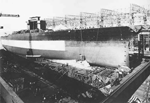 | 484k | The unfinished West Virginia (BB-48) stands before christening. | USN photo courtesy of Scott Koen & ussnewyork.com. | ||||||||||||||||||||||||||||||||||||||||||||||||||||||||||||||||||||||||||||||||||||||||||||||||||||||||||||||||||||||||||||||||||||||||||||||||||||||||||||||||||||||||||||||||||||||||||||||||||||||||||||||||||||||||||||||||||||||||||||||||||||||||||||||||||||||||||||||||||||||||||||||||||||||||||||||||||||||||||||||||||||||||||||||||||||||||||||||||||||||||||||||||||||||||||||||||||||||||||||||||||||||||||||||||||||||||||
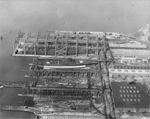 014843 | 245k | Photo from the Newport News Shipbuilding and Dry Dock Company which shows the West Virginia (BB-48) on the shipway awaiting her launching 19 November 1921. One of the two large vessels being built on the ways behind her is most probably the South Dakota class battleship Iowa (BB-53), which would be cancelled 17 August 1923 in accordance with the terms of the Washington Treaty limiting Naval armaments. She was sold for scrap 8 November 1923. The photos of Iowa under construction clearly show her being built in the left-hand (western most) of the two covered ways. So this photo of West Virginia, looking toward the west, would show another ship in the nearer covered way and Iowa would be in the one farther away. Based on the shape of the scaffolding on the nearer covered way, the bow shape suggests warship rather than merchant, and the length would be consistent with one of the battlecruisers. Constellation (CC-2) would be more likely than Ranger (CC-4), based on the height of the scaffold, but that then begs the question of where Ranger was being built since she would have been too long for most of the open ways in the yard. Navsource, Friedman, and Breyer all agree that Constellation was laid down at Newport News in August of 1920. West Virginia was not launched until November 1921. Ranger was laid down in June of 1921, and so her construction (and scaffold height) would probably not have reached the level of that seen in the nearer covered way, based on the slower, peace time work schedule. |
Text i.d. courtesy of Richard M. Jensen. Photo courtesy of Dale Hargrave. | ||||||||||||||||||||||||||||||||||||||||||||||||||||||||||||||||||||||||||||||||||||||||||||||||||||||||||||||||||||||||||||||||||||||||||||||||||||||||||||||||||||||||||||||||||||||||||||||||||||||||||||||||||||||||||||||||||||||||||||||||||||||||||||||||||||||||||||||||||||||||||||||||||||||||||||||||||||||||||||||||||||||||||||||||||||||||||||||||||||||||||||||||||||||||||||||||||||||||||||||||||||||||||||||||||||||||||
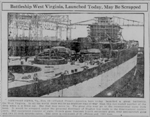 014821m |
NR | Battleship West Virginia (BB-48), Launched Today, May Be Scrapped NEWPORT NEWS, Va., Nov. 19—(United Press) America here to day launched a great battleship, the West Virginia. In all the world there will be no mightier man-o'-war than this red-leaded panther of the deep when it is fitted out. But that may never be. The great ship may go to the international naval junk heap. It would be scrapped under the proposal Secretary of Hughes has made to the disarmament conference. Her equipment consists of eight 16-inch guns, fourteen 5-inch secondary guns, four anti-aircraft guns and two 21-inch torpedo tubes. The crew is composed of 61 officers and 1585 men. | Image and text provided by University of Delaware Library, Newark, DE. Photo by Evening Journal. [volume] (Wilmington, Del.) 1888-1932, 19 November 1921, Image 1, courtesy of chroniclingamerica.loc.gov. | ||||||||||||||||||||||||||||||||||||||||||||||||||||||||||||||||||||||||||||||||||||||||||||||||||||||||||||||||||||||||||||||||||||||||||||||||||||||||||||||||||||||||||||||||||||||||||||||||||||||||||||||||||||||||||||||||||||||||||||||||||||||||||||||||||||||||||||||||||||||||||||||||||||||||||||||||||||||||||||||||||||||||||||||||||||||||||||||||||||||||||||||||||||||||||||||||||||||||||||||||||||||||||||||||||||||||||
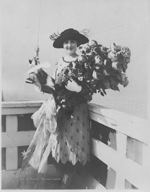 014880a | 310k | Miss Alice Mann and her family stand in this uncut photo before West Virginia (BB-48) was christened. Alice Wright-Mann, of Mercer County, is pictured with a large bouquet of flowers and what appears to be a bottle of champagne. Ms. Wright-Mann sponsored the battleship which was built by the Newport News Shipbuilding and Drydock Co. of Newport News, Va. Wright-Mann was the daughter of a millionaire coalmine operator, Isaac T. Mann. | Insert photo courtesy of usswv.lib.wvu.edu. Photo courtesy of Daniel Hacker. |
||||||||||||||||||||||||||||||||||||||||||||||||||||||||||||||||||||||||||||||||||||||||||||||||||||||||||||||||||||||||||||||||||||||||||||||||||||||||||||||||||||||||||||||||||||||||||||||||||||||||||||||||||||||||||||||||||||||||||||||||||||||||||||||||||||||||||||||||||||||||||||||||||||||||||||||||||||||||||||||||||||||||||||||||||||||||||||||||||||||||||||||||||||||||||||||||||||||||||||||||||||||||||||||||||||||||||
 014821c | 739k | Miss Alice Mann about to christen the super dreadnought West Virginia (BB-48), the newest addition to Uncle Sam's navy and the seventh of the electric battleships, launched at Newport News last Saturday and destined to grace the scrap pile with in a few months under the naval reduction program. If the American plan is agreed to, the new $40,000,000 dreadnought, now 60 per cent complete, will never be finished. | Image and text provided by Library of Congress, Washington, DC. Photo from New-York Tribune. (New York [N.Y.]) 1866-1924, 27 November 1921, Image 68, via chroniclingamerica.loc.gov. Photo courtesy of usswv.lib.wvu.edu. Photo courtesy of Daniel Hacker. | ||||||||||||||||||||||||||||||||||||||||||||||||||||||||||||||||||||||||||||||||||||||||||||||||||||||||||||||||||||||||||||||||||||||||||||||||||||||||||||||||||||||||||||||||||||||||||||||||||||||||||||||||||||||||||||||||||||||||||||||||||||||||||||||||||||||||||||||||||||||||||||||||||||||||||||||||||||||||||||||||||||||||||||||||||||||||||||||||||||||||||||||||||||||||||||||||||||||||||||||||||||||||||||||||||||||||||
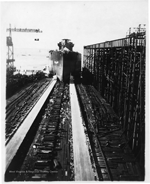 014821s |
656k | LAUNCHED TODAY, WILL BE SCRAPPED TOMORROW. MAYBE. The superdreadnaught West Virginia (BB-48), sliding into the water at Newport News, Va. | Insert image and text provided by Indiana State Library. Photo by The Richmond Palladium and Sun-Telegram. [volume] (Richmond, Ind.) 1907-1939, 24 November 1921, Image 10, courtesy of chroniclingamerica.loc.gov. Photo courtesy of usswv.lib.wvu.edu. Photo courtesy of Daniel Hacker. | ||||||||||||||||||||||||||||||||||||||||||||||||||||||||||||||||||||||||||||||||||||||||||||||||||||||||||||||||||||||||||||||||||||||||||||||||||||||||||||||||||||||||||||||||||||||||||||||||||||||||||||||||||||||||||||||||||||||||||||||||||||||||||||||||||||||||||||||||||||||||||||||||||||||||||||||||||||||||||||||||||||||||||||||||||||||||||||||||||||||||||||||||||||||||||||||||||||||||||||||||||||||||||||||||||||||||||
 014820 | 618k | West Virginia (BB-48) is waterbourne at the end of the ways. | Photo courtesy of usswv.lib.wvu.edu. Photo courtesy of Daniel Hacker. | ||||||||||||||||||||||||||||||||||||||||||||||||||||||||||||||||||||||||||||||||||||||||||||||||||||||||||||||||||||||||||||||||||||||||||||||||||||||||||||||||||||||||||||||||||||||||||||||||||||||||||||||||||||||||||||||||||||||||||||||||||||||||||||||||||||||||||||||||||||||||||||||||||||||||||||||||||||||||||||||||||||||||||||||||||||||||||||||||||||||||||||||||||||||||||||||||||||||||||||||||||||||||||||||||||||||||||
 014856 | 592k | The West Virginia (BB-48) at sea moments after her launch in November 1921, surrounded by support craft. | Photo courtesy of usswv.lib.wvu.edu. Photo courtesy of Daniel Hacker. | ||||||||||||||||||||||||||||||||||||||||||||||||||||||||||||||||||||||||||||||||||||||||||||||||||||||||||||||||||||||||||||||||||||||||||||||||||||||||||||||||||||||||||||||||||||||||||||||||||||||||||||||||||||||||||||||||||||||||||||||||||||||||||||||||||||||||||||||||||||||||||||||||||||||||||||||||||||||||||||||||||||||||||||||||||||||||||||||||||||||||||||||||||||||||||||||||||||||||||||||||||||||||||||||||||||||||||
 014896 | 840k | Looking back on the launching ramp after the West Virginia (BB-48) launching. | Photo courtesy of usswv.lib.wvu.edu. Photo courtesy of Daniel Hacker. | ||||||||||||||||||||||||||||||||||||||||||||||||||||||||||||||||||||||||||||||||||||||||||||||||||||||||||||||||||||||||||||||||||||||||||||||||||||||||||||||||||||||||||||||||||||||||||||||||||||||||||||||||||||||||||||||||||||||||||||||||||||||||||||||||||||||||||||||||||||||||||||||||||||||||||||||||||||||||||||||||||||||||||||||||||||||||||||||||||||||||||||||||||||||||||||||||||||||||||||||||||||||||||||||||||||||||||
 014801c | 517k | West Virginia (BB-48) floats out into Hampton Roads after being launched at the Newport News shipyard. Afterwards she was outfitted and commissioned in 1923.. | Photo courtesy of usswv.lib.wvu.edu. Photo courtesy of Daniel Hacker. | ||||||||||||||||||||||||||||||||||||||||||||||||||||||||||||||||||||||||||||||||||||||||||||||||||||||||||||||||||||||||||||||||||||||||||||||||||||||||||||||||||||||||||||||||||||||||||||||||||||||||||||||||||||||||||||||||||||||||||||||||||||||||||||||||||||||||||||||||||||||||||||||||||||||||||||||||||||||||||||||||||||||||||||||||||||||||||||||||||||||||||||||||||||||||||||||||||||||||||||||||||||||||||||||||||||||||||
 014821n | 659k | Dinner Party for Christening of West Virginia (BB-48), 19 November 1921, | Photo courtesy of usswv.lib.wvu.edu. Photo courtesy of Daniel Hacker. | ||||||||||||||||||||||||||||||||||||||||||||||||||||||||||||||||||||||||||||||||||||||||||||||||||||||||||||||||||||||||||||||||||||||||||||||||||||||||||||||||||||||||||||||||||||||||||||||||||||||||||||||||||||||||||||||||||||||||||||||||||||||||||||||||||||||||||||||||||||||||||||||||||||||||||||||||||||||||||||||||||||||||||||||||||||||||||||||||||||||||||||||||||||||||||||||||||||||||||||||||||||||||||||||||||||||||||
 | 701k | Rear Admiral George McElroy, who heads a special board of naval officers to determine whether the battleship Washington (BB-47) or West Virginia (BB-48) shall be the one completed under the new naval treaty signed at the conference on limitation of armament. By the treaty the United States is allowed to have two ships of this class, the Colorado (BB-45) being completed. | Image and text provided by Library of Congress, Washington, DC. Photo by Evening Star. (Washington, D.C.) 1854-1972, 26 February 1922, Image 68, courtesy of chroniclingamerica.loc.gov. |
||||||||||||||||||||||||||||||||||||||||||||||||||||||||||||||||||||||||||||||||||||||||||||||||||||||||||||||||||||||||||||||||||||||||||||||||||||||||||||||||||||||||||||||||||||||||||||||||||||||||||||||||||||||||||||||||||||||||||||||||||||||||||||||||||||||||||||||||||||||||||||||||||||||||||||||||||||||||||||||||||||||||||||||||||||||||||||||||||||||||||||||||||||||||||||||||||||||||||||||||||||||||||||||||||||||||||
 | 742k | Text reads "THE LEVIATHAN, the world's second largest vessel, safely tied up at Newport News; ready for reconditioning to again enter the trans-Atlantic service. The mammoth vessel, soon to be renamed the President Harding, made the trip down from Hoboken, where she had been tied up for three years, without mishap. A radio phone in each stateroom will be a feature of the liner when she again goes into passenger service. In contrast to the Leviathan is the dreadnought at the right in process of scrapping." Clearly, the ship is West Virginia (BB-48) fitting out (not being scrapped). She would have been at Newport News when Leviathan arrived for reconditioning in April 1922. | Photo & text i.d. courtesy of Chuck Haberlein & Tracy White @ Researcher @ Large.
Image and text provided by Library of Congress, Washington, DC. Photo by New-York Tribune. (New York [N.Y.]) 1866-1924, 30 April 1922, Image 65, courtesy of chroniclingamerica.loc.gov. |
||||||||||||||||||||||||||||||||||||||||||||||||||||||||||||||||||||||||||||||||||||||||||||||||||||||||||||||||||||||||||||||||||||||||||||||||||||||||||||||||||||||||||||||||||||||||||||||||||||||||||||||||||||||||||||||||||||||||||||||||||||||||||||||||||||||||||||||||||||||||||||||||||||||||||||||||||||||||||||||||||||||||||||||||||||||||||||||||||||||||||||||||||||||||||||||||||||||||||||||||||||||||||||||||||||||||||
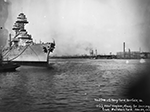 | 213k | Ready for docking from Builder's Yard, 20 November 1922. | National Archives Identifier: 52560011 Local Identifier: 181-V-2944 Photo courtesy of catalog.archives.gov |
||||||||||||||||||||||||||||||||||||||||||||||||||||||||||||||||||||||||||||||||||||||||||||||||||||||||||||||||||||||||||||||||||||||||||||||||||||||||||||||||||||||||||||||||||||||||||||||||||||||||||||||||||||||||||||||||||||||||||||||||||||||||||||||||||||||||||||||||||||||||||||||||||||||||||||||||||||||||||||||||||||||||||||||||||||||||||||||||||||||||||||||||||||||||||||||||||||||||||||||||||||||||||||||||||||||||||
| 1923 - Pre Pearl Harbor Attack |
|||||||||||||||||||||||||||||||||||||||||||||||||||||||||||||||||||||||||||||||||||||||||||||||||||||||||||||||||||||||||||||||||||||||||||||||||||||||||||||||||||||||||||||||||||||||||||||||||||||||||||||||||||||||||||||||||||||||||||||||||||||||||||||||||||||||||||||||||||||||||||||||||||||||||||||||||||||||||||||||||||||||||||||||||||||||||||||||||||||||||||||||||||||||||||||||||||||||||||||||||||||||||||||||||||||||||||||
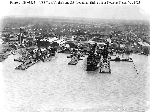 | 101k | Newport News Shipbuilding and Dry Dock Company Shipyard's pier area, February 1923. West Virginia (BB-48) is fitting out in the left center. In right center is S.S. Leviathan refitting for commercial service. | Naval History and Heritage Command photograph # NH 93533 submitted by Robert Hurst. | ||||||||||||||||||||||||||||||||||||||||||||||||||||||||||||||||||||||||||||||||||||||||||||||||||||||||||||||||||||||||||||||||||||||||||||||||||||||||||||||||||||||||||||||||||||||||||||||||||||||||||||||||||||||||||||||||||||||||||||||||||||||||||||||||||||||||||||||||||||||||||||||||||||||||||||||||||||||||||||||||||||||||||||||||||||||||||||||||||||||||||||||||||||||||||||||||||||||||||||||||||||||||||||||||||||||||||
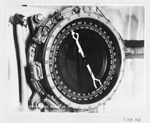 | 283k | West Virginia (BB-48) bearing indicator MK IV MOD 4. | Photo No. f1029n21, Brooklyn Navy Yard Archive - courtesy National Archive and Records Administration, Northeast Region - NYC, Record Group 181 via flickr.com. | ||||||||||||||||||||||||||||||||||||||||||||||||||||||||||||||||||||||||||||||||||||||||||||||||||||||||||||||||||||||||||||||||||||||||||||||||||||||||||||||||||||||||||||||||||||||||||||||||||||||||||||||||||||||||||||||||||||||||||||||||||||||||||||||||||||||||||||||||||||||||||||||||||||||||||||||||||||||||||||||||||||||||||||||||||||||||||||||||||||||||||||||||||||||||||||||||||||||||||||||||||||||||||||||||||||||||||
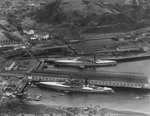 | 1.93k | The California (BB-44) & West Virginia (BB-48), Balboa, C.Z., 10 March 1923. | Panama Canal Zone - Balboa Record Group 18:Records of the Army Air Forces, ca. 1902 - 1964 Series: "Airscapes" of American and Foreign Areas, 1917 - 1964 National Archives Identifier: 68147540 Photo courtesy of catalog.archives.gov | ||||||||||||||||||||||||||||||||||||||||||||||||||||||||||||||||||||||||||||||||||||||||||||||||||||||||||||||||||||||||||||||||||||||||||||||||||||||||||||||||||||||||||||||||||||||||||||||||||||||||||||||||||||||||||||||||||||||||||||||||||||||||||||||||||||||||||||||||||||||||||||||||||||||||||||||||||||||||||||||||||||||||||||||||||||||||||||||||||||||||||||||||||||||||||||||||||||||||||||||||||||||||||||||||||||||||||
 | 88k | The West Virginia (BB-48) on 2 November 1923. She would be the last battleship built until the North Carolina (BB-55) was started in 1940, due to restriction imposed by the 1922 Washington Conference on Limitation of Naval Armament. | USN photo from the Mariners Museum, courtesy of Myron J. Smith Jr, from his book "Mountainer State Battlewagon", from Pictorial Histories Publishing, Missoula, Montana. | ||||||||||||||||||||||||||||||||||||||||||||||||||||||||||||||||||||||||||||||||||||||||||||||||||||||||||||||||||||||||||||||||||||||||||||||||||||||||||||||||||||||||||||||||||||||||||||||||||||||||||||||||||||||||||||||||||||||||||||||||||||||||||||||||||||||||||||||||||||||||||||||||||||||||||||||||||||||||||||||||||||||||||||||||||||||||||||||||||||||||||||||||||||||||||||||||||||||||||||||||||||||||||||||||||||||||||
 | 179k | The bow of West Virginia (BB-48) in dry dock at Brooklyn Navy Yard in 1924. | Courtesy of Darryl L. Baker. | ||||||||||||||||||||||||||||||||||||||||||||||||||||||||||||||||||||||||||||||||||||||||||||||||||||||||||||||||||||||||||||||||||||||||||||||||||||||||||||||||||||||||||||||||||||||||||||||||||||||||||||||||||||||||||||||||||||||||||||||||||||||||||||||||||||||||||||||||||||||||||||||||||||||||||||||||||||||||||||||||||||||||||||||||||||||||||||||||||||||||||||||||||||||||||||||||||||||||||||||||||||||||||||||||||||||||||
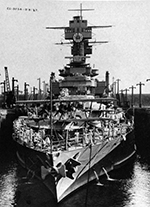 |
1.39k | PN-10 on the forecastle in Gatun Locks, Panama Canal, March 1924. | USN photo s # 80-HAN-110-12 & 80-HAN-110-13, now in the collections of the National Archives, courtesy of the National Museum of the U.S. Navy, via flickr.com. | ||||||||||||||||||||||||||||||||||||||||||||||||||||||||||||||||||||||||||||||||||||||||||||||||||||||||||||||||||||||||||||||||||||||||||||||||||||||||||||||||||||||||||||||||||||||||||||||||||||||||||||||||||||||||||||||||||||||||||||||||||||||||||||||||||||||||||||||||||||||||||||||||||||||||||||||||||||||||||||||||||||||||||||||||||||||||||||||||||||||||||||||||||||||||||||||||||||||||||||||||||||||||||||||||||||||||||
 | 80k | The silhouette of the West Virginia (BB-48) by moonlight. Taken about 1924. | USN photo courtesy of Pieter Bakels. | ||||||||||||||||||||||||||||||||||||||||||||||||||||||||||||||||||||||||||||||||||||||||||||||||||||||||||||||||||||||||||||||||||||||||||||||||||||||||||||||||||||||||||||||||||||||||||||||||||||||||||||||||||||||||||||||||||||||||||||||||||||||||||||||||||||||||||||||||||||||||||||||||||||||||||||||||||||||||||||||||||||||||||||||||||||||||||||||||||||||||||||||||||||||||||||||||||||||||||||||||||||||||||||||||||||||||||
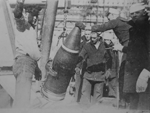 | 82k | Sailors aboard the West Virginia (BB-48) hoist a 16"/45 inch shell on board ship, circa 1924. | Photo courtesy of Wendy Chandler via Bill Gonyo. | ||||||||||||||||||||||||||||||||||||||||||||||||||||||||||||||||||||||||||||||||||||||||||||||||||||||||||||||||||||||||||||||||||||||||||||||||||||||||||||||||||||||||||||||||||||||||||||||||||||||||||||||||||||||||||||||||||||||||||||||||||||||||||||||||||||||||||||||||||||||||||||||||||||||||||||||||||||||||||||||||||||||||||||||||||||||||||||||||||||||||||||||||||||||||||||||||||||||||||||||||||||||||||||||||||||||||||
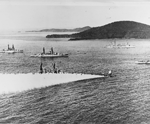 014508 |
1.69k | A naval scouting plane lays a protective smokescreen during maneuvers in the Caribbean Sea, 21 March 1924. Left to right: New York (BB-34/35) class battleship; Pennsylvania (BB-38/39) class battleship; Tennessee (BB-43/44) class battleship (behind smoke); Omaha (CL-4/13) class cruiser; Tennessee or Colorado (BB-45/48) class battleship (stern only visible). | Photo NH-69203 courtesy of history.navy.mil | ||||||||||||||||||||||||||||||||||||||||||||||||||||||||||||||||||||||||||||||||||||||||||||||||||||||||||||||||||||||||||||||||||||||||||||||||||||||||||||||||||||||||||||||||||||||||||||||||||||||||||||||||||||||||||||||||||||||||||||||||||||||||||||||||||||||||||||||||||||||||||||||||||||||||||||||||||||||||||||||||||||||||||||||||||||||||||||||||||||||||||||||||||||||||||||||||||||||||||||||||||||||||||||||||||||||||||
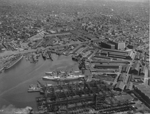 014824b |
2.07k | Brooklyn Navy Yard, 18 July 1924. Top, left to right: transport Agamemnon (Id. No. 3004),(ex-German liner Kaiser Willhelm II), two destroyers, two auxiliaries, an Omaha class cruiser, and an Eagle boat. A submarine is visible in drydock. Middle: an Omaha class cruiser, West Virginia (BB-48), and three destroyers. Across the pier from the destroyers, partially obscured by the covered shipbuilding ways, is what appears to be the predreadnought battleship ex-Illinois (BB-7), undergoing conversion to a floating armory for the New York Naval Militia. | NARA photo from Record Group 18: Records of the Army Air Forces Series: "Airscapes" of American and Foreign Areas File Unit: New York - Docks-New York Harbor Local ID: 18-AA-94-16 NAID: 68146206 Photo courtesy of catalog.archives.gov courtesy of Theodore Leverett. |
||||||||||||||||||||||||||||||||||||||||||||||||||||||||||||||||||||||||||||||||||||||||||||||||||||||||||||||||||||||||||||||||||||||||||||||||||||||||||||||||||||||||||||||||||||||||||||||||||||||||||||||||||||||||||||||||||||||||||||||||||||||||||||||||||||||||||||||||||||||||||||||||||||||||||||||||||||||||||||||||||||||||||||||||||||||||||||||||||||||||||||||||||||||||||||||||||||||||||||||||||||||||||||||||||||||||||
 | NR | America's Greatest Sea Fighter Puts Out for Speed Trials The gray of the battleship West Virginia (BB-48) merged with the neutral tint of background as she passed Brooklyn Bridge bound for her sea trials. | Image and text provided by Connecticut State Library, Hartford, CT. Photo by New Britain Herald. (New Britain, Conn.) 1890-1976, 20 August 1924, Image 12, courtesy of chroniclingamerica.loc.gov. | ||||||||||||||||||||||||||||||||||||||||||||||||||||||||||||||||||||||||||||||||||||||||||||||||||||||||||||||||||||||||||||||||||||||||||||||||||||||||||||||||||||||||||||||||||||||||||||||||||||||||||||||||||||||||||||||||||||||||||||||||||||||||||||||||||||||||||||||||||||||||||||||||||||||||||||||||||||||||||||||||||||||||||||||||||||||||||||||||||||||||||||||||||||||||||||||||||||||||||||||||||||||||||||||||||||||||||
 | 184k | Post card photo of the West Virginia (BB-48) going through the Panama Canal in October 1924. | Courtesy of Darryl L. Baker. | ||||||||||||||||||||||||||||||||||||||||||||||||||||||||||||||||||||||||||||||||||||||||||||||||||||||||||||||||||||||||||||||||||||||||||||||||||||||||||||||||||||||||||||||||||||||||||||||||||||||||||||||||||||||||||||||||||||||||||||||||||||||||||||||||||||||||||||||||||||||||||||||||||||||||||||||||||||||||||||||||||||||||||||||||||||||||||||||||||||||||||||||||||||||||||||||||||||||||||||||||||||||||||||||||||||||||||
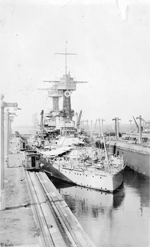 | 427k | West Virginia (BB-48) transiting the Panama Canal in October 1924. | Photo courtesy of Wayne McLaughlin via Fred Willshaw. | ||||||||||||||||||||||||||||||||||||||||||||||||||||||||||||||||||||||||||||||||||||||||||||||||||||||||||||||||||||||||||||||||||||||||||||||||||||||||||||||||||||||||||||||||||||||||||||||||||||||||||||||||||||||||||||||||||||||||||||||||||||||||||||||||||||||||||||||||||||||||||||||||||||||||||||||||||||||||||||||||||||||||||||||||||||||||||||||||||||||||||||||||||||||||||||||||||||||||||||||||||||||||||||||||||||||||||
 | 37k | Deck of the West Virginia (BB-48) awash in high seas between 1924 and 1925. | USN photo courtesy of Pieter Bakels. | ||||||||||||||||||||||||||||||||||||||||||||||||||||||||||||||||||||||||||||||||||||||||||||||||||||||||||||||||||||||||||||||||||||||||||||||||||||||||||||||||||||||||||||||||||||||||||||||||||||||||||||||||||||||||||||||||||||||||||||||||||||||||||||||||||||||||||||||||||||||||||||||||||||||||||||||||||||||||||||||||||||||||||||||||||||||||||||||||||||||||||||||||||||||||||||||||||||||||||||||||||||||||||||||||||||||||||
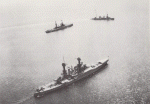 | 155k | Sailors "man the rails" in honor of the President of Haiti and the U.S. Sec. of the Navy who were reviewing the fleet off the coast of Haiti, circa 1925. | USN photo from the Mariners Museum, courtesy of Myron J. Smith Jr, from his book "Mountainer State Battlewagon", from Pictorial Histories Publishing, Missoula, Montana. | ||||||||||||||||||||||||||||||||||||||||||||||||||||||||||||||||||||||||||||||||||||||||||||||||||||||||||||||||||||||||||||||||||||||||||||||||||||||||||||||||||||||||||||||||||||||||||||||||||||||||||||||||||||||||||||||||||||||||||||||||||||||||||||||||||||||||||||||||||||||||||||||||||||||||||||||||||||||||||||||||||||||||||||||||||||||||||||||||||||||||||||||||||||||||||||||||||||||||||||||||||||||||||||||||||||||||||
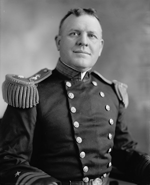 | 117k | Captain Thomas J. Senn was the commanding officer of the West Virginia (BB-48) at her commissioning. He was captain from 1 December 1923 to 5 May 1925. He was promoted to Rear Admiral and served as Assistant Chief of Naval Operations from 1925-1928. | Photo from the Library of Congress via Bill Gonyo. | ||||||||||||||||||||||||||||||||||||||||||||||||||||||||||||||||||||||||||||||||||||||||||||||||||||||||||||||||||||||||||||||||||||||||||||||||||||||||||||||||||||||||||||||||||||||||||||||||||||||||||||||||||||||||||||||||||||||||||||||||||||||||||||||||||||||||||||||||||||||||||||||||||||||||||||||||||||||||||||||||||||||||||||||||||||||||||||||||||||||||||||||||||||||||||||||||||||||||||||||||||||||||||||||||||||||||||
 014825e |
548k | Captain Thomas J. Senn was the commanding officer of the West Virginia (BB-48) during her visit to Australia. She appears here in the center with the battle efficiency E on her funnel.
Panorama of Sydney Harbour during the United States Navy's goodwill tour. On 23 July 1925, Sydney hosted eight of the US Navy Battle Fleet's largest ships, including California (BB-44), Colorado (BB-45),Tennessee (BB-43), Maryland (BB-46), West Virginia , New Mexico (BB-40), Mississippi (BB-41) and Idaho (BB-42). The fleet departed for New Zealand on 6 August. This photograph was probably taken at Georges Head Battery, in Georges Heights in the Sydney suburb of Mosman. This photo is part of the Australian National Maritime Museum’s Samuel J. Hood Studio collection. Sam Hood (1872-1953) was a Sydney photographer with a passion for ships. His 60-year career spanned the romantic age of sail and two world wars. The photos in the collection were taken mainly in Sydney and Newcastle during the first half of the 20th century. The ANMM undertakes research and accepts public comments that enhance the information we hold about images in our collection. This record has been updated accordingly. |
Image and text provided by flickr.com | ||||||||||||||||||||||||||||||||||||||||||||||||||||||||||||||||||||||||||||||||||||||||||||||||||||||||||||||||||||||||||||||||||||||||||||||||||||||||||||||||||||||||||||||||||||||||||||||||||||||||||||||||||||||||||||||||||||||||||||||||||||||||||||||||||||||||||||||||||||||||||||||||||||||||||||||||||||||||||||||||||||||||||||||||||||||||||||||||||||||||||||||||||||||||||||||||||||||||||||||||||||||||||||||||||||||||||
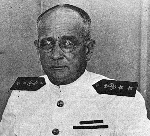 | 197k | Captain Arthur J. Hepburn took command of the West Virginia (BB-48) on 5 May 1925 and was relieved on 5 June 1926. | Photo scanned from the book, "Admiral William Veazie Pratt, U.S. Navy: A Sailor's Life", by Gerald E. Wheeler, courtesy of Bill Gonyo. | ||||||||||||||||||||||||||||||||||||||||||||||||||||||||||||||||||||||||||||||||||||||||||||||||||||||||||||||||||||||||||||||||||||||||||||||||||||||||||||||||||||||||||||||||||||||||||||||||||||||||||||||||||||||||||||||||||||||||||||||||||||||||||||||||||||||||||||||||||||||||||||||||||||||||||||||||||||||||||||||||||||||||||||||||||||||||||||||||||||||||||||||||||||||||||||||||||||||||||||||||||||||||||||||||||||||||||
 |
1.90k | Port Angeles Washington: The lack of turret bearing markings places the photo post 1924 while the already noted presence of the Kidder (DD-319) places it before 1930. The front row of battleships are, left to right, Colorado (BB-45) based on the turret two rangefinder, West Virginia (BB-48) based on the lack of a turret two rangefinder, and probably California (BB-44) based on the bridge configuration. The back row, left to right, are New Mexico (BB-40) based on the higher bridge configuration, Mississippi (BB-41), based on the lower bridge and the fact that the searchlights and lookout station on the main mast are lower than those on the foremast (BB-42 had them at the same height), and Maryland (BB-46) based on the configuration of the turret two rangefinder. | Photo courtesy of Curtis Nicolaisen. Photo & text i.d. courtesy of Richard Jensen. | ||||||||||||||||||||||||||||||||||||||||||||||||||||||||||||||||||||||||||||||||||||||||||||||||||||||||||||||||||||||||||||||||||||||||||||||||||||||||||||||||||||||||||||||||||||||||||||||||||||||||||||||||||||||||||||||||||||||||||||||||||||||||||||||||||||||||||||||||||||||||||||||||||||||||||||||||||||||||||||||||||||||||||||||||||||||||||||||||||||||||||||||||||||||||||||||||||||||||||||||||||||||||||||||||||||||||||
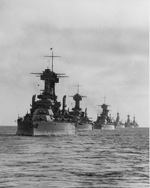 | 1.22k | The United States Battle Fleet steaming in column off the California coast during the middle or later 1920s. The three leading ships are (in no particular order) Colorado (BB-45), Maryland (BB-46) and West Virginia (BB-48) followed by Tennessee (BB-43) and three older battleships. Photograph taken from California (BB-44). | Official USN photo Naval History and Heritage Command # 80-G-695093, now in the collections of the National Archives. | ||||||||||||||||||||||||||||||||||||||||||||||||||||||||||||||||||||||||||||||||||||||||||||||||||||||||||||||||||||||||||||||||||||||||||||||||||||||||||||||||||||||||||||||||||||||||||||||||||||||||||||||||||||||||||||||||||||||||||||||||||||||||||||||||||||||||||||||||||||||||||||||||||||||||||||||||||||||||||||||||||||||||||||||||||||||||||||||||||||||||||||||||||||||||||||||||||||||||||||||||||||||||||||||||||||||||||
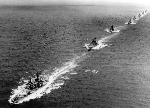 | 272k | The West Virginia (BB-48) as flagship for the Commander, Battleship Divisions, Battle Fleet, followed by other battleships steaming in line ahead during the middle through later 1920's. Note SOC float-planes on the catapults. The four leading ships behind her are (in no particular order) Colorado (BB-45), Maryland (BB-46), California (BB-44) & Tennessee (BB-43). | Photo courtesy of Pieter Bakels. | ||||||||||||||||||||||||||||||||||||||||||||||||||||||||||||||||||||||||||||||||||||||||||||||||||||||||||||||||||||||||||||||||||||||||||||||||||||||||||||||||||||||||||||||||||||||||||||||||||||||||||||||||||||||||||||||||||||||||||||||||||||||||||||||||||||||||||||||||||||||||||||||||||||||||||||||||||||||||||||||||||||||||||||||||||||||||||||||||||||||||||||||||||||||||||||||||||||||||||||||||||||||||||||||||||||||||||
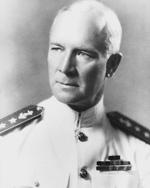 | 46k | Captain Wat Tyler Cluverius was the Commanding Officer of the battleship West Virginia (BB-48) from 5 June 1926 to 26 June 1928. | Photo from the Library of Congress via Bill Gonyo. | ||||||||||||||||||||||||||||||||||||||||||||||||||||||||||||||||||||||||||||||||||||||||||||||||||||||||||||||||||||||||||||||||||||||||||||||||||||||||||||||||||||||||||||||||||||||||||||||||||||||||||||||||||||||||||||||||||||||||||||||||||||||||||||||||||||||||||||||||||||||||||||||||||||||||||||||||||||||||||||||||||||||||||||||||||||||||||||||||||||||||||||||||||||||||||||||||||||||||||||||||||||||||||||||||||||||||||
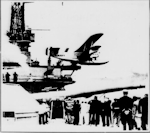 | NR | Catapulting a plane from a battleship for the first time by a powder explosion. A charge of powder equal to that used in firing an 8-inch shell was used in "shooting" this 5,100-pound amphibian plane from a turret catapult on the West Virginia (BB-48) in recent experiments in Los Angeles Harbor. | © Wide World Photo. Photo & text by Evening Star. [volume] (Washington, D.C.) 1854-1972, 07 November 1926, Image 106, courtesy of chroniclingamerica.loc.gov. | ||||||||||||||||||||||||||||||||||||||||||||||||||||||||||||||||||||||||||||||||||||||||||||||||||||||||||||||||||||||||||||||||||||||||||||||||||||||||||||||||||||||||||||||||||||||||||||||||||||||||||||||||||||||||||||||||||||||||||||||||||||||||||||||||||||||||||||||||||||||||||||||||||||||||||||||||||||||||||||||||||||||||||||||||||||||||||||||||||||||||||||||||||||||||||||||||||||||||||||||||||||||||||||||||||||||||||
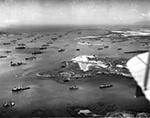 |
2.60k | Ships of the U.S. Fleet pictured at anchor at Guantanamo Bay, Cuba, during winter exercises in 1927. The "center" row has Mississippi (BB-41) then Langley (CV-1) , Oklahoma (BB-37), Pennsylvania (BB-38) and Arizona (BB-39) in that order. The next row to the left has Idaho (BB-42) then New Mexico (BB-40), followed by 3 of the Tennessee/Colorado class (hard to pick out distinguishing features in this photo), with Nevada (BB-36) as tail-end-Charlie. Further to the left are another Tennessee/Colorado class BB and a Memphis (formerly Tennessee) class armored cruiser. Two unidentified Omaha class cruisers are in the foreground. There are at least 17 destroyers, identifiable (bottom, right) is Mahan (DD-102), converted to a minelayer and redesignated DM-7, but still wearing her old DD hull number (102) and two submarine tenders in the foreground with about 10 smaller and two large submarines. The peninsula in the right foreground is South Toro Cay, where the drydock is still visible that was begun in 1904, but cancelled two years later. |
Photo i.d. courtesy of Richard Jensen & wikipedia.org. Photo courtesy of wikipedia.org via Branden Deschaine & Fabio Pena. | ||||||||||||||||||||||||||||||||||||||||||||||||||||||||||||||||||||||||||||||||||||||||||||||||||||||||||||||||||||||||||||||||||||||||||||||||||||||||||||||||||||||||||||||||||||||||||||||||||||||||||||||||||||||||||||||||||||||||||||||||||||||||||||||||||||||||||||||||||||||||||||||||||||||||||||||||||||||||||||||||||||||||||||||||||||||||||||||||||||||||||||||||||||||||||||||||||||||||||||||||||||||||||||||||||||||||||
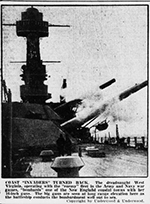 | 55k | COAST "INVADERS" TURNED BACK. The dreadnaught West Virginia (BB-48), operating with the "enemy" fleet in the Army and Navy war games, "bombards" one of the New England coastal towns with her 16-inch guns. The big guns are seen at long range elevation here as the battleship conducts the bombardment well out to sea. | Photographer: Copyright by Underwood & Underwood. Image and text provided by Library of Congress, Washington, DC. via Evening Star. [volume] (Washington, D.C.) 1854-1972, 23 May 1927, Image 13, courtesy of chroniclingamerica.loc.gov. |
||||||||||||||||||||||||||||||||||||||||||||||||||||||||||||||||||||||||||||||||||||||||||||||||||||||||||||||||||||||||||||||||||||||||||||||||||||||||||||||||||||||||||||||||||||||||||||||||||||||||||||||||||||||||||||||||||||||||||||||||||||||||||||||||||||||||||||||||||||||||||||||||||||||||||||||||||||||||||||||||||||||||||||||||||||||||||||||||||||||||||||||||||||||||||||||||||||||||||||||||||||||||||||||||||||||||||
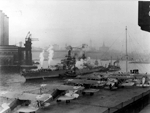 | 240k | With the Langley (CV-1) moored in the foreground and the Manhattan Bridge silhouetted in the background, the West Virginia (BB-48) is assisted by tugs and moved out of her berth in May, 1927. | US Navy and Marine Corps Museum/Naval Aviation Museum, Photo No. 1996.253.7128.001 courtesy of Mike Green. Photo i.d. courtesy of Charles Sauer. |
||||||||||||||||||||||||||||||||||||||||||||||||||||||||||||||||||||||||||||||||||||||||||||||||||||||||||||||||||||||||||||||||||||||||||||||||||||||||||||||||||||||||||||||||||||||||||||||||||||||||||||||||||||||||||||||||||||||||||||||||||||||||||||||||||||||||||||||||||||||||||||||||||||||||||||||||||||||||||||||||||||||||||||||||||||||||||||||||||||||||||||||||||||||||||||||||||||||||||||||||||||||||||||||||||||||||||
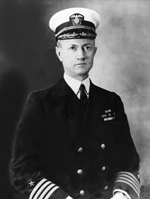 | 525k | Captain Orin Gould Murfin was the commanding officer of the battleship West Virginia (BB-48) from 26 June 1928 to 15 June 1929. Following his command he was promoted to the rank of Rear Admiral. He served as Navy Judge Advocate General from 1931-1934 and Commander-in-Chief of the Asiatic Fleet from 1935-1936. In 1937 as Commandant of the 14th Naval District, he headed the search for Amelia Earhart. In retirement he served as president of the Navy Court of Inquiry following the Japanese attack on Pearl Harbor. | Text & USN photo courtesy of Bill Gonyo. | ||||||||||||||||||||||||||||||||||||||||||||||||||||||||||||||||||||||||||||||||||||||||||||||||||||||||||||||||||||||||||||||||||||||||||||||||||||||||||||||||||||||||||||||||||||||||||||||||||||||||||||||||||||||||||||||||||||||||||||||||||||||||||||||||||||||||||||||||||||||||||||||||||||||||||||||||||||||||||||||||||||||||||||||||||||||||||||||||||||||||||||||||||||||||||||||||||||||||||||||||||||||||||||||||||||||||||
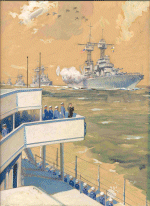 | 122 | Watercolor of a Presidential review during President Hoover's term of office, 1928-32. Crews line the rails of a Colorado class (BB-45 / 48) battleship as the ships pass in line astern of the reviewing stand with the airship Los Angeles (ZR-3) piercing the clouds accompanied by 9 biplanes. | Courtesy of Michael Schwarz. | ||||||||||||||||||||||||||||||||||||||||||||||||||||||||||||||||||||||||||||||||||||||||||||||||||||||||||||||||||||||||||||||||||||||||||||||||||||||||||||||||||||||||||||||||||||||||||||||||||||||||||||||||||||||||||||||||||||||||||||||||||||||||||||||||||||||||||||||||||||||||||||||||||||||||||||||||||||||||||||||||||||||||||||||||||||||||||||||||||||||||||||||||||||||||||||||||||||||||||||||||||||||||||||||||||||||||||
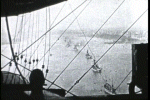 | 56k | View of the U.S. Battlefleet from above, possibly from the airship Los Angeles (ZR-3). | Photo courtesy of periscopefilm.com. | ||||||||||||||||||||||||||||||||||||||||||||||||||||||||||||||||||||||||||||||||||||||||||||||||||||||||||||||||||||||||||||||||||||||||||||||||||||||||||||||||||||||||||||||||||||||||||||||||||||||||||||||||||||||||||||||||||||||||||||||||||||||||||||||||||||||||||||||||||||||||||||||||||||||||||||||||||||||||||||||||||||||||||||||||||||||||||||||||||||||||||||||||||||||||||||||||||||||||||||||||||||||||||||||||||||||||||
 | 221k | Circa later 1920's plus photo of the West Virginia (BB-48). In order to keep pace with technological developments in ordnance, gunnery, and fire control-as well as engineering and aviation-the ship underwent modifications designed to increase the ship's capacity to perform her designed function. Some of the alterations effected included the replacement of her initial 3-inch antiaircraft battery with 5-inch/25-caliber dual-purpose guns; the addition of platforms for .50-caliber machine guns at the foremast and maintop; and the addition of catapults on her quarterdeck, aft, and on her number III, or "high" turret. | USN photo courtesy of Robert M. Cieri. Text courtesy of DANFS. | ||||||||||||||||||||||||||||||||||||||||||||||||||||||||||||||||||||||||||||||||||||||||||||||||||||||||||||||||||||||||||||||||||||||||||||||||||||||||||||||||||||||||||||||||||||||||||||||||||||||||||||||||||||||||||||||||||||||||||||||||||||||||||||||||||||||||||||||||||||||||||||||||||||||||||||||||||||||||||||||||||||||||||||||||||||||||||||||||||||||||||||||||||||||||||||||||||||||||||||||||||||||||||||||||||||||||||
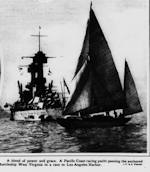 | NR | A blend of power and grace. A Pacific Coast racing yacht passing the anchored battleship West Virginia (BB-48) in a race in Los Angeles Harbor. | Image and text provided by Library of Congress, Washington, DC. Photo & text by Evening Star. [volume] (Washington, D.C.) 1854-1972, 03 February 1929, Image 90, courtesy of chroniclingamerica.loc.gov. | ||||||||||||||||||||||||||||||||||||||||||||||||||||||||||||||||||||||||||||||||||||||||||||||||||||||||||||||||||||||||||||||||||||||||||||||||||||||||||||||||||||||||||||||||||||||||||||||||||||||||||||||||||||||||||||||||||||||||||||||||||||||||||||||||||||||||||||||||||||||||||||||||||||||||||||||||||||||||||||||||||||||||||||||||||||||||||||||||||||||||||||||||||||||||||||||||||||||||||||||||||||||||||||||||||||||||||
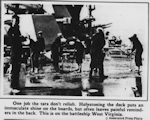 | 43k | One job the tars don't relish. Holystoning the deck puts an immaculate shine on the boards, but often leaves painful reminders in the back. This is on the battleship West Virginia (BB-48). | © Associated Press Photo. Image provided by: Library of Congress, Washington, DC. Photo & text by Evening Star. [volume] (Washington, D.C.) 1854-1972, 14 April 1929, Image 117, courtesy of chroniclingamerica.loc.gov. | ||||||||||||||||||||||||||||||||||||||||||||||||||||||||||||||||||||||||||||||||||||||||||||||||||||||||||||||||||||||||||||||||||||||||||||||||||||||||||||||||||||||||||||||||||||||||||||||||||||||||||||||||||||||||||||||||||||||||||||||||||||||||||||||||||||||||||||||||||||||||||||||||||||||||||||||||||||||||||||||||||||||||||||||||||||||||||||||||||||||||||||||||||||||||||||||||||||||||||||||||||||||||||||||||||||||||||
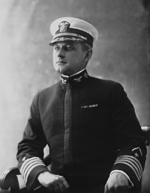 | 110k | Capt. Edward Theodore Constein was commanding officer of the battleship West Virginia (BB-48) from 15 June 1929 to 26 June 1930. | Photo from the Arnold Genthe Collection (Library of Congress) via Bill Gonyo. | ||||||||||||||||||||||||||||||||||||||||||||||||||||||||||||||||||||||||||||||||||||||||||||||||||||||||||||||||||||||||||||||||||||||||||||||||||||||||||||||||||||||||||||||||||||||||||||||||||||||||||||||||||||||||||||||||||||||||||||||||||||||||||||||||||||||||||||||||||||||||||||||||||||||||||||||||||||||||||||||||||||||||||||||||||||||||||||||||||||||||||||||||||||||||||||||||||||||||||||||||||||||||||||||||||||||||||
 | 447k | West Virginia (BB-48) circa 1930. | Photo from Charles T. Wilder collection courtesy of David Way. | ||||||||||||||||||||||||||||||||||||||||||||||||||||||||||||||||||||||||||||||||||||||||||||||||||||||||||||||||||||||||||||||||||||||||||||||||||||||||||||||||||||||||||||||||||||||||||||||||||||||||||||||||||||||||||||||||||||||||||||||||||||||||||||||||||||||||||||||||||||||||||||||||||||||||||||||||||||||||||||||||||||||||||||||||||||||||||||||||||||||||||||||||||||||||||||||||||||||||||||||||||||||||||||||||||||||||||
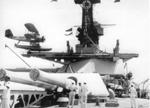 | 411k | The West Virginia (BB-48) with an O3U-1, designated 5-2, mounted on a Mark IV catapult atop #3 Turret in 1930. | Photo courtesy of Pieter Bakels. | ||||||||||||||||||||||||||||||||||||||||||||||||||||||||||||||||||||||||||||||||||||||||||||||||||||||||||||||||||||||||||||||||||||||||||||||||||||||||||||||||||||||||||||||||||||||||||||||||||||||||||||||||||||||||||||||||||||||||||||||||||||||||||||||||||||||||||||||||||||||||||||||||||||||||||||||||||||||||||||||||||||||||||||||||||||||||||||||||||||||||||||||||||||||||||||||||||||||||||||||||||||||||||||||||||||||||||
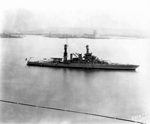 | 351k | West Virginia (BB-48) at anchor in Commencement Bay on 8 July, 1931. The ship, under the command of Rear Admiral R.H. Leigh, was visiting Tacoma as part of Fleet Week. | Source: Tacoma Public Library, Marvin D. Boland Collection, Photo No. BOLAND-B23950 via Mike Green. | ||||||||||||||||||||||||||||||||||||||||||||||||||||||||||||||||||||||||||||||||||||||||||||||||||||||||||||||||||||||||||||||||||||||||||||||||||||||||||||||||||||||||||||||||||||||||||||||||||||||||||||||||||||||||||||||||||||||||||||||||||||||||||||||||||||||||||||||||||||||||||||||||||||||||||||||||||||||||||||||||||||||||||||||||||||||||||||||||||||||||||||||||||||||||||||||||||||||||||||||||||||||||||||||||||||||||||
 | 671k | (Original Caption) 2/5/1932-Los Angeles, CA: Here is an aerial view of 4 of Uncle Sam's Battleships as they left LA Harbor with the rest of the US Battle fleet, for the manuevers of the Hawaiian islands. (Back to front) The ships are: Flagship California (BB-44), Maryland (BB-46), Colorado (BB-45), and West Virginia (BB-48). | Photo by Bettmann, via Getty Images, courtesy of gettyimages.com. | ||||||||||||||||||||||||||||||||||||||||||||||||||||||||||||||||||||||||||||||||||||||||||||||||||||||||||||||||||||||||||||||||||||||||||||||||||||||||||||||||||||||||||||||||||||||||||||||||||||||||||||||||||||||||||||||||||||||||||||||||||||||||||||||||||||||||||||||||||||||||||||||||||||||||||||||||||||||||||||||||||||||||||||||||||||||||||||||||||||||||||||||||||||||||||||||||||||||||||||||||||||||||||||||||||||||||||
 | 413k | New York (BB-34) ahead of Pennsylvania (BB-38). The next ship ahead is a Tennessee class (BB-43 /44) based on the slope of the turret roofs. (Uniform slope back to front - no kink like the twin 16" mounts on the Colorado's (BB-45). Based on the relatively full appearance of the forward superstructure, I am leaning toward California (BB-44) which had an enlarged flag bridge as Battle Force Flagship. The other three are obviously Tennessee (BB-43) and/or Colorado class (BB-45 / 48) but are too indistinct to ID specifically. Because of the boom cranes on the sterns, the photo was taken between 1931 and 1934. | Photo courtesy of Kerry Garrett. Photo & text i.d. courtesy of Richard M. Jensen. | ||||||||||||||||||||||||||||||||||||||||||||||||||||||||||||||||||||||||||||||||||||||||||||||||||||||||||||||||||||||||||||||||||||||||||||||||||||||||||||||||||||||||||||||||||||||||||||||||||||||||||||||||||||||||||||||||||||||||||||||||||||||||||||||||||||||||||||||||||||||||||||||||||||||||||||||||||||||||||||||||||||||||||||||||||||||||||||||||||||||||||||||||||||||||||||||||||||||||||||||||||||||||||||||||||||||||||
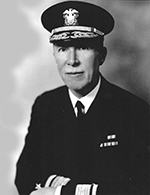 | 110k | Capt. Walter Stratton Anderson commanded West Virginia (BB-48) from January 1932 until December 1933. West Virginia won the battle efficiency pennant for the entirety of his command, a record that stands unique for a battleship and for a captain. | Photo from the Naval History and Heritage Command via Bill Gonyo. | ||||||||||||||||||||||||||||||||||||||||||||||||||||||||||||||||||||||||||||||||||||||||||||||||||||||||||||||||||||||||||||||||||||||||||||||||||||||||||||||||||||||||||||||||||||||||||||||||||||||||||||||||||||||||||||||||||||||||||||||||||||||||||||||||||||||||||||||||||||||||||||||||||||||||||||||||||||||||||||||||||||||||||||||||||||||||||||||||||||||||||||||||||||||||||||||||||||||||||||||||||||||||||||||||||||||||||
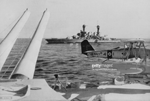 | 562k | The Maryland (BB-46) from West Virginia (BB-48) Bridge, during a drill, of 103 units of the North American fleet took part, November 1932, Pacific Ocean, photo from L'illustrazione Italiana, year LIX, n 50, 11 December 1932. | Photo courtesy of gettyimages.com. | ||||||||||||||||||||||||||||||||||||||||||||||||||||||||||||||||||||||||||||||||||||||||||||||||||||||||||||||||||||||||||||||||||||||||||||||||||||||||||||||||||||||||||||||||||||||||||||||||||||||||||||||||||||||||||||||||||||||||||||||||||||||||||||||||||||||||||||||||||||||||||||||||||||||||||||||||||||||||||||||||||||||||||||||||||||||||||||||||||||||||||||||||||||||||||||||||||||||||||||||||||||||||||||||||||||||||||
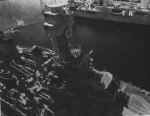 | 112k | Under refit at Puget Sound Naval Yard, 21 August 1933. The small circular platforms on her foremast had been erected for her Mark 19 anti-aircraft directors, which were connected in the unusual anti-aircraft range-finder shown. This range finder could be turned both horizontally and vertically. About 1940, Mark 19's in the fleet were enclosed in small armored boxes and provided with stereoscopic range finders. It is these enclosed directors that appear in photos of the battleships at Pearl Harbor. Note also the wire connecting the roof of the 20 foot range-finder atop the pilot house to the foremast itself, with the range "clock" (concentration dial) for communicating the range to other ships. A similar clock was mounted on the mainmast. Both could be rotated so they could be viewed by other ships not exactly in line ahead. | Photo and text courtesy of U.S. Battleships: An Illustrated Design History by Norman Friedman. | ||||||||||||||||||||||||||||||||||||||||||||||||||||||||||||||||||||||||||||||||||||||||||||||||||||||||||||||||||||||||||||||||||||||||||||||||||||||||||||||||||||||||||||||||||||||||||||||||||||||||||||||||||||||||||||||||||||||||||||||||||||||||||||||||||||||||||||||||||||||||||||||||||||||||||||||||||||||||||||||||||||||||||||||||||||||||||||||||||||||||||||||||||||||||||||||||||||||||||||||||||||||||||||||||||||||||||
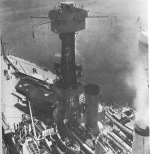 | 212k | Under refit at Puget Sound Naval Yard, 21 August 1933. The structure atop each mast contained, from top to bottom, the main battery director, the main battery spotters and fire controls, and a pair of secondary battery directors, which obtained their ranges from small armored range-finders below the Mark 19 platform. Visible on the bridge wing are a pelorus, a small signalling light, and a 24-inch signalling searchlight with flag lockers at the rear. Note also the roof of the conning tower, with its array of periscopes. Initially, the front of the conning tower was allocated for ship control. The rear half was an armored fire control tower, served by special spotting glasses. At the time of this photo, U.S. battleships were just being fitted with eight 0.50 caliber water cooled machine guns, each as a anti-strafing measure. Note the large "Es" for engineering & presumably tactical excellence, on the ship's after funnel and on the signal bridge side abeam the machine guns, and the ship's number (48) atop her # 2 turret, in white. | Photo and text courtesy of U.S. Battleships: An Illustrated Design History by Norman Friedman. | ||||||||||||||||||||||||||||||||||||||||||||||||||||||||||||||||||||||||||||||||||||||||||||||||||||||||||||||||||||||||||||||||||||||||||||||||||||||||||||||||||||||||||||||||||||||||||||||||||||||||||||||||||||||||||||||||||||||||||||||||||||||||||||||||||||||||||||||||||||||||||||||||||||||||||||||||||||||||||||||||||||||||||||||||||||||||||||||||||||||||||||||||||||||||||||||||||||||||||||||||||||||||||||||||||||||||||
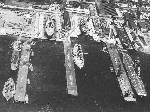 | 134k | Identifiable ships in this photo possibly at Puget Sound circa 1933 are, from left to right: U.S. Crane Ship No. 1 ex-Kearsarge (BB-5), & Seaplane Tender Jason (AV-2), one of the Colorado class (BB-45 / 48) battleships, [possibly the West Virginia (BB-48)] in the dry dock and a Pennsylvania class (BB-38 / 39) along the pier. The aircraft carrier in the photo is the Saratoga (CV-3) (note the "SARA" on the flight deck aft). | USN photo courtesy of Pieter Bakels. Photo & partial text I.d. courtesy of Chris Hoehn & David C. Nilsen. | ||||||||||||||||||||||||||||||||||||||||||||||||||||||||||||||||||||||||||||||||||||||||||||||||||||||||||||||||||||||||||||||||||||||||||||||||||||||||||||||||||||||||||||||||||||||||||||||||||||||||||||||||||||||||||||||||||||||||||||||||||||||||||||||||||||||||||||||||||||||||||||||||||||||||||||||||||||||||||||||||||||||||||||||||||||||||||||||||||||||||||||||||||||||||||||||||||||||||||||||||||||||||||||||||||||||||||
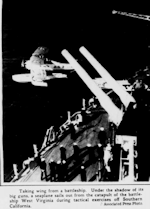 | 141k | Taking wing from a battleship. Under the shadow of its big guns, a seaplane sails out from the catapult of the battleship West Virginia (BB-48) during tactical exercises off Southern California. | Photo & text by Evening Star. [volume] (Washington, D.C.) 1854-1972, 12 November 1933, Image 91, courtesy of chroniclingamerica.loc.gov. | ||||||||||||||||||||||||||||||||||||||||||||||||||||||||||||||||||||||||||||||||||||||||||||||||||||||||||||||||||||||||||||||||||||||||||||||||||||||||||||||||||||||||||||||||||||||||||||||||||||||||||||||||||||||||||||||||||||||||||||||||||||||||||||||||||||||||||||||||||||||||||||||||||||||||||||||||||||||||||||||||||||||||||||||||||||||||||||||||||||||||||||||||||||||||||||||||||||||||||||||||||||||||||||||||||||||||||
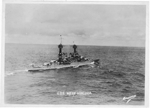 | 1.00k | West Virginia (BB-48). One good turn deserves another. | Photo courtesy of Tommy Trampp. | ||||||||||||||||||||||||||||||||||||||||||||||||||||||||||||||||||||||||||||||||||||||||||||||||||||||||||||||||||||||||||||||||||||||||||||||||||||||||||||||||||||||||||||||||||||||||||||||||||||||||||||||||||||||||||||||||||||||||||||||||||||||||||||||||||||||||||||||||||||||||||||||||||||||||||||||||||||||||||||||||||||||||||||||||||||||||||||||||||||||||||||||||||||||||||||||||||||||||||||||||||||||||||||||||||||||||||
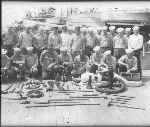 | 44k | Photo believed to be of a Damage Control party and the tools of their trade aboard the West Virginia (BB-48) during the 1930s. | USN photo courtesy of Pieter Bakels. | ||||||||||||||||||||||||||||||||||||||||||||||||||||||||||||||||||||||||||||||||||||||||||||||||||||||||||||||||||||||||||||||||||||||||||||||||||||||||||||||||||||||||||||||||||||||||||||||||||||||||||||||||||||||||||||||||||||||||||||||||||||||||||||||||||||||||||||||||||||||||||||||||||||||||||||||||||||||||||||||||||||||||||||||||||||||||||||||||||||||||||||||||||||||||||||||||||||||||||||||||||||||||||||||||||||||||||
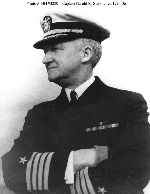 | 51k | Captain Harold R. Stark was the Commanding Officer of West Virginia (BB-48) from 1933 to 1934. Photograph taken circa 1926-34. | U.S. Naval Historical Center Photograph # NH 93280. Collection of Admiral Harold R. Stark. | ||||||||||||||||||||||||||||||||||||||||||||||||||||||||||||||||||||||||||||||||||||||||||||||||||||||||||||||||||||||||||||||||||||||||||||||||||||||||||||||||||||||||||||||||||||||||||||||||||||||||||||||||||||||||||||||||||||||||||||||||||||||||||||||||||||||||||||||||||||||||||||||||||||||||||||||||||||||||||||||||||||||||||||||||||||||||||||||||||||||||||||||||||||||||||||||||||||||||||||||||||||||||||||||||||||||||||
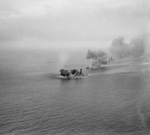 014801j | 2.32k | The West Virginia (BB-48) firing its long-range guns during battle practice, other battleships can be seen lined up behind her. | Possibly related to Los Angeles Times article, "Gunnery Record Reported Equaled by Battleship West Virginia (BB-48) as Squadron Returns; Feat Would Keep Trophy, Possible Victory Unparalleled; Official Merit of Each Ship to be Disclosed from Photographic Data."27 January 1934. A6. courtesy of digital.library.ucla.edu | ||||||||||||||||||||||||||||||||||||||||||||||||||||||||||||||||||||||||||||||||||||||||||||||||||||||||||||||||||||||||||||||||||||||||||||||||||||||||||||||||||||||||||||||||||||||||||||||||||||||||||||||||||||||||||||||||||||||||||||||||||||||||||||||||||||||||||||||||||||||||||||||||||||||||||||||||||||||||||||||||||||||||||||||||||||||||||||||||||||||||||||||||||||||||||||||||||||||||||||||||||||||||||||||||||||||||||
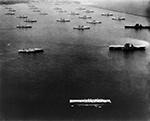 | 2.44k | Ships of the United States Fleet pictured at anchor inside the breakwater at Colon, Canal Zone, 1935. The carriers are, front to back, Langley (CV-1), Saratoga (CV-3) and Lexington (CV-2). The two battleships beyond Lexington are the New York (BB-34) with Texas (BB-35) behind. The nearest battleship, straight up from the Langley is Pennsylvania (BB-38). The BB immediately beyond and to the left of Pennsylvania (BB-38) is California (BB-44). The remaining battleships include two New Mexico's: Mississippi (BB-41) and Idaho (BB-42), but even this higher rez shot is not clear enough to tell which is which. Also are the rest of the "Big Five" and what is probably one of the Nevada's, but that is not certain. The photo is not clear enough for positive identifications. The cruisers to the left are three Northampton's (CA-26 / 31) and the two Pensacola's (CA-24 & 25) (the pair furthest from the camera) and six Omaha's. | Photo & text i.d. courtesy of Richard M. Jensen. Photo courtesy of National Naval Aviation Museum (NNAM) photo (# 1996.488.001.006) courtesy of Fabio Pena. | ||||||||||||||||||||||||||||||||||||||||||||||||||||||||||||||||||||||||||||||||||||||||||||||||||||||||||||||||||||||||||||||||||||||||||||||||||||||||||||||||||||||||||||||||||||||||||||||||||||||||||||||||||||||||||||||||||||||||||||||||||||||||||||||||||||||||||||||||||||||||||||||||||||||||||||||||||||||||||||||||||||||||||||||||||||||||||||||||||||||||||||||||||||||||||||||||||||||||||||||||||||||||||||||||||||||||||
 | 382k | The West Virginia (BB-48) sailing under the Brooklyn Bridge. | USN photo courtesy of Robert M. Cieri. | ||||||||||||||||||||||||||||||||||||||||||||||||||||||||||||||||||||||||||||||||||||||||||||||||||||||||||||||||||||||||||||||||||||||||||||||||||||||||||||||||||||||||||||||||||||||||||||||||||||||||||||||||||||||||||||||||||||||||||||||||||||||||||||||||||||||||||||||||||||||||||||||||||||||||||||||||||||||||||||||||||||||||||||||||||||||||||||||||||||||||||||||||||||||||||||||||||||||||||||||||||||||||||||||||||||||||||
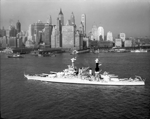 | 2.19k | West Virginia (BB-48) in New York on 31 May 1934. | USN photo courtesy of David Buell. | ||||||||||||||||||||||||||||||||||||||||||||||||||||||||||||||||||||||||||||||||||||||||||||||||||||||||||||||||||||||||||||||||||||||||||||||||||||||||||||||||||||||||||||||||||||||||||||||||||||||||||||||||||||||||||||||||||||||||||||||||||||||||||||||||||||||||||||||||||||||||||||||||||||||||||||||||||||||||||||||||||||||||||||||||||||||||||||||||||||||||||||||||||||||||||||||||||||||||||||||||||||||||||||||||||||||||||
 | 232k | Starboard side view, in San Francisco Harbor with the San Francisco - Oakland Bay Bridge being built, circa 1934. | Courtesy of Darryl L. Baker. | ||||||||||||||||||||||||||||||||||||||||||||||||||||||||||||||||||||||||||||||||||||||||||||||||||||||||||||||||||||||||||||||||||||||||||||||||||||||||||||||||||||||||||||||||||||||||||||||||||||||||||||||||||||||||||||||||||||||||||||||||||||||||||||||||||||||||||||||||||||||||||||||||||||||||||||||||||||||||||||||||||||||||||||||||||||||||||||||||||||||||||||||||||||||||||||||||||||||||||||||||||||||||||||||||||||||||||
 | 107k | The West Virginia (BB-48) underway in San Francisco sails past Alcatraz Island, circa. 1934. | Courtesy of Darryl L. Baker. | ||||||||||||||||||||||||||||||||||||||||||||||||||||||||||||||||||||||||||||||||||||||||||||||||||||||||||||||||||||||||||||||||||||||||||||||||||||||||||||||||||||||||||||||||||||||||||||||||||||||||||||||||||||||||||||||||||||||||||||||||||||||||||||||||||||||||||||||||||||||||||||||||||||||||||||||||||||||||||||||||||||||||||||||||||||||||||||||||||||||||||||||||||||||||||||||||||||||||||||||||||||||||||||||||||||||||||
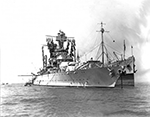 | 910k | West Virginia (BB-48) in Norfolk, Virginia taken about 1934, right after the "birdbath" was installed on the after control top. By 1935, her pilot house had been widened to 5 window panels across the front as opposed to the three across (as built) in the photo below. | Photo i.d. & text courtesy of Richard M. Jensen. Photo from The Virginian-Pilot Photograph Collection / SMC Photograph Collection from the Norfolk Public Library (Va.) | ||||||||||||||||||||||||||||||||||||||||||||||||||||||||||||||||||||||||||||||||||||||||||||||||||||||||||||||||||||||||||||||||||||||||||||||||||||||||||||||||||||||||||||||||||||||||||||||||||||||||||||||||||||||||||||||||||||||||||||||||||||||||||||||||||||||||||||||||||||||||||||||||||||||||||||||||||||||||||||||||||||||||||||||||||||||||||||||||||||||||||||||||||||||||||||||||||||||||||||||||||||||||||||||||||||||||||
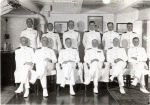 | 237k | West Virginia (BB-48) officers and CinCus staff pose in the officers' wardroom, circa 1934-36. Among those posing for the photo is future RADM Frederick J. Bell. At the time Bell was a LT serving as Flag Secretary and Operations Officer to VADM Thomas T. Craven, (first row, 3rd on the left, who looks remarkably like Admiral Husband E. Kimmel). When Craven returned to shore duty in 1935, Bell remained on the WV as Main Battery Assistant and Tactical Officer until 1936. Bell later went on to command the destroyer Grayson during the WW II, earning the Navy Cross during the Battle of the Eastern Solomons in August 1942. Bell is in the back row, extreme right. | From the estate of RADM Frederick J. Bell. Submitted by Tom Lane. | ||||||||||||||||||||||||||||||||||||||||||||||||||||||||||||||||||||||||||||||||||||||||||||||||||||||||||||||||||||||||||||||||||||||||||||||||||||||||||||||||||||||||||||||||||||||||||||||||||||||||||||||||||||||||||||||||||||||||||||||||||||||||||||||||||||||||||||||||||||||||||||||||||||||||||||||||||||||||||||||||||||||||||||||||||||||||||||||||||||||||||||||||||||||||||||||||||||||||||||||||||||||||||||||||||||||||||
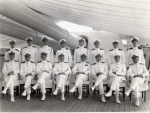 | 223k | West Virginia (BB-48) officers and CinCus staff pose under one of the ship's 16"/45 gun turrets, circa 1934-36. Among those posing for the photo is future RADM Frederick J. Bell, in the back row, 3rd from right. | From the estate of RADM Frederick J. Bell. Submitted by Tom Lane. | ||||||||||||||||||||||||||||||||||||||||||||||||||||||||||||||||||||||||||||||||||||||||||||||||||||||||||||||||||||||||||||||||||||||||||||||||||||||||||||||||||||||||||||||||||||||||||||||||||||||||||||||||||||||||||||||||||||||||||||||||||||||||||||||||||||||||||||||||||||||||||||||||||||||||||||||||||||||||||||||||||||||||||||||||||||||||||||||||||||||||||||||||||||||||||||||||||||||||||||||||||||||||||||||||||||||||||
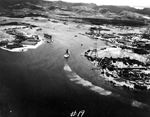 | 589k | Aerial view of Pearl Harbor on 25 May 1935 showing the West Virginia (BB-48) making a turn at Hospital Point. The Langley (CV-1) is moored at Ford Island. | US Navy and Marine Corps Museum/Naval Aviation Museum, Photo No.1996.488.029.001 via Mike Green. | ||||||||||||||||||||||||||||||||||||||||||||||||||||||||||||||||||||||||||||||||||||||||||||||||||||||||||||||||||||||||||||||||||||||||||||||||||||||||||||||||||||||||||||||||||||||||||||||||||||||||||||||||||||||||||||||||||||||||||||||||||||||||||||||||||||||||||||||||||||||||||||||||||||||||||||||||||||||||||||||||||||||||||||||||||||||||||||||||||||||||||||||||||||||||||||||||||||||||||||||||||||||||||||||||||||||||||
 | 274k | US Navy battleships in parade formation in San Diego, California, 23 August 1935. Pennsylvania (BB-38) in the lead followed by West Virginia (BB-48), Colorado (BB-45), Maryland (BB-46), California (BB-44) and Texas (BB-35). The ship behind the Texas appears to be the New York (BB-34). You can see a shadow on the forward fighting top consistent with the forward-facing bathtub that New York had, plus you can barely make out the double turrets. | Photo i.d. courtesy of Richard Jensen with an assit from Richard McSlick. USN photo # 80-G-462946 from the National Museum of the U.S. Navy via flickr.com. | ||||||||||||||||||||||||||||||||||||||||||||||||||||||||||||||||||||||||||||||||||||||||||||||||||||||||||||||||||||||||||||||||||||||||||||||||||||||||||||||||||||||||||||||||||||||||||||||||||||||||||||||||||||||||||||||||||||||||||||||||||||||||||||||||||||||||||||||||||||||||||||||||||||||||||||||||||||||||||||||||||||||||||||||||||||||||||||||||||||||||||||||||||||||||||||||||||||||||||||||||||||||||||||||||||||||||||
 | 248k | The West Virginia (BB-48) in a 1935 photo of the ship's 4th division. The author's father is in the first row, 6th photo. | From the collection of Capt. TC Edrington III PhD, USN - Courtesy daughter Kyra Larn and son Thomas C. IV. | ||||||||||||||||||||||||||||||||||||||||||||||||||||||||||||||||||||||||||||||||||||||||||||||||||||||||||||||||||||||||||||||||||||||||||||||||||||||||||||||||||||||||||||||||||||||||||||||||||||||||||||||||||||||||||||||||||||||||||||||||||||||||||||||||||||||||||||||||||||||||||||||||||||||||||||||||||||||||||||||||||||||||||||||||||||||||||||||||||||||||||||||||||||||||||||||||||||||||||||||||||||||||||||||||||||||||||
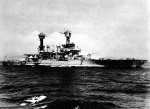 | 351k | October 1935, starboard view, with the Hawaiian mountains in the background. | USN photo submitted by Ron Titus, courtesy of Ingersoll-Rand. Corp. Photo i.d. courtesy of Jesse P. Mannix. | ||||||||||||||||||||||||||||||||||||||||||||||||||||||||||||||||||||||||||||||||||||||||||||||||||||||||||||||||||||||||||||||||||||||||||||||||||||||||||||||||||||||||||||||||||||||||||||||||||||||||||||||||||||||||||||||||||||||||||||||||||||||||||||||||||||||||||||||||||||||||||||||||||||||||||||||||||||||||||||||||||||||||||||||||||||||||||||||||||||||||||||||||||||||||||||||||||||||||||||||||||||||||||||||||||||||||||
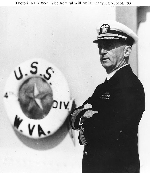 | 47k | Vice Admiral William D. Leahy, USN,Commander, Battleships, Battle Force, U.S. Fleet on board his flagship, West Virginia (BB-48), off Long Beach, California, September 1935. | U.S. Naval Historical Center Photograph # NH 49862. Collection of Fleet Admiral William D. Leahy, USN. Photo submitted by Bill Gonyo. | ||||||||||||||||||||||||||||||||||||||||||||||||||||||||||||||||||||||||||||||||||||||||||||||||||||||||||||||||||||||||||||||||||||||||||||||||||||||||||||||||||||||||||||||||||||||||||||||||||||||||||||||||||||||||||||||||||||||||||||||||||||||||||||||||||||||||||||||||||||||||||||||||||||||||||||||||||||||||||||||||||||||||||||||||||||||||||||||||||||||||||||||||||||||||||||||||||||||||||||||||||||||||||||||||||||||||||
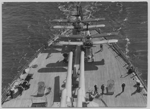 014801g | 568k | Fan Tail of West Virginia (BB-48), 1936. | Photo courtesy of usswv.lib.wvu.edu. Photo courtesy of Daniel Hacker. |
||||||||||||||||||||||||||||||||||||||||||||||||||||||||||||||||||||||||||||||||||||||||||||||||||||||||||||||||||||||||||||||||||||||||||||||||||||||||||||||||||||||||||||||||||||||||||||||||||||||||||||||||||||||||||||||||||||||||||||||||||||||||||||||||||||||||||||||||||||||||||||||||||||||||||||||||||||||||||||||||||||||||||||||||||||||||||||||||||||||||||||||||||||||||||||||||||||||||||||||||||||||||||||||||||||||||||
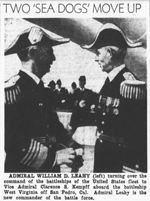 014886 | 1.08k | TWO 'SEA DOGS' MOVE UP ADMIRAL WILLIAM D. LEAHY (left) turning over the command of the battleships of the United States fleet to Vice Admiral Clarence S. Kempff aboard the battleship West Virginia (BB-48) off San Pedro, Cal. Admiral Leahy is the new commander of the battle force. | Image and text provided by Library of Congress, Washington, DC. via The Washington Times. [volume] (Washington [D.C.]) 1902-1939, 02 April 1936, Image 8, courtesy of chroniclingamerica.loc.gov. | ||||||||||||||||||||||||||||||||||||||||||||||||||||||||||||||||||||||||||||||||||||||||||||||||||||||||||||||||||||||||||||||||||||||||||||||||||||||||||||||||||||||||||||||||||||||||||||||||||||||||||||||||||||||||||||||||||||||||||||||||||||||||||||||||||||||||||||||||||||||||||||||||||||||||||||||||||||||||||||||||||||||||||||||||||||||||||||||||||||||||||||||||||||||||||||||||||||||||||||||||||||||||||||||||||||||||||
 | 1.80k | 1936 photo of Battleship Row, Pearl Harbor. Among the ships in the harbor are: Front and center a Northampton class CA, most likely the Chester (CA-27). The two New Orleans (CA-32) class cruisers on the far left are the Minneapolis (CA-36) nearer the camera with New Orleans (CA-32) behind. Both have the curved-faced turrets, limiting them to the CA-32/34/36 group. Within that group, only New Orleans lacked the glassed-in navigation bridge (below the pilothouse), and minor superstructure variations point to the other being Minneapolis rather than Astoria (CA-34). The battleships from left to right: Colorado (BB-45), or West Virginia (BB-48), outboard of Idaho (BB-42), Nevada (BB-36), outboard of Mississippi (BB-41), New Mexico (BB-40), outboard of Maryland (BB-46) or California (BB-44). On the far right is the Hospital ship Relief (AH-1) with two unidentified ships ahead and to her port side. | Text courtesy of David Johnston, (USNR), Aryeh Wetherhorn (USNR) & Richard Jensen. Photo courtesy of Edward Cwalinski, submitted by Barry Litchfield. | ||||||||||||||||||||||||||||||||||||||||||||||||||||||||||||||||||||||||||||||||||||||||||||||||||||||||||||||||||||||||||||||||||||||||||||||||||||||||||||||||||||||||||||||||||||||||||||||||||||||||||||||||||||||||||||||||||||||||||||||||||||||||||||||||||||||||||||||||||||||||||||||||||||||||||||||||||||||||||||||||||||||||||||||||||||||||||||||||||||||||||||||||||||||||||||||||||||||||||||||||||||||||||||||||||||||||||
 014801e | 419k | Stern view of the West Virginia (BB-48) in Dry Dock at Navy Yard, Bremerton, Wa., circa 1936-37. | Photo courtesy of usswv.lib.wvu.edu. Photo courtesy of Daniel Hacker. | ||||||||||||||||||||||||||||||||||||||||||||||||||||||||||||||||||||||||||||||||||||||||||||||||||||||||||||||||||||||||||||||||||||||||||||||||||||||||||||||||||||||||||||||||||||||||||||||||||||||||||||||||||||||||||||||||||||||||||||||||||||||||||||||||||||||||||||||||||||||||||||||||||||||||||||||||||||||||||||||||||||||||||||||||||||||||||||||||||||||||||||||||||||||||||||||||||||||||||||||||||||||||||||||||||||||||||
 014822 | 528k | Workers adjusting West Virginia (BB-48) propellers, circa 1936-1937. | Photo courtesy of usswv.lib.wvu.edu. Photo courtesy of Daniel Hacker. | ||||||||||||||||||||||||||||||||||||||||||||||||||||||||||||||||||||||||||||||||||||||||||||||||||||||||||||||||||||||||||||||||||||||||||||||||||||||||||||||||||||||||||||||||||||||||||||||||||||||||||||||||||||||||||||||||||||||||||||||||||||||||||||||||||||||||||||||||||||||||||||||||||||||||||||||||||||||||||||||||||||||||||||||||||||||||||||||||||||||||||||||||||||||||||||||||||||||||||||||||||||||||||||||||||||||||||
 014839 | 451k | Captain W. R. Furlong on the Navigation Bridge of the West Virginia (BB-48), 1937. | Photo courtesy of usswv.lib.wvu.edu. Photo courtesy of Daniel Hacker. | ||||||||||||||||||||||||||||||||||||||||||||||||||||||||||||||||||||||||||||||||||||||||||||||||||||||||||||||||||||||||||||||||||||||||||||||||||||||||||||||||||||||||||||||||||||||||||||||||||||||||||||||||||||||||||||||||||||||||||||||||||||||||||||||||||||||||||||||||||||||||||||||||||||||||||||||||||||||||||||||||||||||||||||||||||||||||||||||||||||||||||||||||||||||||||||||||||||||||||||||||||||||||||||||||||||||||||
 014848 | 435k | Looking up at the mast from the ship's deck., circa 1936-1937. | Photo courtesy of usswv.lib.wvu.edu. Photo courtesy of Daniel Hacker. | ||||||||||||||||||||||||||||||||||||||||||||||||||||||||||||||||||||||||||||||||||||||||||||||||||||||||||||||||||||||||||||||||||||||||||||||||||||||||||||||||||||||||||||||||||||||||||||||||||||||||||||||||||||||||||||||||||||||||||||||||||||||||||||||||||||||||||||||||||||||||||||||||||||||||||||||||||||||||||||||||||||||||||||||||||||||||||||||||||||||||||||||||||||||||||||||||||||||||||||||||||||||||||||||||||||||||||
 014839g | 505k | Officers Transported on Motor Boats to the West Virginia (BB-48), 1936, | Photo courtesy of usswv.lib.wvu.edu. Photo courtesy of Daniel Hacker. | ||||||||||||||||||||||||||||||||||||||||||||||||||||||||||||||||||||||||||||||||||||||||||||||||||||||||||||||||||||||||||||||||||||||||||||||||||||||||||||||||||||||||||||||||||||||||||||||||||||||||||||||||||||||||||||||||||||||||||||||||||||||||||||||||||||||||||||||||||||||||||||||||||||||||||||||||||||||||||||||||||||||||||||||||||||||||||||||||||||||||||||||||||||||||||||||||||||||||||||||||||||||||||||||||||||||||||
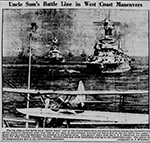 | NR | Uncle Sam's Battle Line in West Coast Maneuvers. The big ships of the battle force, "power house" unit of the United States Navy, are shown in column line during the maneuvers off the Southern California coast that took in four days of concentrated scouting and battle drill to test the fleet's new organization plan by which the destroyers are attached to the battle force. This picture, taken from the California (BB-44), the flagship, shows the West Virginia (BB-48), Colorado (BB-45), Arizona (BB-39), Pennsylvania (BB-38) and other battleships trailing in the California's wake. The planes in the foreground are part of the California's complement. | Image and text provided by Library of Congress, Washington, DC. Photo & text by Evening Star. [volume] (Washington, D.C.) 1854-1972, 09 October 1937, Image 2, courtesy of chroniclingamerica.loc.gov. |
||||||||||||||||||||||||||||||||||||||||||||||||||||||||||||||||||||||||||||||||||||||||||||||||||||||||||||||||||||||||||||||||||||||||||||||||||||||||||||||||||||||||||||||||||||||||||||||||||||||||||||||||||||||||||||||||||||||||||||||||||||||||||||||||||||||||||||||||||||||||||||||||||||||||||||||||||||||||||||||||||||||||||||||||||||||||||||||||||||||||||||||||||||||||||||||||||||||||||||||||||||||||||||||||||||||||||
 | 1.10k | Heaving homeward-painting by R.C. Patterson. The West Virginia (BB-48) is shown leading a column in staggered formation. February 1938. | USNI photo courtesy of Pieter Bakels. | ||||||||||||||||||||||||||||||||||||||||||||||||||||||||||||||||||||||||||||||||||||||||||||||||||||||||||||||||||||||||||||||||||||||||||||||||||||||||||||||||||||||||||||||||||||||||||||||||||||||||||||||||||||||||||||||||||||||||||||||||||||||||||||||||||||||||||||||||||||||||||||||||||||||||||||||||||||||||||||||||||||||||||||||||||||||||||||||||||||||||||||||||||||||||||||||||||||||||||||||||||||||||||||||||||||||||||
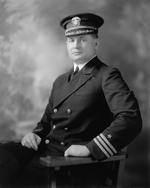 | 87k | Captain Henry Martin Jensen was the Commanding Officer of the battleship West Virginia (BB-48) from 14 May 1938 to 5 January 1940. | USN photo courtesy of Bill Gonyo. | ||||||||||||||||||||||||||||||||||||||||||||||||||||||||||||||||||||||||||||||||||||||||||||||||||||||||||||||||||||||||||||||||||||||||||||||||||||||||||||||||||||||||||||||||||||||||||||||||||||||||||||||||||||||||||||||||||||||||||||||||||||||||||||||||||||||||||||||||||||||||||||||||||||||||||||||||||||||||||||||||||||||||||||||||||||||||||||||||||||||||||||||||||||||||||||||||||||||||||||||||||||||||||||||||||||||||||
 | 450k | Oil on canvas painting by the artist Wayne Scarpaci showing The West Virginia (BB-48) leading the Battlefleet into San Francisco Bay in 1939. The piece is entitled "Pacific Battleline". | The painting is form the collection of Sterling Supply Co Huntington WV artbywayne.com | ||||||||||||||||||||||||||||||||||||||||||||||||||||||||||||||||||||||||||||||||||||||||||||||||||||||||||||||||||||||||||||||||||||||||||||||||||||||||||||||||||||||||||||||||||||||||||||||||||||||||||||||||||||||||||||||||||||||||||||||||||||||||||||||||||||||||||||||||||||||||||||||||||||||||||||||||||||||||||||||||||||||||||||||||||||||||||||||||||||||||||||||||||||||||||||||||||||||||||||||||||||||||||||||||||||||||||
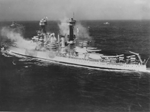 | 726k | The crew of the West Virginia (BB-48) line the rails during exercises in 1939. In the background are a heavy cruiser of the Pensacola (CA-24) class, a 4 stack destroyer and a smaller craft. | USN photo # 80-G-466161 courtesy of interwarnavy.org via Bill Gonyo. | ||||||||||||||||||||||||||||||||||||||||||||||||||||||||||||||||||||||||||||||||||||||||||||||||||||||||||||||||||||||||||||||||||||||||||||||||||||||||||||||||||||||||||||||||||||||||||||||||||||||||||||||||||||||||||||||||||||||||||||||||||||||||||||||||||||||||||||||||||||||||||||||||||||||||||||||||||||||||||||||||||||||||||||||||||||||||||||||||||||||||||||||||||||||||||||||||||||||||||||||||||||||||||||||||||||||||||
 | 119k | Pennsylvania (BB-38) & or Colorado (BB-45), Maryland (BB-46) & or West Virginia (BB-48) at 1010 dock sometime after returning to Pearl Harbor, circa 1939-40. | USN photo by Albert Weigandt & submitted by James D. Card, QMCS (SW/AW). Partial text courtesy of DANFS. Photo i.d. courtesy of Tom Bateman. | ||||||||||||||||||||||||||||||||||||||||||||||||||||||||||||||||||||||||||||||||||||||||||||||||||||||||||||||||||||||||||||||||||||||||||||||||||||||||||||||||||||||||||||||||||||||||||||||||||||||||||||||||||||||||||||||||||||||||||||||||||||||||||||||||||||||||||||||||||||||||||||||||||||||||||||||||||||||||||||||||||||||||||||||||||||||||||||||||||||||||||||||||||||||||||||||||||||||||||||||||||||||||||||||||||||||||||
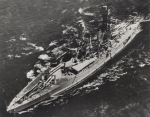 | 250k | Aerial view underway, 9 February 1939. | National Archives Photograph # 80-G-466161. | ||||||||||||||||||||||||||||||||||||||||||||||||||||||||||||||||||||||||||||||||||||||||||||||||||||||||||||||||||||||||||||||||||||||||||||||||||||||||||||||||||||||||||||||||||||||||||||||||||||||||||||||||||||||||||||||||||||||||||||||||||||||||||||||||||||||||||||||||||||||||||||||||||||||||||||||||||||||||||||||||||||||||||||||||||||||||||||||||||||||||||||||||||||||||||||||||||||||||||||||||||||||||||||||||||||||||||
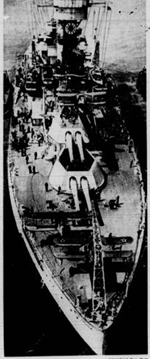 014801 | NR | California Bound With a cracked 16-inch rifle replaced at the Brooklyn Navy Yard, the battleship West Virginia (BB-48) sails for California to join rest of fleet. The ship was among those suddenly ordered to leave New York harbor following President Roosevelt’s letter to Hitler and Mussolini. |
Image and text provided by University of North Carolina at Chapel Hill Library, Chapel Hill, NC. Photo from Henderson Daily Dispatch. (Henderson, N.C.) 1914-1995, 26 April 1939, Image 6, via chroniclingamerica.loc.gov. |
||||||||||||||||||||||||||||||||||||||||||||||||||||||||||||||||||||||||||||||||||||||||||||||||||||||||||||||||||||||||||||||||||||||||||||||||||||||||||||||||||||||||||||||||||||||||||||||||||||||||||||||||||||||||||||||||||||||||||||||||||||||||||||||||||||||||||||||||||||||||||||||||||||||||||||||||||||||||||||||||||||||||||||||||||||||||||||||||||||||||||||||||||||||||||||||||||||||||||||||||||||||||||||||||||||||||||
 | 281k | Late 1930's - early 1940 photo of the West Virginia (BB-48) by George Winstead. | USN photo courtesy of Robert M. Cieri. | ||||||||||||||||||||||||||||||||||||||||||||||||||||||||||||||||||||||||||||||||||||||||||||||||||||||||||||||||||||||||||||||||||||||||||||||||||||||||||||||||||||||||||||||||||||||||||||||||||||||||||||||||||||||||||||||||||||||||||||||||||||||||||||||||||||||||||||||||||||||||||||||||||||||||||||||||||||||||||||||||||||||||||||||||||||||||||||||||||||||||||||||||||||||||||||||||||||||||||||||||||||||||||||||||||||||||||
 014801n | 418k | Diver off West Virginia (BB-48), circa 1940. | Photo courtesy of usswv.lib.wvu.edu. Photo courtesy of Daniel Hacker. | ||||||||||||||||||||||||||||||||||||||||||||||||||||||||||||||||||||||||||||||||||||||||||||||||||||||||||||||||||||||||||||||||||||||||||||||||||||||||||||||||||||||||||||||||||||||||||||||||||||||||||||||||||||||||||||||||||||||||||||||||||||||||||||||||||||||||||||||||||||||||||||||||||||||||||||||||||||||||||||||||||||||||||||||||||||||||||||||||||||||||||||||||||||||||||||||||||||||||||||||||||||||||||||||||||||||||||
 | 163k | Off to the races as the crew of the West Virginia (BB-48) compete during maneuvers in Hawaii in 1940. | Photographer: Carl Mydans, courtesy of time.com. via Life. | ||||||||||||||||||||||||||||||||||||||||||||||||||||||||||||||||||||||||||||||||||||||||||||||||||||||||||||||||||||||||||||||||||||||||||||||||||||||||||||||||||||||||||||||||||||||||||||||||||||||||||||||||||||||||||||||||||||||||||||||||||||||||||||||||||||||||||||||||||||||||||||||||||||||||||||||||||||||||||||||||||||||||||||||||||||||||||||||||||||||||||||||||||||||||||||||||||||||||||||||||||||||||||||||||||||||||||
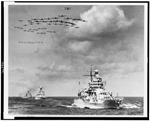 | 463k | Probable front and rear photos here and below showing formations of aircraft flying over U.S. Navy battleships during exercises at sea, 1938 / 1939. Pictured here is the New Mexico (BB-40) in the van with other battleships of the Pacific Fleet and a carrier air group, led by the Air Group Commander in a Curtiss SBC Helldiver. The aircraft following are: A torpedo squadron of eighteen Douglas TBD-1s; A bombing squadron of eighteen Northrop BT-1s; A scouting squadron eighteen Curtiss SBCs; A fighting squadron of eighteen Grumman F2F-1s or F3F-3s from either the Yorktown (CV-5) or F3F-2s from the Enterprise (CV-6), plus possibly nine additional aircraft. The Yorktown and Enterprise were the only two carriers whose bombing squadrons were equipped with the Northrop BT-1. The text for the photo reads: "The Navy uses enormous amounts of rubber. At least seventy-five tons of rubber, enough to makes 17,000 tires, are used in the construction of each of these battleships. Tons more are needed for the naval planes that are making history over the world. Medical and communication requirements--and countless other needs of the Navy--are met." The lead BB looks like Mississippi (BB-41) followed by Maryland (BB-46) (rangefinder on Turret II). My first impression of the Tennessee class (BB-43 /44) is the Tennessee (BB-43), but that is not a certain ID from this photo alone. Fourth is the Oklahoma (BB-37) (no birdbath). Aside from the DD now in the lead, I see nothing in the head-on shot aerial that positively differs from the ID's of the first 4 BB's in the first photo. Of course, in the aft aerial shot, BB #5 is the California (BB-44), ID'd by the enlarged flag bridge, lending support to BB #3 in the first photo being Tennessee. Everything I see supports these three photos all being part of the same operation with at least the first 5 BB's remaining in the same order. |
Photograph # LC-USE64 - DC-000944 & partial text courtesy of memory.loc.gov. Battleship i.d. & text courtesy of Richard Jensen. Aircraft i.d. & text & timeline courtesy of Alan Moore via the following sources: Airplane i.d.: Yorktown Class Carriers (Warship Pictorial No. 9) by Steve Wiper, Tucson, AZ: Classic Warships Publishing, 2000. & That Gallant Ship: U.S.S. Yorktown (CV-5) by Robert Cressman, Missoula, MT: Pictorial Histories Pub Co, 1985. Timeline from Battleship Arizona: An Illustrated History by Paul Stillwell, Annapolis, MD: Naval Institute Press, 1991. |
||||||||||||||||||||||||||||||||||||||||||||||||||||||||||||||||||||||||||||||||||||||||||||||||||||||||||||||||||||||||||||||||||||||||||||||||||||||||||||||||||||||||||||||||||||||||||||||||||||||||||||||||||||||||||||||||||||||||||||||||||||||||||||||||||||||||||||||||||||||||||||||||||||||||||||||||||||||||||||||||||||||||||||||||||||||||||||||||||||||||||||||||||||||||||||||||||||||||||||||||||||||||||||||||||||||||||
 | 1.62k | Probable front and rear photos here and above showing formations of aircraft flying over U.S. Navy battleships during exercises at sea, 1938 / 1939. New Mexico (BB-40) is leading the BB column while the remaining battleships have dual masthead fire control structures. The air group formation in the two photos appears to be similar. The composition of 18 TBDs, 18 BT-1s, 18 SBCs, and 27 fighters is easier to distinguish in the front/surface view. I'm assuming, based on total aircraft count alone, that the formation in the rear/aerial view is the same. (The perspective makes it difficult to sort the monoplanes and biplanes into their respective types.) The only difference is that in the front/surface view the formation is lead by a Curtiss SBC Helldiver (likely the Air Group Commander) but in the rear/aerial view that lead Helldiver is not present. I suppose it's possible that the photographer was in that Helldiver's rear seat. What stands out for me is the presence of nine extra fighters beyond the normal squadron composition of 18, as seen in the other three squadrons in this formation. | Photo i.d courtesy of Chuck Haberlein, Richard Jensen, Aryeh Wetherhorn, & Tracy White @ Researcher @ Large. Battleship i.d. & text courtesy of Richard Jensen. Aircraft i.d. & text courtesy of Alan Moore. US Navy and Marine Corps Museum/Naval Aviation Museum, photo No. 2008.104.001.234. | ||||||||||||||||||||||||||||||||||||||||||||||||||||||||||||||||||||||||||||||||||||||||||||||||||||||||||||||||||||||||||||||||||||||||||||||||||||||||||||||||||||||||||||||||||||||||||||||||||||||||||||||||||||||||||||||||||||||||||||||||||||||||||||||||||||||||||||||||||||||||||||||||||||||||||||||||||||||||||||||||||||||||||||||||||||||||||||||||||||||||||||||||||||||||||||||||||||||||||||||||||||||||||||||||||||||||||
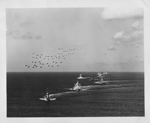 | 1.31k | Between 9 & 13 September 1940 the Arizona (BB-39) was under way with other ships of the US Fleet for simulated fleet engagement. She is pictured here in company with other ships of the Pacific Fleet taken during Fleet Ops. and at least one carrier air group. | US Navy and Marine Corps Museum/Naval Aviation Museum, Photo No. 2008.104.001.235 courtesy of Alan Moore. Text & photo i.d. courtesy of Alan Moore via Battleship Arizona: An Illustrated History by Paul Stillwell, Annapolis, MD: Naval Institute Press, 1991. | ||||||||||||||||||||||||||||||||||||||||||||||||||||||||||||||||||||||||||||||||||||||||||||||||||||||||||||||||||||||||||||||||||||||||||||||||||||||||||||||||||||||||||||||||||||||||||||||||||||||||||||||||||||||||||||||||||||||||||||||||||||||||||||||||||||||||||||||||||||||||||||||||||||||||||||||||||||||||||||||||||||||||||||||||||||||||||||||||||||||||||||||||||||||||||||||||||||||||||||||||||||||||||||||||||||||||||
 | 367k | Column Right! Arizona (BB-39), New Mexico (BB-40) & West Virginia (BB-48) and other ships of the Pacific Fleet taken during Fleet Ops in October 1940. This photo is more than likely from the LIFE issue of 28 October 1940: "The Navy: LIFE Goes into Action with the U.S. Fleet". One of the introductory paragraphs reads as follows: "To show itself to the American people, the U.S. Navy has co-operated with LIFE in this issue. LIFE photographers and reporters examined naval schools, ammunition depots, bases, destroyers, battleships, the War College, etc. Finally a LIFE crew sailed on the U.S. Fleet maneuvers last month off Pearl Harbor in mid-Pacific." | US Navy and Marine Corps Museum/Naval Aviation Museum, Photo No. 2008.104.001.235 courtesy of Alan Moore. Text & photo i.d. courtesy of Alan Moore via Battleship Arizona: An Illustrated History by Paul Stillwell, Annapolis, MD: Naval Institute Press, 1991 & "The Navy: LIFE Goes into Action with the U.S. Fleet". Life. New York: Time, Inc., Vol 9 No 18 (28 October 1940). p23. | ||||||||||||||||||||||||||||||||||||||||||||||||||||||||||||||||||||||||||||||||||||||||||||||||||||||||||||||||||||||||||||||||||||||||||||||||||||||||||||||||||||||||||||||||||||||||||||||||||||||||||||||||||||||||||||||||||||||||||||||||||||||||||||||||||||||||||||||||||||||||||||||||||||||||||||||||||||||||||||||||||||||||||||||||||||||||||||||||||||||||||||||||||||||||||||||||||||||||||||||||||||||||||||||||||||||||||
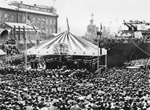 | 124k | The band strikes up a tune to "Help put their hands together" to Buy Bonds. The West Virginia (BB-48) and other elements of the Pacific Fleet are up close and personal in this pre war photo. | USN photo courtesy of Scott Koen & ussnewyork.com | ||||||||||||||||||||||||||||||||||||||||||||||||||||||||||||||||||||||||||||||||||||||||||||||||||||||||||||||||||||||||||||||||||||||||||||||||||||||||||||||||||||||||||||||||||||||||||||||||||||||||||||||||||||||||||||||||||||||||||||||||||||||||||||||||||||||||||||||||||||||||||||||||||||||||||||||||||||||||||||||||||||||||||||||||||||||||||||||||||||||||||||||||||||||||||||||||||||||||||||||||||||||||||||||||||||||||||
 | 445k | Cut out of the Colorado class (BB-45) as of December 1941. | Drawn by Edward H Wiswesser; 1/10 scale. Photo courtesy of Tommy Trampp. | ||||||||||||||||||||||||||||||||||||||||||||||||||||||||||||||||||||||||||||||||||||||||||||||||||||||||||||||||||||||||||||||||||||||||||||||||||||||||||||||||||||||||||||||||||||||||||||||||||||||||||||||||||||||||||||||||||||||||||||||||||||||||||||||||||||||||||||||||||||||||||||||||||||||||||||||||||||||||||||||||||||||||||||||||||||||||||||||||||||||||||||||||||||||||||||||||||||||||||||||||||||||||||||||||||||||||||
| Attack on Pearl Harbor |
|||||||||||||||||||||||||||||||||||||||||||||||||||||||||||||||||||||||||||||||||||||||||||||||||||||||||||||||||||||||||||||||||||||||||||||||||||||||||||||||||||||||||||||||||||||||||||||||||||||||||||||||||||||||||||||||||||||||||||||||||||||||||||||||||||||||||||||||||||||||||||||||||||||||||||||||||||||||||||||||||||||||||||||||||||||||||||||||||||||||||||||||||||||||||||||||||||||||||||||||||||||||||||||||||||||||||||||
 |
2.94k | Japanese Attack on Pearl Harbor, 7 December 1941. Imperial Japanese Navy aircraft carriers in dawn fly-off for Pearl Harbor. | Artwork by John Hamilton from his publication, "War at Sea," pg. 68-69. USN photo # 80-142-H, courtesy of the U.S. Navy Art Gallery from the National Museum of the U.S. Navy, courtesy of flickr.com. 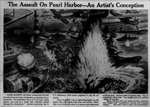 014325 NR |
The Assault On Pearl Harbor—An Artist's Conception |
HANK BARROW, AP artist, reconstructs the battle at Pearl Harbor from information provided by Secretary Knox. One battleship, the Arizona (BB-39), (right center), was sunk by a bomb that "literally passed through the smokestack." Another battleship, the Oklahoma (BB-37), (left center,capsized. It can be repaired. Three destroyers (one in right foreground), an old target ship, and a mine layer also went down. Other ships were damaged, many U. S. planes were destroyed on the ground. Almost 2,900 servicemen died The attackers lost three subs (one midget sub is at extreme right) & 41 aircraft. Knox said that after the initial surprise, American men fought with "magnificent courage and resourcefulness. The men's will to resist was tremendous... Image and text provided by University of Florida. | Photo from The Key West Citizen. [volume] (Key West, Fla.) 1879-current, 22 December 1941, Image 1, via chroniclingamerica.loc.gov. 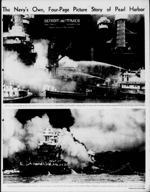 014316s 2.14k |
The Navy's Own, Four-Page Picture Story of Pearl Harbor |
Old Glory flying proudly in one of her darkest hours and over sailors at Pearl Harbor last 7 December risking their lives close up to the bomb-set flames roaring from both West Virginia (BB-48) and Tennessee (BB-43). Slightly-damaged 31,000-ton Maryland (BB-46) (first battleship to rejoin the fleet after repairs) in Pearl Harbor's flames. Behind her is another battleship, at right the capsized battleship Oklahoma (BB-37). Image and text provided by Central Michigan University, Clark Historical Library. | Photo from Detroit Evening Times. (Detroit, Mich) 1921-1958, 06 December 1942, FINAL, Images 21, 22, 23, & 24, via chroniclingamerica.loc.gov.  1.67k |
Battleship row in flames. |
Artwork by John Hamilton from his publication, "War at Sea," pg. 74-75. | USN photo # 80-142-I, courtesy of the U.S. Navy Art Gallery from the National Museum of the U.S. Navy, courtesy of flickr.com. 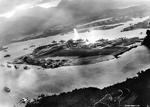 399k |
Photograph taken from a Japanese plane during the torpedo attack on ships moored on both sides of Ford Island shortly after the beginning of the Pearl Harbor attack. View looks about east, with the supply depot, submarine base and fuel tank farm in the right center distance. A torpedo has just hit West Virginia (BB-48) on the far side of Ford Island (center). Other battleships moored nearby are (from left): Nevada (BB-36), Arizona (BB-39), Tennessee (BB-43) (inboard of West Virginia), Oklahoma (BB-37) (torpedoed and listing) alongside Maryland (BB-46), and California (BB-44). On the near side of Ford Island, to the left, are light cruisers Detroit (CL-8) and Raleigh (CL-7), target and training ship Utah (AG-16) and seaplane tender Tangier (AV-8). Raleigh and Utah have been torpedoed, and Utah is listing sharply to port. Japanese planes are visible in the right center (over Ford Island) and over the Navy Yard at right. U.S. Navy planes on the seaplane ramp are on fire. Japanese writing in the lower right states that the photograph was reproduced by authorization of the Navy Ministry. |
Text courtesy of wikipedia.com. | Official USN photograph NH 50930. 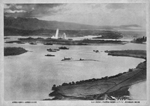 3.42k |
The Oklahoma (BB-37) & West Virginia (BB-48) take their initial torpedo hits on 7 December. |
Photo courtesy of Arnold Putnam. |
 1.16k |
The Oklahoma (BB-37) & West Virginia (BB-48) take their initial torpedo hits on 7 December. |
Photo courtesy of Arnold Putnam. |
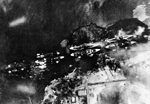 3.95k |
Vertical aerial view of "Battleship Row", beside Ford Island, during the early part of the horizontal bombing attack on the ships moored there. Photographed from a Japanese aircraft. Ships seen are (from left to right): Nevada (BB-36), Arizona (BB-39) with Vestal (AR-4) moored outboard; Tennessee (BB-43) with West Virginia (BB-48) moored outboard; Maryland (BB-46) with Oklahoma (BB-37) moored outboard; and Neosho (AO-23), only partially visible at the extreme right. A bomb has just hit Arizona near the stern, but she has not yet received the bomb that detonated her forward magazines. West Virginia and Oklahoma are gushing oil from their many torpedo hits and are listing to port. Oklahoma's port deck edge is already under water. Nevada has also been torpedoed. |
Japanese inscription in lower left states that the photograph has been officially released by the Navy Ministry. Also at NHHC as NH 50472. From the translated Japanese caption, "Alas, the spectacle of the American battleship Fleet in its Dying Gasp. The attack of our assault force was extremely accurate and achieved direct hits with all bombs. The leading ship of the Oklahoma Class is already half sunk. The Maryland type and the Pennsylvania type are blowing up from several direct hits. The ships crumble and their hulls are twisted and keeling over. Crude oil gushes forth fearfully. This view of the wretched enemy's capital ships which were converted into a sea hell was photographed from directly overhead by the heroes of our calm, valorous attack force." USN photo # 80-G-30551, courtesy of the National Museum of the U.S. Navy, via flickr.com. |
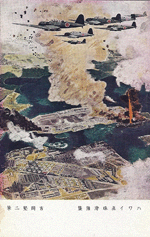 1.01k |
Japanese post card of bombers over Pearl Harbor, 7 December 1941. |
Photo courtesy of Arnold Putnam.
| 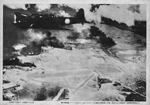 3.24k |
Japanese attack on Pearl Harbor - Hickam Field. |
Photo courtesy of Arnold Putnam.
|  86k |
Oil on canvas painting by the artist Tom Freeman entitled "Last Torpedo".
The Oklahoma (BB-37) starts to capsize.
The ship had no watertight integrity, as all portholes and watertight doors were open for Captain's inspection when the Japanese attacked.
Maryland (BB-46) is at left, and Tennessee (BB-43) is behind and to the left of the Oklahoma, and West Virginia (BB-48) is directly behind her and sinking. |
Photo and partial text courtesy of oldgloryprints.com |
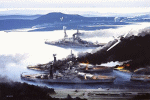 63k | Oil on canvas painting by the artist Ivan Berryman entitled "The Raid on Pearl Harbor, 7th December 1941 ", depicting the view across Battleship Row, viewed from above Ford Island as the Nevada (BB-36) gallantly makes her break for the open sea, coming under heavy attack from Japanese A6M2s from the carrier Hiryu. The Nevada as eventually too badly damaged to continue and was beached to avoid blocking the harbour entrance. In the immediate foreground, the lightly damaged Tennessee (BB-43) is trapped inboard of West Virginia (BB-48) which has sunk at her moorings, leaking burning oil and hampering the daring operations to pluck trapped crew members from her decks, while just visible to the right is the stern of the Maryland (BB-46) and the capsized Oklahoma (BB-37).
| Photo and partial text courtesy of military-art.com. |
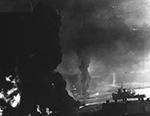 353k |
Original caption: Japanese attack on Pearl Harbor. Burning oil from shattered fuel tanks through the smoke of which are barely visible a damaged West Virginia (BB-48) and the capsized Oklahoma (BB-37).
|
National Archives Identifier: 12008981 | Local Identifier: 80-G-19951 Photo courtesy of catalog.archives.gov 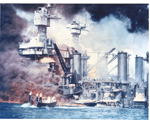 840k | Sailors in a motor launch rescue a survivor from the water alongside the sunken West Virginia (BB-48) during or shortly after the Japanese air raid on Pearl Harbor. Tennessee (BB-43) is inboard of the sunken battleship. Note extensive distortion of West Virginia's lower midships superstructure, caused by torpedoes that exploded below that location. Also note 5"/25 gun, still partially covered with canvas, boat crane swung outboard and empty boat cradles near the smokestacks, and base of radar antenna atop West Virginia's foremast. | National Archives Identifier: 12009098 | Local Identifier:111-C-5904 Photo courtesy of catalog.archives.gov 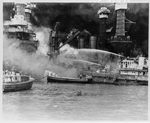 2.59k | This photo shows the fires being fought on the sunken battleship West Virginia (BB-48), 7 December 1941. The garbage lighter YG-17 is at right, with her crewmen playing two fire hoses at the flames. Assisting or standing by are a motor launch and an officer's motorboat. Tennessee (BB-43) is inboard of West Virginia . | An OS2U floatplane (marked "4-O-3") is upside down on West Virginia's main deck. A second OS2U is partially burned out atop the Turret # 3 catapult. Note radar antenna atop West Virginia's foremast. Official USN photo # 80-G-19947 courtesy of Bob Canchola, now in the collections of the National Archives. |  345k |
Doris Miller stands in the bow of a motor launch near the West Virginia (BB-48) on 7 December. |
Photo courtesy of David Aiken, Director: Pearl Harbor History Associates, Inc.
|  1.18k |
A Japanese B5N torpedo aircraft makes the 1st run on the West Virginia (BB-48) on 7 December. |
Photo from the 9 page PDF above. Photo courtesy of David Aiken, Director: Pearl Harbor History Associates, Inc.
|  2.85k | View of Battleship Row during or immediately after the Japanese raid. West Virginia (BB-48) and Tennessee (BB-43) are in the center right. The capsized Oklahoma (BB-37) is at the left, alongside Maryland (BB-46). |
USN photo # 80-G-32416, courtesy of the National Museum of the U.S. Navy, via flickr.com. |
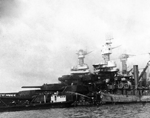 477k | West Virginia (BB-48) and Tennessee (BB-43) after the attack. | USN photo # 80-G-32475 from the National Museum of the U.S. Navy, courtesy of flickr.com.
| 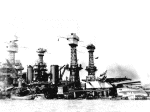 109k | Attack on Pearl Harbor, 7 December 1941: West Virginia (BB-48) sunk at anchor after her fires were put out. Her OS2U plane upside down on her deck with another plane burned out on the catapult. Tennessee (BB-43) is inboard. Note radar on West Virginia's foremast. | National Archives Photograph # 80-G-19945. | 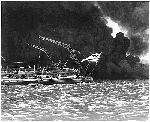 118k | The colors still fly from the stern of the sunken battleship West Virginia (BB-48) after the Japanese attack on Pearl Harbor. | Photographer: This photograph was originally taken by a Naval photographer immediately after the Japanese attack on Pearl Harbor, but came to be filed in a writ of application for habeas corpus case (number 298) tried in the US District Court, District of Hawaii in 1944. The case, In Re Lloyd C. Duncan related to imposition of martial law in Hawaii during World War II. |
National Archives Identifier:295994 Photo courtesy of catalog.archives.gov 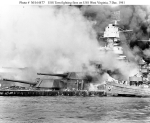 92k | With help from the crew of the Tern (AM-31), the fires aboard the sunken West Virginia (BB-48) are slowly being extinguished. Note radar antenna, paravanes and 16"/45 twin gun turrets on the battleship. | National Archives Photograph # NH 64477. |  3.52k | Vertical aerial view of "Battleship Row", beside Ford Island, soon after Arizona (BB-39) was hit by bombs and her forward magazines exploded. Photographed from a Japanese aircraft. Ships seen are (from left to right): Nevada (BB-36); Arizona (burning intensely) with Vestal (AR-4) moored outboard; Tennessee (BB-43) with West Virginia (BB-48) moored outboard; and Maryland (BB-46) with Oklahoma (BB-37) capsized alongside. Smoke from bomb hits on Vestal and West Virginia is also visible. |
Japanese inscription in lower left states that the photograph has been reproduced under Navy Ministry authorization. Also at NHHC as NH 30552. Translated Japanese caption reads, "Capsizing, Sinking, Burning, the anchorage of the American capital ships is changed to a scene of carnage. In rapid succession, the enemy war vessels were set ablaze by the violent bombing attacks which followed the torpedo attacks. The special service ship in the capital ship anchorage has already been sunk. The violent smoke from the exploding powder magazine is rising from a vessel of the Oklahoma Class alongside. A Pennsylvania class ship, capsized and sinking, shows its bottom. Two ships the California class and the Maryland class are in flames from direct bomb hits. In the upper right-hand part of the photograph are what appear to be several rescue ships, darting right and left. USN photo # 80-G-30552, courtesy of the National Museum of the U.S. Navy, via flickr.com. |
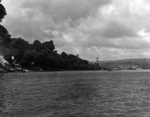 1.21k |
Burning and damaged ships at Pearl Harbor after the attack. Visible left to right: Arizona (BB-39) and West Virginia (BB-48). |
USN photo # 80-G-32729, courtesy of the National Museum of the U.S. Navy, via flickr.com.
| 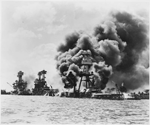 610k | Aftermath of the Japanese sneak attack on these three stricken U.S. battleships; from left to right: West Virginia (BB-48) (severely damaged), Tennessee (BB-43) (damaged), and the Arizona (BB-39) (sunk). | NARA #(NLR-PHOCO-A-65458) courtesy of fdrlibrary.marist.edu |
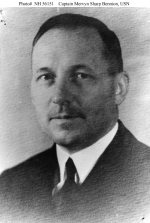 74k | Captain Mervyn Sharp Bennion, USN, who was awarded the Medal of Honor, posthumously, for devotion to duty and courage during the Pearl Harbor attack, 7 December 1941, while serving as Commanding Officer of West Virginia (BB-48). | Photo # NH 56151, now in the collections of the National Archives. | 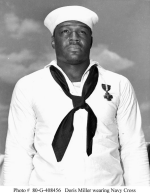 55k | Doris Miller, Mess Attendant Second Class, USN (1919-1943). Just after being presented with the Navy Cross by Admiral Chester W. Nimitz, on board Enterprise (CV-6) at Pearl Harbor, 27 May 1942. The medal was awarded for heroism on board West Virginia (BB-48) during the Pearl Harbor Attack, 7 December 1941. | Official USN photo # 80-G-408456, now in the collections of the National Archives. | Salvage & Repair |
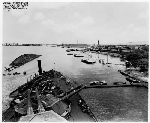 108k | Looking over the main turrets to the upturned Oklahoma (BB-37). The Maryland (BB-46) which had been alongside the Oklahoma, was released and moved away on 9 December. The forward most of Tennessee's (BB-43) two concrete mooring quays was next demolished, a delicate task since the ship's hull was resting against it, and had been cleared away by 16 December. This photo is dated sometime after that.
| USN photo courtesy of Pieter Bakels. |
Text courtesy of DANFS. 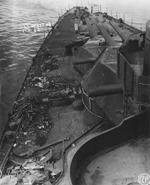 89k | Photo of the West Virginia's (BB-48) port forecastle. The port side decking has been removed and the Mobile Salvage Unit has piled debris, trash and charred lumber for disposal. Photograph taken on 5 January 1942.
| Photo from the book "Resurrection-Salvaging the Battle Fleet at Pearl Harbor", by Dan Madsen. National Archives photo courtesy of Mike Green. | 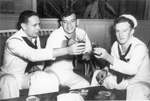 014816 212k |
The following link is from a story by Don Haines appearing in warfarehistorynetwork.com showing Clifford Nathan Olds, (Right) one of three sailors in Pump Room A-109 on the West Virginia (BB-48), who would die with Ronald Endicott and Louis Costin on or about 24 December after spending 16 days entombed on the bottom of the ship on Pearl Harbor. Their bodies would be found in May 1942. | Forfurther info see gregorystrachta.com
| 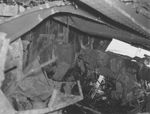 129k |
Interior of gallery showing secondary gun. Bomb probably fell in or below gallery and torpedo below water, causing the collapse of the entire deck, which fell completely and brought the secondary battery down to the main deck level. Photograph taken 16 March 1942. |
1942 June BB48 Report of Salvage 23 (Photo 802). | Photo Source: NARA San Francisco, Pearl Harbor Navy Yard General Correspondence files 1941-45. Photo courtesy of Tracy White @ Researcher @ Large. 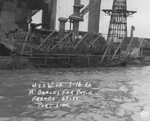 147k |
"A" braces for patch frames 63-99, port side. Photograph taken 16 March 1942. |
1942 June BB48 Report of Salvage 20 (Photo 836). | Photo Source: NARA San Francisco, Pearl Harbor Navy Yard General Correspondence files 1941-45. Photo courtesy of Tracy White @ Researcher @ Large. 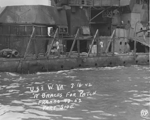 137k |
"A" braces for patch frames 43-52, port side. Photograph taken 16 March 1942. |
1942 June BB48 Report of Salvage 25 (Photo 837). | Photo Source: NARA San Francisco, Pearl Harbor Navy Yard General Correspondence files 1941-45. Photo courtesy of Tracy White @ Researcher @ Large. 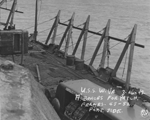 150k |
The A-frames used for securing the West Virginia's (BB-48) forward patch are shown in this 16 March 1942 photo. The frames extended over the deck edge and are secured with the wires seen. Chain falls for holding the patch sections run along the I-beam attached to the outside of the frames. |
Text courtesy of "Resurrection-Salvaging the Battle Fleet at
Pearl Harbor", by Dan Madsen via Mike Green. | Photo from 1942 June BB48 Report of Salvage 21 (Photo 838). Photo Source: NARA San Francisco, Pearl Harbor Navy Yard General Correspondence files 1941-45. Photo courtesy of Tracy White @ Researcher @ Large.  46k | Wrecked by torpedo explosions - second deck of the West Virginia (BB-48), showing salvage patch already installed, with frame numbers marked on it. | USN photo courtesy of Pieter Bakels. |
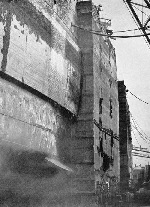 620k | Patches for man-of-war: the West Virginia (BB-48) in drydock showing the enormous patches rising like a fortress wall. | USN photo courtesy of Pieter Bakels. |
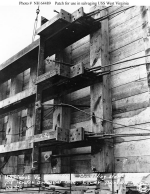 119k | Lower portion of a patch prepared for use in salvaging West Virginia (BB-48) at Pearl Harbor, 1942. Projecting steel beams fit under the ship's armor belt. | Official USN photo Naval History and Heritage Command # NH 64489, now in the collections of the National Archives. | 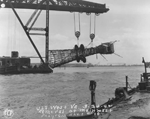 110k |
West Virginia's (BB-48) Mainmast removed by YD-25 & YT-146 Hoga on 24 March 1942. |
1942 June BB48 Report of Salvage 25 (Photo 837). | Photo Source: NARA San Francisco, Pearl Harbor Navy Yard General Correspondence files 1941-45. Photo courtesy of Tracy White @ Researcher @ Large. 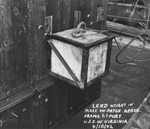 91k | Lead weight in place on patch. Approximate frame B-1 port. Photograph taken 18 April 1942. | 1942 June BB48 Report of Salvage. | Photo Source: NARA San Francisco, Pearl Harbor Navy Yard General Correspondence files 1941-45. Photo courtesy of Tracy White @ Researcher @ Large. 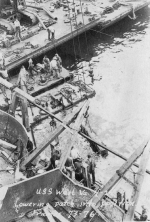 113k | Photo of a section of the long patch being lowered into position on the West Virginia's (BB-48) port side. After getting into close position, the patch will be transferred from the derrick hook to the chain fall for final positioning. Divers, on the float alongside, prepare to do the final positioning of the patch. Photograph taken 24 April 1942. | Photo from the book "Resurrection-Salvaging the Battle Fleet at Pearl Harbor", by Dan Madsen. National Archives photo courtesy of Mike Green. | 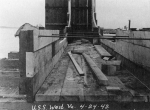 282k | Photo looking down the length of a patch end section,resting on a barge moored alongside the West Virginia (BB-48). Visible are cutouts for the armor belt and the hull shaping of the patch. The hull of the Oklahoma (BB-37) is seen at the upper left of the photo. Photograph taken 24 April 1942.
| Photo from the book "Resurrection-Salvaging the Battle Fleet at Pearl Harbor", by Dan Madsen. National Archives photo courtesy of Mike Green. | 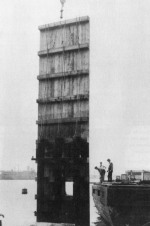 55k | The size of the patch sections used on the West Virginia (BB-48) are evident in this photo, as this one is lifted clear of the water. The wale spacings are closer at the bottom than at the top due to the increased water pressure.
| Photo from the book "Resurrection-Salvaging the Battle Fleet at Pearl Harbor", by Dan Madsen. National Archives photo courtesy of Mike Green. | 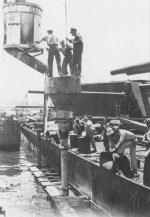 80k | Pacific Bridge workmen are seen pouring concrete through tremie pipes on 2 May 1942. This work is sealing the bottom of the forward patch. The pipe just forward was used to seal the end patch section from the bottom to the water line.
| Photo from the book "Resurrection-Salvaging the Battle Fleet atPearl Harbor", by Dan Madsen. National Archives photo courtesy of Mike Green. | 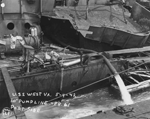 132k |
West Virginia (BB-48) Amidships 10-inch Pump Line, frame 61, port side. Photograph taken on 4 May 1942. |
1942 June BB48 Report of Salvage. | Photo Source: NARA San Francisco, Pearl Harbor Navy Yard General Correspondence files 1941-45. Photo courtesy of Tracy White @ Researcher @ Large. 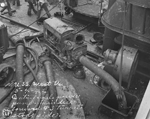 132k |
West Virginia (BB-48) Centrifugal Pump on main-deck forward turret #3, starboard side. Photograph taken on 4 May 1942. |
1942 June BB48 Report of Salvage. | Photo Source: NARA San Francisco, Pearl Harbor Navy Yard General Correspondence files 1941-45. Photo courtesy of Tracy White @ Researcher @ Large. 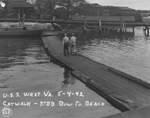 110k |
Floating Catwalk, starboard side to beach. Photograph taken on 4 May 1942. |
1942 June BB48 Report of Salvage. | Photo Source: NARA San Francisco, Pearl Harbor Navy Yard General Correspondence files 1941-45. Photo courtesy of Tracy White @ Researcher @ Large. 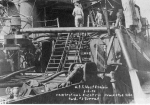 132k | West Virginia (BB-48). This pump is located on the starboard side of #3 turret. Photograph taken on 5 May 1942.
| Photo from the book "Resurrection-Salvaging the Battle Fleet at
Pearl Harbor", by Dan Madsen. National Archives photo courtesy of Mike Green. | 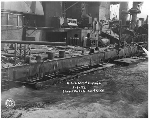 38k | Short Patch, Port Side. Photograph taken on 5 May 1942. | USN photo courtesy of Pieter Bakels. |
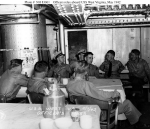 105k | Officers relaxing in their mess aboard the battleship on 7 May 1942, while she was under salvage at Pearl Harbor. Note Coca-Cola bottles on table, M1903 rifles in racks on the bulkhead at left and poster attached there. The poster shows a careless worker receiving a medal from a Japanese officer, and the inscription: "For distinguished service to the Axis ... For Loafing. He slept on the job ... He waited for his helper ... He waited for his material ... He did not keep his group busy ... He started late ... He quit early ... No good American is willingly idle, now which side are you on?". | Naval History and Heritage Command # NH 83061. |
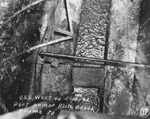 178k |
West Virginia (BB-48) Armor Break Frame 70. Photograph taken on 14 May 1942. |
1942 June BB48 Report of Salvage. | Photo Source: NARA San Francisco, Pearl Harbor Navy Yard General Correspondence files 1941-45. Photo courtesy of Tracy White @ Researcher @ Large. 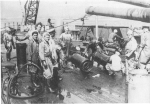 106k | 21 May 1942 photo of the West Virginia's (BB-48) crew wetting down and checking powder canisters removed from the magazines.
| Photo from the book "Resurrection-Salvaging the Battle Fleet at Pearl Harbor", by Dan Madsen, courtesy of Mike Green. | 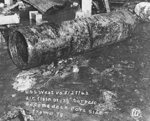 119k |
17.5 inch Torpedo Air Flask found on the 2nd deck, port side, frame 78. Photograph taken on 27 May 1942. |
1942 June BB48 Report of Salvage. | Photo Source: NARA San Francisco, Pearl Harbor Navy Yard General Correspondence files 1941-45. Photo courtesy of Tracy White @ Researcher @ Large. 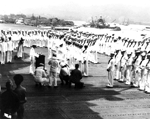 806k |
Admiral Chester W. Nimitz presents awards on the flight deck of the carrier Enterprise (CV-6) moored at Pearl Harbor on 5/27/1942. Note the battleship Oklahoma (BB-37) (capsized, nearest to camera) & West Virginia (BB-48) & Arizona (BB-39) behind her. |
One of those visible receiving a medal is Dorie Miller, an African-American messman who was awarded the Navy Cross for his heroic actions on board the battleship West Virginia (BB-48) during the Pearl Harbor attack. Photo from the collection of Robert L. Lawson. | US Navy and Marine Corps Museum/Naval Aviation Museum, Photo No. 1996.488.272.007. 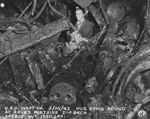 156k |
Dud bomb found at frame 63, port side 2nd deck. Approximate weight 1,750 pounds. Photograph taken on 30 May 1942. |
1942 June BB48 Report of Salvage. | Photo Source: NARA San Francisco, Pearl Harbor Navy Yard General Correspondence files 1941-45. Photo courtesy of Tracy White @ Researcher @ Large. 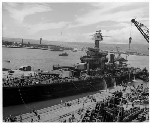 115k | View of West Virginia (BB-48) some time shortly before being moved to Drydock # 1. | USN photo courtesy of Pieter Bakels. Text courtesy of DANFS. |
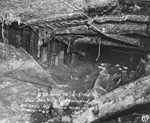 171k |
West Virginia (BB-48) 2nd Deck, Frame 69 damage. Photograph taken on 5 June 1942. |
1942 June BB48 Report of Salvage. | Photo Source: NARA San Francisco, Pearl Harbor Navy Yard General Correspondence files 1941-45. Photo courtesy of Tracy White @ Researcher @ Large. 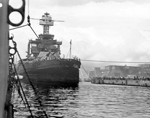 014802b 1.41k |
West Virginia (BB-48) being moved into drydock at Pearl Harbor on 9 June 1942. The ship has been moved to one side of the drydock, so as to protect the damaged port side hull patches of the ship. She was extensively rebuilt over the course of 1943 and into mid-1944. |
USN photo via Mike Green. | 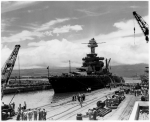 103k | 9 June 1942 photo of the West Virginia (BB-48) being eased into Dry-dock #1. The ship is hugging the starboard side of the dock to avoid bumping and damaging the port side patches.
| Photo from the book "Resurrection-Salvaging the Battle Fleet at Pearl Harbor", by Dan Madsen. National Archives photo courtesy of Mike Green. | 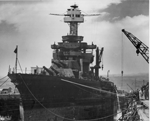 484k | In drydock. | USN photo # 80-G-16512 from National Archives and Records Administration (NARA), College Park, Maryland, courtesy of Sean Hert. |
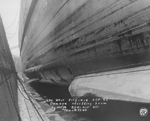 105k |
West Virginia (BB-48) Hull damage from Tennessee (BB-43). Photograph taken on 10 June 1942. |
1942 June BB48 Report of Salvage. | Photo Source: NARA San Francisco, Pearl Harbor Navy Yard General Correspondence files 1941-45. Photo courtesy of Tracy White @ Researcher @ Large. 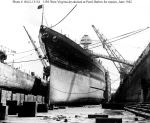 101k | In drydock at the Pearl Harbor Navy Yard, 10 June 1942, for repair of damage suffered in the 7 December 1941 Japanese air raid. She had entered the drydock on the previous day. Note large patch on her hull amidships, fouling on her hull, and large armor belt. | Official USN photo Naval History and Heritage Command # 80-G-13154, now in the collections of the National Archives. | 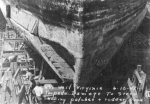 90k | 10 June 1942 photo of the stern damage to the West Virginia (BB-48). Initially missed, the stern had to be patched, as water tight integrity was completely gone. The rudder had been blown off the ship and crews had to go back to her moorage and retrieve it.
| Photo from the book "Resurrection-Salvaging the Battle Fleet at Pearl Harbor", by Dan Madsen. National Archives photo courtesy of Mike Green. | 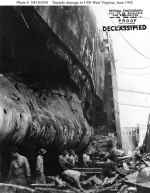 112k | View of her port side amidships, seen from the floor of Drydock Number One at the Pearl Harbor Navy Yard, in June 1942, as patches were being removed. Note the massive damage to hull plating inflicted by several Japanese Type 91 torpedoes that struck this area during the 7 December 1941 air raid. The battleship's side armor belt, at the top of the hole, is seriously distorted.View looks aft, with a patch still in place at the far end of the damage area. | Naval History and Heritage Command # NH 82058. | 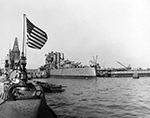 677k | West Virginia (BB-48) with masts removed being refitted after attack on Pearl Harbor, Territory of Hawaii. | The submarine on the left is a Portsmouth/Mare Island Tambor/Gar judging from the rectangular holes beneath the main bow D-shaped flood holes. Electric Boat Tambors had small round holes drilled there. Interesting that in one photo in that album her mine cutting hatch is open, making me think the mine gear may still be there and we're looking at a boat that had seen long service that is finally heading stateside for a refit. The submarine is sitting high in the water, indicating that she has been defueled and weapons removed, possibly prior to or immediately after a drydocking or substantial yard period. Text i.d. courtesy of Dave Jonnston (USNR) & Robert Morgan. | USN photo # 80-G-1397 8courtesy of National Museum of the U.S. Navy via flickr.com 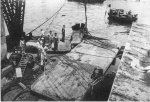 118k | The West Virginia (BB-48) missing rudder is recovered on 11 June 1942.
| Photo from the book "Resurrection-Salvaging the Battle Fleet at Pearl Harbor", by Dan Madsen. National Archives photo courtesy of Mike Green. | 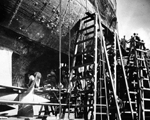 789k | West Virginia (BB-48) in Drydock Number One at Pearl Harbor Navy Yard, damage to port stern, June 1942. Probably taken at the same time as NH 64488, 11 June 1942. | USN photo # 80-G-13031, from the National Museum of the U.S. Navy, courtesy of flickr.com.
| 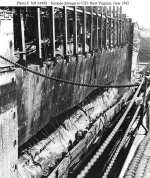 145k | West Virginia (BB-48) in Drydock Number One at Pearl Harbor Navy Yard, 11 June 1942. View looks aft along her port side from about Frame 64, showing distortion of the armor belt and damaged hull structure above and below. Several Japanese Type 91 torpedoes had detonated in this area during the 7 December 1941 air raid. | Official USN photo Naval History and Heritage Command # NH 64488, now in the collections of the National Archives. | 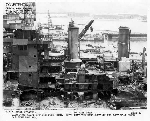 49k | West Virginia (BB-48) view from aloft off the port beam shown here on 16 June 1942. Note that the king post of the port boat crane has been removed. | USN photo #1873-42 courtesy of Pieter Bakels. |
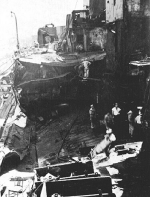 99k | West Virginia (BB-48) shown here on 17 June 1942 being made seaworthy for the trip to the mainland for permanent repairs. The extent of the damage to the port side above the armor belt is evident in this photo. The shallow depth running of the torpedoes and the initial list of the ship concentrated most of the damage above the side protective armor belt of the ship. A total of seven torpedoes and two bombs (modified 16"armor piercing naval shells fitted with fins) struck the ship during the Japanese attack. | USN photo. | 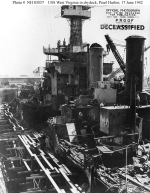 131k | In Drydock Number One at the Pearl Harbor Navy Yard, 17 June 1942. She was receiving repairs for the massive damage she received in the 7 December 1941 Japanese attack. Note that her hull side and upper deck amidships has been cut away. | National Archives # NH 83057. | 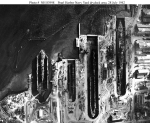 230k |
Pearl Harbor Navy Yard, Oahu, Territory of Hawaii.
Vertical aerial view of the drydock area, 28 July 1942.
Floating drydock YFD-2 is at left, with Aylwin (DD-355) inside. Small drydock in center holds Growler (SS-215) and Nautilus (SS-168). Litchfield (DD-336) and an ARD floating drydock are in Drydock # 2, in right center. Drydock # 1, at right, contains West Virginia (BB-48). Submarines partially visible alongside 1010 Dock, in the extreme upper right, are Trout (SS-202) and Pollack (SS-180).
Note anti-torpedo nets and booms protecting this area.
Note that the hulk of Downes (DD-375) is in Drydock #1 ahead of West Virginia.
|
Partial I.D. courtesy of Rick E. Davis. |
Official USN photo # NH 83998, from the collections of the Naval Historical Center, courtesy of the Naval Historical Foundation. Collection of The Honorable James V. Forrestal. 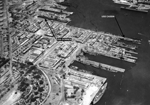 014842c 2.07k | While trying to figure out which one of the two damaged destroyers Cassin (DD-372) or Downes (DD-375) was moored at a pier nearby in another overhead photo at PHNY I scanned at NARA dated 10 August 1942, after researching records, a couple of us found that the destroyer was Cassin and that Downes had been placed in Drydock #1 in front of West Virginia (BB-48) on 9 June 1942, so that the hulk could have her machinery removed and shipped to MINY for a new hull to be built, then the remaining hull scrapped. Her scrapping was completed by the time West Virginia departed DD #1 on 9 September 1942. (It was reported that there was only 40% of Downes hull left on 10 August 1942) |
So, the caption for the subject image should add the note that the hulk of Downes is in Drydock #1 ahead of West Virginia. (Note; DANFS is wrong that Cassin was "towed" to MINY and was stripped and scrapped there) Attached is a crop of another photo (80-G-276582 found at NARA II, College Park, MD) showing the location of both Cassin and Downes on 9 July 1942, a month after Downes and West Virginia entered DD #1. The hulk of Cassin followed going in Drydock #1 with San Juan (CL-54) on 14 September 1942, after her machinery had been removed at pierside and shipped to MINY for her new hull. Cassin's hulk was completely broken up and removed by the time San Juan undocked on 20 September 1942. Also, in view are Hornet (CV-8) at Ford Island, California (BB-44), Morris (DD-417) in DD #3, Oglala (CM-4) is in DD #2 with Trout (SS-202) and Pollack (SS-180), Pensacola (CA-24) with Maury (DD-401) moored forward of her, and Preston (DD-379) is moored across from Hornet. (There are several (at least seven) Flush-Decker types in the yard, but I can't ID which is where) Photo & text courtesy of Rick E. Davis. |
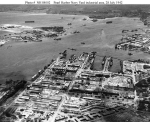 106k | Pearl Harbor, Oahu, Territory of Hawaii view looking northward, with the Navy Yard industrial area in the foreground and the Marine Barracks in the lower right, 28 July 1942. Ford Island is at left, with Oklahoma (BB-37) and Arizona (BB-39) under salvage nearby. San Diego (CL-53) is in the upper center. | West Virginia (BB-48) is in Drydock Number One, in the lower left, and California (BB-44) is alongside the wharf at the extreme right. Cruisers alongside the pier in right center are Northampton (CA-26) (left) and Pensacola (CA-24). Submarines alongside 1010 Dock, just beyond Drydock # 1, are Trout (SS-202), Pollack (SS-180), Dolphin (SS-169) and Cachalot (SS-170). Note camouflage on many of the Navy Yard's buildings. Official USN photo # NH 84002, from the collections of the Naval Historical Center, courtesy of the Naval Historical Foundation. Collection of The Honorable James V. Forrestal. |
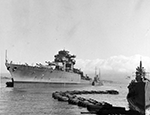 1.20k | Leaving drydock at Pearl Harbor Navy Yard, 9 September 1942. Note the missing foremast and the six-months of blackened oil and marine growth that was removed from her hull while in drydock. | Photo. i.d. & text courtesy of Richard Wong. |
USN photo courtesy of Scott Koen & ussnewyork.com. 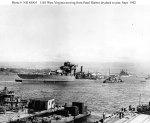 99k | West Virginia (BB-48) is moved to a pier after being undocked from Pearl Harbor Navy Yard's Drydock Number One, 9 September 1942. Note the large area of her midships upper hull that must still be replaced. West Virginia was then under repair for damage received in the 7 December 1941 Japanese air raid. the New Mexico (BB-40) is in the right background. | Official USN photo Naval History and Heritage Command # NH 84005, from the collections of the Naval Historical Center, courtesy of the Naval Historical Foundation. Collection of The Honorable James V. Forrestal. | 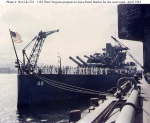 88k | Ready to depart Pearl Harbor on 30 April 1943, en route to the Puget Sound Navy Yard, Bremerton, Washington, for reconstruction. The Pearl Harbor Navy Yard had just finished temporary repair of the damage she had received in the Japanese attack of 7 December 1941. Note her crewmen wearing Dress White uniforms. | Official USN photo Naval History and Heritage Command # 80-G-K-574, now in the collections of the National Archives. | 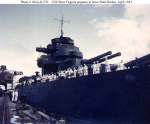 81k | About to leave Pearl Harbor on 30 April 1943, en route to the Puget Sound Navy Yard, Bremerton, Washington, for reconstruction. The Pearl Harbor Navy Yard had just finished temporary repair of the damage she had received in the Japanese attack of 7 December 1941. | Official USN photo # 80-G-K-570, now in the collections of the National Archives. | 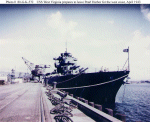 80k | West Virginia (BB-48) prepares to leave Pearl Harbor on 30 April 1943, en route to the Puget Sound Navy Yard, Bremerton, Washington, for reconstruction. The Pearl Harbor Navy Yard had just finished temporary repair of the damage she had received in the Japanese attack of 7 December 1941. The battleship in the left background is North Carolina (BB-55). | Official USN photo Naval History and Heritage Command # 80-G-K-572, now in the collections of the National Archives. | 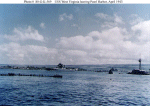 77k | Leaving Pearl Harbor on 30 April 1943, en route to the Puget Sound Navy Yard, Bremerton, Washington, for reconstruction. The Pearl Harbor Navy Yard had just finished temporary repair of the damage she had received in the Japanese attack of 7 December 1941. A New Mexico (BB-40 /42) class battleship is in the right distance, and at far right is the former mainmast of California (BB-44), now serving as a signal tower ashore. | Official USN photo # 80-G-K-569, now in the collections of the National Archives. |  429k | West Virginia (BB-48) Dead Ahead aerial view, at 75 degrees, taken by US Navy Utility Squadron One (VJ-1) in April 1943 as she appeared before being completely rebuilt at Bremerton. The rebuild was a lengthy process, and she wouldn't emerge from the shipyard until the fall of 1944. This photo shows how she was stripped for her trip across the Pacific; Masts, secondary guns, radars, catapults and planes have all been removed to insure her stability until she was permanently rebuilt. |
Photo i.d. courtesy of Paul Jacobs. | USN photo # 80-G-343629, courtesy of the National Museum of the U.S. Navy, via flickr.com.  657k | West Virginia (BB-48) severely damaged in the Japanese Attack of 7 December 1941. Shown: Damage to her side are visible. Photograph released 23 May 1943. | USN photo # 80-G-41614 from the National Museum of the U.S. Navy via flickr.com.
|  146k | Line drawing of the West Virginia (BB-48) showing her configuration after her rebuild. | Drawing courtesy of Jean Secardin. (Please contact him for permission to use any of his drawings) @perso.wanadoo.fr/ww2 |  126k | Drawing prepared by the Bureau of Ships for Camouflage Measure 32, Design 7D intended for battleships modernized from the Colorado class (BB-45 / 48).West Virginia (BB-48) wore this pattern. This plan, showing the ship's starboard side, superstructure ends, and exposed decks, is dated 18 March 1944 and was approved by Captain Torvald A. Solberg, USN.
| Official USN photo # 80-G-109734, now in the collections of the National Archives. |
 135k | Drawing prepared by the Bureau of Ships for Camouflage Measure 32, Design 7D intended for battleships modernized from the Colorado class (BB-45 / 48). West Virginia (BB-48) wore this pattern. This plan, showing the ship's port side, is dated 18 March 1944 and was approved by Captain Torvald A. Solberg, USN.
| Official USN photo # 80-G-109733, now in the collections of the National Archives. |
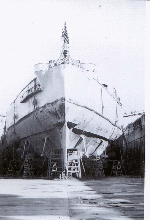 58k | Stern view of the West Virginia (BB-48) in drydock. | USN photo courtesy of Pieter Bakels. |
| |||||||||||||||||||||||||||||||||||||||||||||||||||||||||||||||||||||||||||||||||||||||||||||||||||||||||||||||||||||||||||||||||||||||||||||||||||||||||||||||||||||||||||||
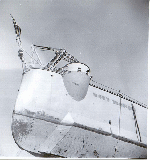 | 41k | Starboard stern view of the West Virginia (BB-48) in drydock. | USN photo courtesy of Pieter Bakels. | ||||||||||||||||||||||||||||||||||||||||||||||||||||||||||||||||||||||||||||||||||||||||||||||||||||||||||||||||||||||||||||||||||||||||||||||||||||||||||||||||||||||||||||||||||||||||||||||||||||||||||||||||||||||||||||||||||||||||||||||||||||||||||||||||||||||||||||||||||||||||||||||||||||||||||||||||||||||||||||||||||||||||||||||||||||||||||||||||||||||||||||||||||||||||||||||||||||||||||||||||||||||||||||||||||||||||||
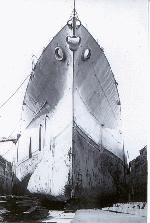 | 61k | Looking up from below at 32,600 tons of West Virginia (BB-48) in drydock. | USN photo courtesy of Pieter Bakels. | ||||||||||||||||||||||||||||||||||||||||||||||||||||||||||||||||||||||||||||||||||||||||||||||||||||||||||||||||||||||||||||||||||||||||||||||||||||||||||||||||||||||||||||||||||||||||||||||||||||||||||||||||||||||||||||||||||||||||||||||||||||||||||||||||||||||||||||||||||||||||||||||||||||||||||||||||||||||||||||||||||||||||||||||||||||||||||||||||||||||||||||||||||||||||||||||||||||||||||||||||||||||||||||||||||||||||||
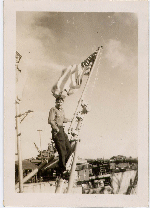 | 69k | Old Glory flutters from the stern of the West Virginia (BB-48) in drydock. | USN photo courtesy of Pieter Bakels. | ||||||||||||||||||||||||||||||||||||||||||||||||||||||||||||||||||||||||||||||||||||||||||||||||||||||||||||||||||||||||||||||||||||||||||||||||||||||||||||||||||||||||||||||||||||||||||||||||||||||||||||||||||||||||||||||||||||||||||||||||||||||||||||||||||||||||||||||||||||||||||||||||||||||||||||||||||||||||||||||||||||||||||||||||||||||||||||||||||||||||||||||||||||||||||||||||||||||||||||||||||||||||||||||||||||||||||
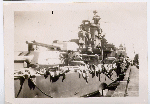 | 89k | Signal flags lie across the deck of the West Virginia (BB-48) pier-side at Puget Sound. | USN photo courtesy of Pieter Bakels. | ||||||||||||||||||||||||||||||||||||||||||||||||||||||||||||||||||||||||||||||||||||||||||||||||||||||||||||||||||||||||||||||||||||||||||||||||||||||||||||||||||||||||||||||||||||||||||||||||||||||||||||||||||||||||||||||||||||||||||||||||||||||||||||||||||||||||||||||||||||||||||||||||||||||||||||||||||||||||||||||||||||||||||||||||||||||||||||||||||||||||||||||||||||||||||||||||||||||||||||||||||||||||||||||||||||||||||
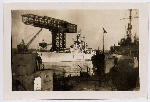 | 64k | The West Virginia (BB-48) lies alongside the hammerhead crane pier-side at Puget Sound. | USN photo courtesy of Pieter Bakels. | ||||||||||||||||||||||||||||||||||||||||||||||||||||||||||||||||||||||||||||||||||||||||||||||||||||||||||||||||||||||||||||||||||||||||||||||||||||||||||||||||||||||||||||||||||||||||||||||||||||||||||||||||||||||||||||||||||||||||||||||||||||||||||||||||||||||||||||||||||||||||||||||||||||||||||||||||||||||||||||||||||||||||||||||||||||||||||||||||||||||||||||||||||||||||||||||||||||||||||||||||||||||||||||||||||||||||||
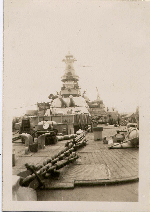 | 71k | Looking down the length of the West Virginia (BB-48) decked anchor chain and her business end, pierside at Puget Sound. | USN photo courtesy of Pieter Bakels. | ||||||||||||||||||||||||||||||||||||||||||||||||||||||||||||||||||||||||||||||||||||||||||||||||||||||||||||||||||||||||||||||||||||||||||||||||||||||||||||||||||||||||||||||||||||||||||||||||||||||||||||||||||||||||||||||||||||||||||||||||||||||||||||||||||||||||||||||||||||||||||||||||||||||||||||||||||||||||||||||||||||||||||||||||||||||||||||||||||||||||||||||||||||||||||||||||||||||||||||||||||||||||||||||||||||||||||
 | 64k | The West Virginia (BB-48) plows through the Pacific. | USN photo courtesy of Pieter Bakels. | ||||||||||||||||||||||||||||||||||||||||||||||||||||||||||||||||||||||||||||||||||||||||||||||||||||||||||||||||||||||||||||||||||||||||||||||||||||||||||||||||||||||||||||||||||||||||||||||||||||||||||||||||||||||||||||||||||||||||||||||||||||||||||||||||||||||||||||||||||||||||||||||||||||||||||||||||||||||||||||||||||||||||||||||||||||||||||||||||||||||||||||||||||||||||||||||||||||||||||||||||||||||||||||||||||||||||||
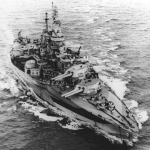 | 72k | Showing final configuration after rebuild at Puget Sound Navy Yard, June 1944. Main batteries are all trained out to starboard. | USN photo. | ||||||||||||||||||||||||||||||||||||||||||||||||||||||||||||||||||||||||||||||||||||||||||||||||||||||||||||||||||||||||||||||||||||||||||||||||||||||||||||||||||||||||||||||||||||||||||||||||||||||||||||||||||||||||||||||||||||||||||||||||||||||||||||||||||||||||||||||||||||||||||||||||||||||||||||||||||||||||||||||||||||||||||||||||||||||||||||||||||||||||||||||||||||||||||||||||||||||||||||||||||||||||||||||||||||||||||
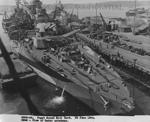 | 227k | West Virginia (BB-48) at Puget Sound Naval Shipyard finishing overhaul on 28 June 1944. Note workers painting 5-O Ocean Gray for her Measure 32 / 7D camouflage on forward deck and chains for paravanes rigged. Mississippi (BB-41) is in background across the pier. | USN photo # 2536-44 from NARA San Francisco, Pearl Harbor Navy Yard General Correspondence Files, courtesy of Tracy White @ Researcher @ Large. | ||||||||||||||||||||||||||||||||||||||||||||||||||||||||||||||||||||||||||||||||||||||||||||||||||||||||||||||||||||||||||||||||||||||||||||||||||||||||||||||||||||||||||||||||||||||||||||||||||||||||||||||||||||||||||||||||||||||||||||||||||||||||||||||||||||||||||||||||||||||||||||||||||||||||||||||||||||||||||||||||||||||||||||||||||||||||||||||||||||||||||||||||||||||||||||||||||||||||||||||||||||||||||||||||||||||||||
 | 234k | Port side view showing final configuration after rebuild at Puget Sound Navy Yard, 2 July 1944. She is painted in Camouflage Measure 32, Design 7D. | USN photo. Text i.d. courtesy of Naval History and Heritage Command photo # 19-N-68375. | ||||||||||||||||||||||||||||||||||||||||||||||||||||||||||||||||||||||||||||||||||||||||||||||||||||||||||||||||||||||||||||||||||||||||||||||||||||||||||||||||||||||||||||||||||||||||||||||||||||||||||||||||||||||||||||||||||||||||||||||||||||||||||||||||||||||||||||||||||||||||||||||||||||||||||||||||||||||||||||||||||||||||||||||||||||||||||||||||||||||||||||||||||||||||||||||||||||||||||||||||||||||||||||||||||||||||||
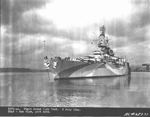 | 975k | Bow view, port side view on 2 July 1944. | USN photo BS # 68377 courtesy of Scott Koen & ussnewyork.com. | ||||||||||||||||||||||||||||||||||||||||||||||||||||||||||||||||||||||||||||||||||||||||||||||||||||||||||||||||||||||||||||||||||||||||||||||||||||||||||||||||||||||||||||||||||||||||||||||||||||||||||||||||||||||||||||||||||||||||||||||||||||||||||||||||||||||||||||||||||||||||||||||||||||||||||||||||||||||||||||||||||||||||||||||||||||||||||||||||||||||||||||||||||||||||||||||||||||||||||||||||||||||||||||||||||||||||||
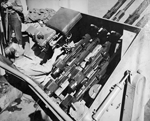 | 818k | Taken by Lt. A. F. Cohen (Air Defense Officer) seated at Quad 20mm Thunderbolt, 7.4.1944. | Photo courtesy of Pieter Bakels. | ||||||||||||||||||||||||||||||||||||||||||||||||||||||||||||||||||||||||||||||||||||||||||||||||||||||||||||||||||||||||||||||||||||||||||||||||||||||||||||||||||||||||||||||||||||||||||||||||||||||||||||||||||||||||||||||||||||||||||||||||||||||||||||||||||||||||||||||||||||||||||||||||||||||||||||||||||||||||||||||||||||||||||||||||||||||||||||||||||||||||||||||||||||||||||||||||||||||||||||||||||||||||||||||||||||||||||
 | 200k | Seen in Puget Sound Navy Yard 2 July 1944 after an extensive overhaul which drastically altered her appearance. She is painted in Camouflage Measure 32, Design 7D. She now looks virtually identical to the Tennessee class (BB-43 /44). | USN photo s. Partial text courtesy of Naval History and Heritage Command photo # 19-N-68374. | ||||||||||||||||||||||||||||||||||||||||||||||||||||||||||||||||||||||||||||||||||||||||||||||||||||||||||||||||||||||||||||||||||||||||||||||||||||||||||||||||||||||||||||||||||||||||||||||||||||||||||||||||||||||||||||||||||||||||||||||||||||||||||||||||||||||||||||||||||||||||||||||||||||||||||||||||||||||||||||||||||||||||||||||||||||||||||||||||||||||||||||||||||||||||||||||||||||||||||||||||||||||||||||||||||||||||||
 014898 |
721k | West Virginia's (BB-48) Commissary Department during WWII. | Photo from flickr.com by Jim Phillips courtesy of John Spivy. | ||||||||||||||||||||||||||||||||||||||||||||||||||||||||||||||||||||||||||||||||||||||||||||||||||||||||||||||||||||||||||||||||||||||||||||||||||||||||||||||||||||||||||||||||||||||||||||||||||||||||||||||||||||||||||||||||||||||||||||||||||||||||||||||||||||||||||||||||||||||||||||||||||||||||||||||||||||||||||||||||||||||||||||||||||||||||||||||||||||||||||||||||||||||||||||||||||||||||||||||||||||||||||||||||||||||||||
 | 99k | The Hatfields and McCoys. "Converted Mountaineers" on West Virginia (BB-48), 1944. | Naval History and Heritage Command photo # NH 89343. | ||||||||||||||||||||||||||||||||||||||||||||||||||||||||||||||||||||||||||||||||||||||||||||||||||||||||||||||||||||||||||||||||||||||||||||||||||||||||||||||||||||||||||||||||||||||||||||||||||||||||||||||||||||||||||||||||||||||||||||||||||||||||||||||||||||||||||||||||||||||||||||||||||||||||||||||||||||||||||||||||||||||||||||||||||||||||||||||||||||||||||||||||||||||||||||||||||||||||||||||||||||||||||||||||||||||||||
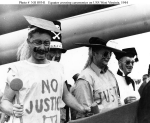 | 90k | "No Justice" issues a ruling at the "Royal Court" as "Justice" stands mute, during the trial of "polliwogs" in Equator crossing ceremonies for the battleship's crew, October 1944. | Naval History and Heritage Command photo # NH 89341. | ||||||||||||||||||||||||||||||||||||||||||||||||||||||||||||||||||||||||||||||||||||||||||||||||||||||||||||||||||||||||||||||||||||||||||||||||||||||||||||||||||||||||||||||||||||||||||||||||||||||||||||||||||||||||||||||||||||||||||||||||||||||||||||||||||||||||||||||||||||||||||||||||||||||||||||||||||||||||||||||||||||||||||||||||||||||||||||||||||||||||||||||||||||||||||||||||||||||||||||||||||||||||||||||||||||||||||
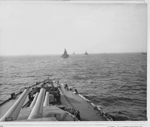 | 372k | The West Virginia (BB-48) looking out at the fleet prior to bombarding Leyte Gulf on 19 October 1944. On 19 October West Virginia steamed into her assigned station in San Pedro Bay at 0700 to stand by off shore and provide shore bombardment against targets in the Tacloban area of Leyte. Retiring to sea that evening, the battleship and her consorts returned the next morning to lay down heavy gunfire on Japanese installations in the vicinity of the town of Tacloban. | Partial text courtesy of DANFS. USN photo # 80-G- 289672, from NARA, College Park, Maryland, courtesy of Sean Hert |
||||||||||||||||||||||||||||||||||||||||||||||||||||||||||||||||||||||||||||||||||||||||||||||||||||||||||||||||||||||||||||||||||||||||||||||||||||||||||||||||||||||||||||||||||||||||||||||||||||||||||||||||||||||||||||||||||||||||||||||||||||||||||||||||||||||||||||||||||||||||||||||||||||||||||||||||||||||||||||||||||||||||||||||||||||||||||||||||||||||||||||||||||||||||||||||||||||||||||||||||||||||||||||||||||||||||||
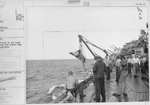 | 497k | At 1645, California (BB-44) cut loose a mine with her paravanes; West Virginia (BB-48) successfully dodged the horned menace, it being destroyed a few moments later by gunfire from one of the destroyers in the screen. | Partial text courtesy of DANFS. USN photo # 80-G-289675, from NARA, College Park, Maryland, courtesy of Sean Hert |
||||||||||||||||||||||||||||||||||||||||||||||||||||||||||||||||||||||||||||||||||||||||||||||||||||||||||||||||||||||||||||||||||||||||||||||||||||||||||||||||||||||||||||||||||||||||||||||||||||||||||||||||||||||||||||||||||||||||||||||||||||||||||||||||||||||||||||||||||||||||||||||||||||||||||||||||||||||||||||||||||||||||||||||||||||||||||||||||||||||||||||||||||||||||||||||||||||||||||||||||||||||||||||||||||||||||||
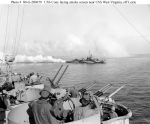 | 99k | Cony (DD-508) lays a smoke screen near West Virginia (BB-48), to protect shipping off Leyte from Japanese air attack, during the landings there on 20 October 1944. Note manned anti-aircraft batteries on board the battleship, including a Mark 51 director in the foreground, 20mm gun at left, 40mm quad gun mount in center and 5"/38 twin gun mounts beyond. | Official USN photo # 80-G-289679, now in the collections of the National Archives. | ||||||||||||||||||||||||||||||||||||||||||||||||||||||||||||||||||||||||||||||||||||||||||||||||||||||||||||||||||||||||||||||||||||||||||||||||||||||||||||||||||||||||||||||||||||||||||||||||||||||||||||||||||||||||||||||||||||||||||||||||||||||||||||||||||||||||||||||||||||||||||||||||||||||||||||||||||||||||||||||||||||||||||||||||||||||||||||||||||||||||||||||||||||||||||||||||||||||||||||||||||||||||||||||||||||||||||
 | 483k | Battle of Leyte Gulf, Surigao Strait, 25 October 1944. Shown: U.S. Ships firing on Japanese Task Force, West Virginia (BB-48). Photograph by Pennsylvania (BB-38), 25 October 1944. | USN photo # 80-G-288497 from the National Museum of the U.S. Navy via flickr.com. | ||||||||||||||||||||||||||||||||||||||||||||||||||||||||||||||||||||||||||||||||||||||||||||||||||||||||||||||||||||||||||||||||||||||||||||||||||||||||||||||||||||||||||||||||||||||||||||||||||||||||||||||||||||||||||||||||||||||||||||||||||||||||||||||||||||||||||||||||||||||||||||||||||||||||||||||||||||||||||||||||||||||||||||||||||||||||||||||||||||||||||||||||||||||||||||||||||||||||||||||||||||||||||||||||||||||||||
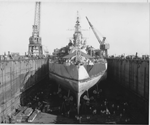 | 381k | West Virginia (BB-48) on 8 November 1944 underwent a period of upkeep in the floating drydock ABSD-1 for her damaged screws. | Partial text courtesy of DANFS. USN photo # 80-G-289691, from NARA, College Park, Maryland, courtesy of Sean Hert |
||||||||||||||||||||||||||||||||||||||||||||||||||||||||||||||||||||||||||||||||||||||||||||||||||||||||||||||||||||||||||||||||||||||||||||||||||||||||||||||||||||||||||||||||||||||||||||||||||||||||||||||||||||||||||||||||||||||||||||||||||||||||||||||||||||||||||||||||||||||||||||||||||||||||||||||||||||||||||||||||||||||||||||||||||||||||||||||||||||||||||||||||||||||||||||||||||||||||||||||||||||||||||||||||||||||||||
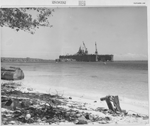 | 441k | West Virginia (BB-48) on 8 November 1944 underwent a period of upkeep in the floating drydock ABSD-1 for her damaged screws. | Partial text courtesy of DANFS. USN photo # 80-G-289692, from NARA, College Park, Maryland, courtesy of Sean Hert |
||||||||||||||||||||||||||||||||||||||||||||||||||||||||||||||||||||||||||||||||||||||||||||||||||||||||||||||||||||||||||||||||||||||||||||||||||||||||||||||||||||||||||||||||||||||||||||||||||||||||||||||||||||||||||||||||||||||||||||||||||||||||||||||||||||||||||||||||||||||||||||||||||||||||||||||||||||||||||||||||||||||||||||||||||||||||||||||||||||||||||||||||||||||||||||||||||||||||||||||||||||||||||||||||||||||||||
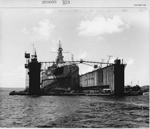 | 487k | View from the water line of West Virginia (BB-48) in the floating drydock ABSD-1. | USN photo # 80-G-289693, from NARA, College Park, Maryland, courtesy of Sean Hert | ||||||||||||||||||||||||||||||||||||||||||||||||||||||||||||||||||||||||||||||||||||||||||||||||||||||||||||||||||||||||||||||||||||||||||||||||||||||||||||||||||||||||||||||||||||||||||||||||||||||||||||||||||||||||||||||||||||||||||||||||||||||||||||||||||||||||||||||||||||||||||||||||||||||||||||||||||||||||||||||||||||||||||||||||||||||||||||||||||||||||||||||||||||||||||||||||||||||||||||||||||||||||||||||||||||||||||
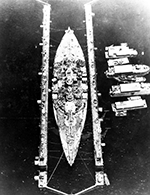 |
664k | Overhead view of West Virginia (BB-48) in ABSD-1 floating drydock at Espiritu Santo, November 1944. The ship was docked for upkeep and repair to propellers damaged when she touched ground off Leyte on 21 October. | Source: Naval History Heritage and Command, Photo No. NH 89346 via Mike Green. | ||||||||||||||||||||||||||||||||||||||||||||||||||||||||||||||||||||||||||||||||||||||||||||||||||||||||||||||||||||||||||||||||||||||||||||||||||||||||||||||||||||||||||||||||||||||||||||||||||||||||||||||||||||||||||||||||||||||||||||||||||||||||||||||||||||||||||||||||||||||||||||||||||||||||||||||||||||||||||||||||||||||||||||||||||||||||||||||||||||||||||||||||||||||||||||||||||||||||||||||||||||||||||||||||||||||||||
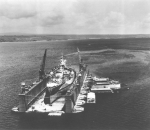 | 129k | In floating drydock ABSD-1, off Aessi Island, Espiritu Santo, New Hebrides, on 13 November 1944. The battleship was docked for upkeep and repair to propellers damaged when she touched ground off Leyte on 21 October. | Official USN photo Naval History and Heritage Command # 80-G-314220, now in the collections of the National Archives. | ||||||||||||||||||||||||||||||||||||||||||||||||||||||||||||||||||||||||||||||||||||||||||||||||||||||||||||||||||||||||||||||||||||||||||||||||||||||||||||||||||||||||||||||||||||||||||||||||||||||||||||||||||||||||||||||||||||||||||||||||||||||||||||||||||||||||||||||||||||||||||||||||||||||||||||||||||||||||||||||||||||||||||||||||||||||||||||||||||||||||||||||||||||||||||||||||||||||||||||||||||||||||||||||||||||||||||
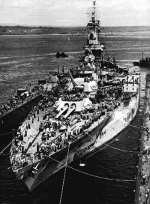 | 126k | Same photo as #21, with West Virginia (BB-48) enlarged. 9 November 1944 photo of the ship entering floating dry-dock ABSD-1. She differed from the South Dakotas in the fact that she was conned from a location forward and beneath her main battery director and that her forward surface lookouts were stationed atop the flag bridge just below her conn. | Naval History and Heritage Command # 80-G-314220, now in the collections of the National Archives. | ||||||||||||||||||||||||||||||||||||||||||||||||||||||||||||||||||||||||||||||||||||||||||||||||||||||||||||||||||||||||||||||||||||||||||||||||||||||||||||||||||||||||||||||||||||||||||||||||||||||||||||||||||||||||||||||||||||||||||||||||||||||||||||||||||||||||||||||||||||||||||||||||||||||||||||||||||||||||||||||||||||||||||||||||||||||||||||||||||||||||||||||||||||||||||||||||||||||||||||||||||||||||||||||||||||||||||
 | 685k | The "Wee Vee" returned to the Philippines, via Manus, on 26 November 1944, resuming her patrols in Leyte Gulf and serving as part of the antiaircraft screen for the transports and amphibious ships. At 1139 on the 27th, West Virginia's (BB-48) antiaircraft guns splashed a suicider and assisted in downing others while on duty the next day. | Text courtesy of DANFS. USN photo courtesy of Scott Koen & ussnewyork.com. |
||||||||||||||||||||||||||||||||||||||||||||||||||||||||||||||||||||||||||||||||||||||||||||||||||||||||||||||||||||||||||||||||||||||||||||||||||||||||||||||||||||||||||||||||||||||||||||||||||||||||||||||||||||||||||||||||||||||||||||||||||||||||||||||||||||||||||||||||||||||||||||||||||||||||||||||||||||||||||||||||||||||||||||||||||||||||||||||||||||||||||||||||||||||||||||||||||||||||||||||||||||||||||||||||||||||||||
 | 61k | The West Virginia (BB-48) inboard profile, 1945. | Photo and text courtesy of U.S. Battleships: An Illustrated Design History by Norman Friedman. | ||||||||||||||||||||||||||||||||||||||||||||||||||||||||||||||||||||||||||||||||||||||||||||||||||||||||||||||||||||||||||||||||||||||||||||||||||||||||||||||||||||||||||||||||||||||||||||||||||||||||||||||||||||||||||||||||||||||||||||||||||||||||||||||||||||||||||||||||||||||||||||||||||||||||||||||||||||||||||||||||||||||||||||||||||||||||||||||||||||||||||||||||||||||||||||||||||||||||||||||||||||||||||||||||||||||||||
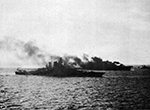 | 411k | Ommaney Bay (CVE-79) about four minutes after being hit by suicide plane in Sulu Sea on 4 January 1945. She sank about an hour later. West Virginia (BB-48) is in the foreground. | Source: Antiaircraft
Action Summary, Suicide Attacks, April 1945, United States Fleet, Headquarters of the Commander in Chief, COMINCH P-009 | ||||||||||||||||||||||||||||||||||||||||||||||||||||||||||||||||||||||||||||||||||||||||||||||||||||||||||||||||||||||||||||||||||||||||||||||||||||||||||||||||||||||||||||||||||||||||||||||||||||||||||||||||||||||||||||||||||||||||||||||||||||||||||||||||||||||||||||||||||||||||||||||||||||||||||||||||||||||||||||||||||||||||||||||||||||||||||||||||||||||||||||||||||||||||||||||||||||||||||||||||||||||||||||||||||||||||||
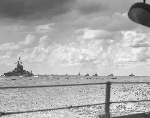 | 106k | The West Virginia (BB-48) stands off to port with the support vessels of the invasion fleet. | USN photo. | ||||||||||||||||||||||||||||||||||||||||||||||||||||||||||||||||||||||||||||||||||||||||||||||||||||||||||||||||||||||||||||||||||||||||||||||||||||||||||||||||||||||||||||||||||||||||||||||||||||||||||||||||||||||||||||||||||||||||||||||||||||||||||||||||||||||||||||||||||||||||||||||||||||||||||||||||||||||||||||||||||||||||||||||||||||||||||||||||||||||||||||||||||||||||||||||||||||||||||||||||||||||||||||||||||||||||||
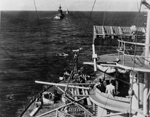 | 284k | At Ulithi, 27 January 1945 the Pensacola (CA-24) formed with a battleship-cruiser-destroyer gun strike task force under Rear Admiral B. J. Rodgers. Six battleships, four cruisers and a destroyer screen comprised the bombardment force which sailed 10 February via Tinian to Iwo Jima. Pictured here are the Nevada (BB-36), West Virginia (BB-48) & Pensacola. | Text courtesy of DANFS. USN photo # USN N-3173, courtesy of Scott Koen & ussnewyork.com. | ||||||||||||||||||||||||||||||||||||||||||||||||||||||||||||||||||||||||||||||||||||||||||||||||||||||||||||||||||||||||||||||||||||||||||||||||||||||||||||||||||||||||||||||||||||||||||||||||||||||||||||||||||||||||||||||||||||||||||||||||||||||||||||||||||||||||||||||||||||||||||||||||||||||||||||||||||||||||||||||||||||||||||||||||||||||||||||||||||||||||||||||||||||||||||||||||||||||||||||||||||||||||||||||||||||||||||
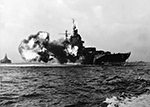 | 557k | Idaho (BB-42) & West Virginia (BB-48) provide fire support during the invasion of Okinawa. | USN photo courtesy of Joe MacDonald. | ||||||||||||||||||||||||||||||||||||||||||||||||||||||||||||||||||||||||||||||||||||||||||||||||||||||||||||||||||||||||||||||||||||||||||||||||||||||||||||||||||||||||||||||||||||||||||||||||||||||||||||||||||||||||||||||||||||||||||||||||||||||||||||||||||||||||||||||||||||||||||||||||||||||||||||||||||||||||||||||||||||||||||||||||||||||||||||||||||||||||||||||||||||||||||||||||||||||||||||||||||||||||||||||||||||||||||
 | 36k | Standing out brightly in her camouflage paint scheme, the West Virginia (BB-48) guards the landing craft as they head toward the beaches, April, 1945 at Okinawa. #2 and #3 turrets are trained outward, ready to provide immediate covering fire, if necessary. | USN photo. | ||||||||||||||||||||||||||||||||||||||||||||||||||||||||||||||||||||||||||||||||||||||||||||||||||||||||||||||||||||||||||||||||||||||||||||||||||||||||||||||||||||||||||||||||||||||||||||||||||||||||||||||||||||||||||||||||||||||||||||||||||||||||||||||||||||||||||||||||||||||||||||||||||||||||||||||||||||||||||||||||||||||||||||||||||||||||||||||||||||||||||||||||||||||||||||||||||||||||||||||||||||||||||||||||||||||||||
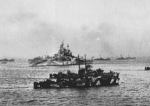 | 59k | Landing craft and converted LCS(L)s pass the West Virginia (BB-48) as they head towards shore. The LCS(Ls) have been converted to in shore support craft, being rearmed with 6 - 40mm guns and 10 rocket launchers. | USN photo. | ||||||||||||||||||||||||||||||||||||||||||||||||||||||||||||||||||||||||||||||||||||||||||||||||||||||||||||||||||||||||||||||||||||||||||||||||||||||||||||||||||||||||||||||||||||||||||||||||||||||||||||||||||||||||||||||||||||||||||||||||||||||||||||||||||||||||||||||||||||||||||||||||||||||||||||||||||||||||||||||||||||||||||||||||||||||||||||||||||||||||||||||||||||||||||||||||||||||||||||||||||||||||||||||||||||||||||
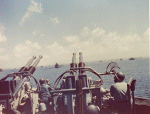 | 48k | 40mm gunners onboard the West Virginia (BB-48) aim at targets overhead above the invasion fleet off Okinawa. | Susy Forbes / USNI. | ||||||||||||||||||||||||||||||||||||||||||||||||||||||||||||||||||||||||||||||||||||||||||||||||||||||||||||||||||||||||||||||||||||||||||||||||||||||||||||||||||||||||||||||||||||||||||||||||||||||||||||||||||||||||||||||||||||||||||||||||||||||||||||||||||||||||||||||||||||||||||||||||||||||||||||||||||||||||||||||||||||||||||||||||||||||||||||||||||||||||||||||||||||||||||||||||||||||||||||||||||||||||||||||||||||||||||
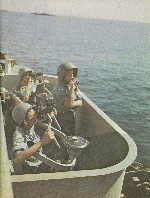 | 208k | Sky watch aboard the West Virginia's (BB-48) in 1945. | Photo courtesy of Pieter Bakels. | ||||||||||||||||||||||||||||||||||||||||||||||||||||||||||||||||||||||||||||||||||||||||||||||||||||||||||||||||||||||||||||||||||||||||||||||||||||||||||||||||||||||||||||||||||||||||||||||||||||||||||||||||||||||||||||||||||||||||||||||||||||||||||||||||||||||||||||||||||||||||||||||||||||||||||||||||||||||||||||||||||||||||||||||||||||||||||||||||||||||||||||||||||||||||||||||||||||||||||||||||||||||||||||||||||||||||||
 | 30k | Damage from a kamikaze attack on the West Virginia (BB-48), April 1945. | Photo from WWII Damage Reports, courtesy of NavSea / dcfp.navy.mil. | ||||||||||||||||||||||||||||||||||||||||||||||||||||||||||||||||||||||||||||||||||||||||||||||||||||||||||||||||||||||||||||||||||||||||||||||||||||||||||||||||||||||||||||||||||||||||||||||||||||||||||||||||||||||||||||||||||||||||||||||||||||||||||||||||||||||||||||||||||||||||||||||||||||||||||||||||||||||||||||||||||||||||||||||||||||||||||||||||||||||||||||||||||||||||||||||||||||||||||||||||||||||||||||||||||||||||||
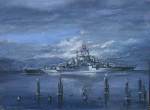 | 296k | A painting by the artist Wayne Scarpaci depicting the West Virginia (BB-48) anchored in Sagami Wan, Japan, outside Tokyo Bay, August 1945. | Drawing courtesy of artbywayne.com. | ||||||||||||||||||||||||||||||||||||||||||||||||||||||||||||||||||||||||||||||||||||||||||||||||||||||||||||||||||||||||||||||||||||||||||||||||||||||||||||||||||||||||||||||||||||||||||||||||||||||||||||||||||||||||||||||||||||||||||||||||||||||||||||||||||||||||||||||||||||||||||||||||||||||||||||||||||||||||||||||||||||||||||||||||||||||||||||||||||||||||||||||||||||||||||||||||||||||||||||||||||||||||||||||||||||||||||
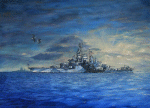 | 262k | A painting by the artist Wayne Scarpaci entitled "Tokyo Bay Sunset". The drawing depicts the West Virginia (BB-48) at anchor at the base of Mt Fujiamia in Tokyo Bay, September 1945. | Drawing courtesy of artbywayne.com. | ||||||||||||||||||||||||||||||||||||||||||||||||||||||||||||||||||||||||||||||||||||||||||||||||||||||||||||||||||||||||||||||||||||||||||||||||||||||||||||||||||||||||||||||||||||||||||||||||||||||||||||||||||||||||||||||||||||||||||||||||||||||||||||||||||||||||||||||||||||||||||||||||||||||||||||||||||||||||||||||||||||||||||||||||||||||||||||||||||||||||||||||||||||||||||||||||||||||||||||||||||||||||||||||||||||||||||
 | 17k | Envelope labeled "Empire Occupation Forces - Japan", depicting the West Virginia (BB-48) anchored in Sagami Wan, Japan, outside Tokyo Bay, August 1945. Mount Fuji is in the background. | Courtesy of Jack Treutle (of blessed memory). | ||||||||||||||||||||||||||||||||||||||||||||||||||||||||||||||||||||||||||||||||||||||||||||||||||||||||||||||||||||||||||||||||||||||||||||||||||||||||||||||||||||||||||||||||||||||||||||||||||||||||||||||||||||||||||||||||||||||||||||||||||||||||||||||||||||||||||||||||||||||||||||||||||||||||||||||||||||||||||||||||||||||||||||||||||||||||||||||||||||||||||||||||||||||||||||||||||||||||||||||||||||||||||||||||||||||||||
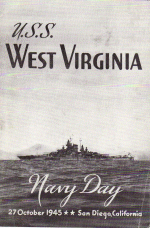 | 267k | Twelve page PDF article on the Navy Day Program for the battleship West Virginia (BB-48), in San Diego, CA on 27 October 1945. In this photo, the West Virginia is anchored in Sagami Wan, Japan, outside Tokyo Bay, circa late August 1945. Mount Fuji is in the background. | Photo courtesy of Robert M. Cieri. | ||||||||||||||||||||||||||||||||||||||||||||||||||||||||||||||||||||||||||||||||||||||||||||||||||||||||||||||||||||||||||||||||||||||||||||||||||||||||||||||||||||||||||||||||||||||||||||||||||||||||||||||||||||||||||||||||||||||||||||||||||||||||||||||||||||||||||||||||||||||||||||||||||||||||||||||||||||||||||||||||||||||||||||||||||||||||||||||||||||||||||||||||||||||||||||||||||||||||||||||||||||||||||||||||||||||||||
| Magic Carpet / Post War / Scrapping |
|||||||||||||||||||||||||||||||||||||||||||||||||||||||||||||||||||||||||||||||||||||||||||||||||||||||||||||||||||||||||||||||||||||||||||||||||||||||||||||||||||||||||||||||||||||||||||||||||||||||||||||||||||||||||||||||||||||||||||||||||||||||||||||||||||||||||||||||||||||||||||||||||||||||||||||||||||||||||||||||||||||||||||||||||||||||||||||||||||||||||||||||||||||||||||||||||||||||||||||||||||||||||||||||||||||||||||||
 | 340k | Navy Day photo, San Diego California, 27 October 1945 of West Virginia (BB-48) & crew before the Naval Supply Pier where the Midway Museum is located today. That is Building 11 behind the men. | Text i.d. via Karl Zingheim. Photos by TN 2 Esther Dorothy Black, USNR, courtesy of David Buell. | ||||||||||||||||||||||||||||||||||||||||||||||||||||||||||||||||||||||||||||||||||||||||||||||||||||||||||||||||||||||||||||||||||||||||||||||||||||||||||||||||||||||||||||||||||||||||||||||||||||||||||||||||||||||||||||||||||||||||||||||||||||||||||||||||||||||||||||||||||||||||||||||||||||||||||||||||||||||||||||||||||||||||||||||||||||||||||||||||||||||||||||||||||||||||||||||||||||||||||||||||||||||||||||||||||||||||||
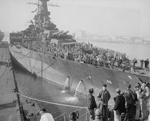 014834 | 1.08k | Battleship West Virginia (BB-48) brings back 2100 GI's for discharge. GI's jam every available space on deck & on turrets upon arrivial in Los Angeles from Honolulu on 13 November 1945. | Photo courtesy of rmyauctions.com. Photo courtesy of Daniel Hacker. |
||||||||||||||||||||||||||||||||||||||||||||||||||||||||||||||||||||||||||||||||||||||||||||||||||||||||||||||||||||||||||||||||||||||||||||||||||||||||||||||||||||||||||||||||||||||||||||||||||||||||||||||||||||||||||||||||||||||||||||||||||||||||||||||||||||||||||||||||||||||||||||||||||||||||||||||||||||||||||||||||||||||||||||||||||||||||||||||||||||||||||||||||||||||||||||||||||||||||||||||||||||||||||||||||||||||||||
 | 98k | A line drawing by A.L. Raven of the West Virginia (BB-48) in late 1945. | Photo and text courtesy of U.S. Battleships: An Illustrated Design History by Norman Friedman. | ||||||||||||||||||||||||||||||||||||||||||||||||||||||||||||||||||||||||||||||||||||||||||||||||||||||||||||||||||||||||||||||||||||||||||||||||||||||||||||||||||||||||||||||||||||||||||||||||||||||||||||||||||||||||||||||||||||||||||||||||||||||||||||||||||||||||||||||||||||||||||||||||||||||||||||||||||||||||||||||||||||||||||||||||||||||||||||||||||||||||||||||||||||||||||||||||||||||||||||||||||||||||||||||||||||||||||
 | 118k | The first of the following two images, show the West Virginia (BB-48) being mothballed. They are good detail shots and show her in dry-dock at Puget Sound 12 April 1946, being inclined as well as being prepared for de-humidification. Of interest is the small radars that replaced the optical rangefinders, on #3 turret and the fact that all 20mm mounts have been removed; the quad 40mm mounts were removed completely or covered, in preparation for the mothball "cocoons". | USN photo. | ||||||||||||||||||||||||||||||||||||||||||||||||||||||||||||||||||||||||||||||||||||||||||||||||||||||||||||||||||||||||||||||||||||||||||||||||||||||||||||||||||||||||||||||||||||||||||||||||||||||||||||||||||||||||||||||||||||||||||||||||||||||||||||||||||||||||||||||||||||||||||||||||||||||||||||||||||||||||||||||||||||||||||||||||||||||||||||||||||||||||||||||||||||||||||||||||||||||||||||||||||||||||||||||||||||||||||
 | 112k | The second of the following two images, show the West Virginia (BB-48) being mothballed. They are good detail shots and show her in dry-dock at Puget Sound 12 April 1946, being inclined as well as being prepared for de-humidification. Of interest is the small radars that replaced the optical range finders, on #3 turret and the fact that all 20mm mounts have been removed; the quad 40mm mounts were removed completely or covered, in preparation for the mothball "cocoons". | USN photo. | ||||||||||||||||||||||||||||||||||||||||||||||||||||||||||||||||||||||||||||||||||||||||||||||||||||||||||||||||||||||||||||||||||||||||||||||||||||||||||||||||||||||||||||||||||||||||||||||||||||||||||||||||||||||||||||||||||||||||||||||||||||||||||||||||||||||||||||||||||||||||||||||||||||||||||||||||||||||||||||||||||||||||||||||||||||||||||||||||||||||||||||||||||||||||||||||||||||||||||||||||||||||||||||||||||||||||||
 | 1.10k | Puget Sound NSY around 1948. There are five mothballed Essex class (CV-9) carriers at the left. To the right of the carriers are five battleships. I believe they are Alabama (BB-60), West Virginia (BB-48), Maryland (BB-46), Indiana (BB-58), Colorado (BB-45). | USN photo courtesy of Joe MacDonald. | ||||||||||||||||||||||||||||||||||||||||||||||||||||||||||||||||||||||||||||||||||||||||||||||||||||||||||||||||||||||||||||||||||||||||||||||||||||||||||||||||||||||||||||||||||||||||||||||||||||||||||||||||||||||||||||||||||||||||||||||||||||||||||||||||||||||||||||||||||||||||||||||||||||||||||||||||||||||||||||||||||||||||||||||||||||||||||||||||||||||||||||||||||||||||||||||||||||||||||||||||||||||||||||||||||||||||||
> | 570k | Four mothballed battleships at Puget Sound Naval Shipyard in 1948. Left to right: Alabama (BB-60), West Virginia (BB-48), Indiana (BB-58) & Colorado (BB-45). | Photo courtesy of Joe MacDonald. | ||||||||||||||||||||||||||||||||||||||||||||||||||||||||||||||||||||||||||||||||||||||||||||||||||||||||||||||||||||||||||||||||||||||||||||||||||||||||||||||||||||||||||||||||||||||||||||||||||||||||||||||||||||||||||||||||||||||||||||||||||||||||||||||||||||||||||||||||||||||||||||||||||||||||||||||||||||||||||||||||||||||||||||||||||||||||||||||||||||||||||||||||||||||||||||||||||||||||||||||||||||||||||||||||||||||||||
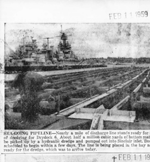 | 1.10k | SEA GOING PIPELINE The soon to be scrapped battleships Maryland (BB-46) & West Virginia (BB-48) lie anchored in the background. | Bremerton Sun photo, 11 February 1959, submitted by Joe MacDonald. | ||||||||||||||||||||||||||||||||||||||||||||||||||||||||||||||||||||||||||||||||||||||||||||||||||||||||||||||||||||||||||||||||||||||||||||||||||||||||||||||||||||||||||||||||||||||||||||||||||||||||||||||||||||||||||||||||||||||||||||||||||||||||||||||||||||||||||||||||||||||||||||||||||||||||||||||||||||||||||||||||||||||||||||||||||||||||||||||||||||||||||||||||||||||||||||||||||||||||||||||||||||||||||||||||||||||||||
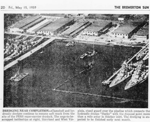 | 1.82k | DREDGING NEARING COMPLETION ....The soon to be scrapped battleships at right, Maryland (BB-46) & West Virginia (BB-48), stand guard over the pipeline... | Bremerton Sun photo, 15 May 1959, submitted by Joe MacDonald. | ||||||||||||||||||||||||||||||||||||||||||||||||||||||||||||||||||||||||||||||||||||||||||||||||||||||||||||||||||||||||||||||||||||||||||||||||||||||||||||||||||||||||||||||||||||||||||||||||||||||||||||||||||||||||||||||||||||||||||||||||||||||||||||||||||||||||||||||||||||||||||||||||||||||||||||||||||||||||||||||||||||||||||||||||||||||||||||||||||||||||||||||||||||||||||||||||||||||||||||||||||||||||||||||||||||||||||
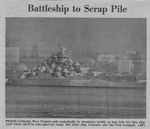 | 1.30k | "Proud battleship West Virginia (BB-48) sails majestically by downtown Seattle as tugs help her into shipyard where she will be torn apart for scrap. Her sister-ship,Colorado (BB-45) has also been scrapped. | AP Photo courtesy of Denis Mikkelsen collection via Carol Edgemon Hipperson author of Radioman: An Eyewitness Account of Pearl Harbor & World War II in the Pacific (Thomas Dunne Books / St. Martins Press, 2008) & The Belly Gunner: An Eyewitness Account of Stalag 17 & World War II in Europe (Twenty-First Century Books / Millbrook Press, 2001). | ||||||||||||||||||||||||||||||||||||||||||||||||||||||||||||||||||||||||||||||||||||||||||||||||||||||||||||||||||||||||||||||||||||||||||||||||||||||||||||||||||||||||||||||||||||||||||||||||||||||||||||||||||||||||||||||||||||||||||||||||||||||||||||||||||||||||||||||||||||||||||||||||||||||||||||||||||||||||||||||||||||||||||||||||||||||||||||||||||||||||||||||||||||||||||||||||||||||||||||||||||||||||||||||||||||||||||
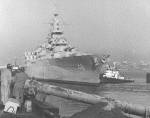 | 118k | West Virginia (BB-48) being towed away to be scrapped, 1 March 1959. | Official USN photo courtesy of wvculture.org-history and submitted by Joe MacDonald. | ||||||||||||||||||||||||||||||||||||||||||||||||||||||||||||||||||||||||||||||||||||||||||||||||||||||||||||||||||||||||||||||||||||||||||||||||||||||||||||||||||||||||||||||||||||||||||||||||||||||||||||||||||||||||||||||||||||||||||||||||||||||||||||||||||||||||||||||||||||||||||||||||||||||||||||||||||||||||||||||||||||||||||||||||||||||||||||||||||||||||||||||||||||||||||||||||||||||||||||||||||||||||||||||||||||||||||
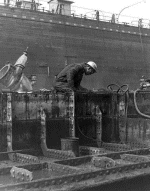 | 103k | Disassembling the West Virginia (BB-48). | Official USN photo courtesy of Todd Pacific Shipyards / wvculture.org-history and submitted by Mike Green. | ||||||||||||||||||||||||||||||||||||||||||||||||||||||||||||||||||||||||||||||||||||||||||||||||||||||||||||||||||||||||||||||||||||||||||||||||||||||||||||||||||||||||||||||||||||||||||||||||||||||||||||||||||||||||||||||||||||||||||||||||||||||||||||||||||||||||||||||||||||||||||||||||||||||||||||||||||||||||||||||||||||||||||||||||||||||||||||||||||||||||||||||||||||||||||||||||||||||||||||||||||||||||||||||||||||||||||
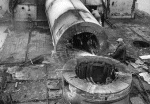 | 124k | A shipyard worker torching an armored uptake of some kind (Perhaps the aft Fire Control tower; note the severed electrical cables lining the structure) of the West Virginia (BB-48). | Official USN photo courtesy of Todd Pacific Shipyards / wvculture.org.history and submitted by Mike Green. Text courtesy of Dan Morgan. | ||||||||||||||||||||||||||||||||||||||||||||||||||||||||||||||||||||||||||||||||||||||||||||||||||||||||||||||||||||||||||||||||||||||||||||||||||||||||||||||||||||||||||||||||||||||||||||||||||||||||||||||||||||||||||||||||||||||||||||||||||||||||||||||||||||||||||||||||||||||||||||||||||||||||||||||||||||||||||||||||||||||||||||||||||||||||||||||||||||||||||||||||||||||||||||||||||||||||||||||||||||||||||||||||||||||||||
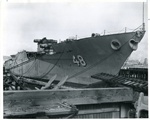 | 169k | Her guns can be seen without its barrel and outer armor piece. | Photo courtesy of usswv.lib.wvu.edu. Photo courtesy of Yu Chu. |
||||||||||||||||||||||||||||||||||||||||||||||||||||||||||||||||||||||||||||||||||||||||||||||||||||||||||||||||||||||||||||||||||||||||||||||||||||||||||||||||||||||||||||||||||||||||||||||||||||||||||||||||||||||||||||||||||||||||||||||||||||||||||||||||||||||||||||||||||||||||||||||||||||||||||||||||||||||||||||||||||||||||||||||||||||||||||||||||||||||||||||||||||||||||||||||||||||||||||||||||||||||||||||||||||||||||||
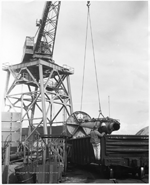 014804 | 546k | Mast of the West Virginia (BB-48) being Loaded for Shipment to Morgantown, W. Va., 1961. | Photo courtesy of usswv.lib.wvu.edu. Photo courtesy of Daniel Hacker. |
||||||||||||||||||||||||||||||||||||||||||||||||||||||||||||||||||||||||||||||||||||||||||||||||||||||||||||||||||||||||||||||||||||||||||||||||||||||||||||||||||||||||||||||||||||||||||||||||||||||||||||||||||||||||||||||||||||||||||||||||||||||||||||||||||||||||||||||||||||||||||||||||||||||||||||||||||||||||||||||||||||||||||||||||||||||||||||||||||||||||||||||||||||||||||||||||||||||||||||||||||||||||||||||||||||||||||
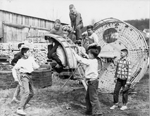 014864 | 740k | Children playing on the mast of the West Virginia (BB-48), before it was erected in Memorial Plaza, West Virginia University, Morgantown, W. Va., 1961. | Photo courtesy of usswv.lib.wvu.edu. Photo courtesy of Daniel Hacker. |
||||||||||||||||||||||||||||||||||||||||||||||||||||||||||||||||||||||||||||||||||||||||||||||||||||||||||||||||||||||||||||||||||||||||||||||||||||||||||||||||||||||||||||||||||||||||||||||||||||||||||||||||||||||||||||||||||||||||||||||||||||||||||||||||||||||||||||||||||||||||||||||||||||||||||||||||||||||||||||||||||||||||||||||||||||||||||||||||||||||||||||||||||||||||||||||||||||||||||||||||||||||||||||||||||||||||||
 014889 | 667k | Plaque Mounted on Mast of the West Virginia (BB-48) in Memorial Plaza, West Virginia University, Morgantown, W. Va. | Photo courtesy of usswv.lib.wvu.edu. Photo courtesy of Daniel Hacker. | ||||||||||||||||||||||||||||||||||||||||||||||||||||||||||||||||||||||||||||||||||||||||||||||||||||||||||||||||||||||||||||||||||||||||||||||||||||||||||||||||||||||||||||||||||||||||||||||||||||||||||||||||||||||||||||||||||||||||||||||||||||||||||||||||||||||||||||||||||||||||||||||||||||||||||||||||||||||||||||||||||||||||||||||||||||||||||||||||||||||||||||||||||||||||||||||||||||||||||||||||||||||||||||||||||||||||||
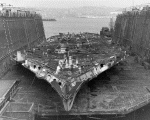 | 131k | The end of the West Virginia (BB-48). | Official USN photo courtesy of Todd Pacific Shipyards / wvculture.org-history and submitted by Mike Green. | ||||||||||||||||||||||||||||||||||||||||||||||||||||||||||||||||||||||||||||||||||||||||||||||||||||||||||||||||||||||||||||||||||||||||||||||||||||||||||||||||||||||||||||||||||||||||||||||||||||||||||||||||||||||||||||||||||||||||||||||||||||||||||||||||||||||||||||||||||||||||||||||||||||||||||||||||||||||||||||||||||||||||||||||||||||||||||||||||||||||||||||||||||||||||||||||||||||||||||||||||||||||||||||||||||||||||||
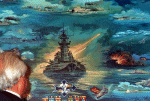 | 376k | A guest studies a painting depicting the history of battleships. The artwork was painted by George Skybeck and presented to the Pearl Harbor Survivors Association during their annual banquet at Honolulu, Hawaii, on 8 December 1991. | USN photo # DN-SC-92-05391, by PHC Carolyn Harris, from the Department of Defense Still Media Collection, courtesy of dodmedia.osd.mil. | ||||||||||||||||||||||||||||||||||||||||||||||||||||||||||||||||||||||||||||||||||||||||||||||||||||||||||||||||||||||||||||||||||||||||||||||||||||||||||||||||||||||||||||||||||||||||||||||||||||||||||||||||||||||||||||||||||||||||||||||||||||||||||||||||||||||||||||||||||||||||||||||||||||||||||||||||||||||||||||||||||||||||||||||||||||||||||||||||||||||||||||||||||||||||||||||||||||||||||||||||||||||||||||||||||||||||||
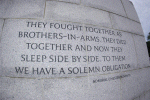 | 371k | A quote made by Fleet Adm. Chester W. Nimitz is inscribed on a granite wall at the National World War II Memorial located on the National Mall in Washington, D.C. Fleet Adm. Nimitz was the United States signatory to the surrender terms aboard the battleship Missouri (BB-63) in Tokyo Bay, Japan on 2 September 1945, thus ending World War II. Established by the American Battle Monuments Commission, the memorial honors all military veterans of World War II, the citizens on the home front, the nation at large, and the high moral purpose and idealism that motivated the nation's call to arms. On 29 May 2004, the memorial was formally dedicated with an estimated 200,000 people expected to attend, and includes 100,000 visiting veterans of all wars. | USN photo # N-0295M-011 by Photographer's Mate 2nd Class Daniel J. McLain, courtesy of news.navy.mil. | ||||||||||||||||||||||||||||||||||||||||||||||||||||||||||||||||||||||||||||||||||||||||||||||||||||||||||||||||||||||||||||||||||||||||||||||||||||||||||||||||||||||||||||||||||||||||||||||||||||||||||||||||||||||||||||||||||||||||||||||||||||||||||||||||||||||||||||||||||||||||||||||||||||||||||||||||||||||||||||||||||||||||||||||||||||||||||||||||||||||||||||||||||||||||||||||||||||||||||||||||||||||||||||||||||||||||||
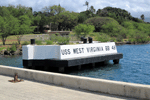 014899 | 827k | West Virginia (BB-48) mooring quay at Pearl Harbor. | Photo courtesy of Wally Gobetz via Yu Chu. | ||||||||||||||||||||||||||||||||||||||||||||||||||||||||||||||||||||||||||||||||||||||||||||||||||||||||||||||||||||||||||||||||||||||||||||||||||||||||||||||||||||||||||||||||||||||||||||||||||||||||||||||||||||||||||||||||||||||||||||||||||||||||||||||||||||||||||||||||||||||||||||||||||||||||||||||||||||||||||||||||||||||||||||||||||||||||||||||||||||||||||||||||||||||||||||||||||||||||||||||||||||||||||||||||||||||||||
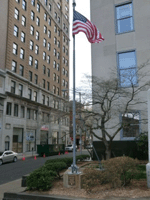 014848b | 221k | West Virginia (BB-48) bow flag pole staff outside Harrison County Courthouse, Clarksburg since 1963. | Photo courtesy of Yu Chu. | ||||||||||||||||||||||||||||||||||||||||||||||||||||||||||||||||||||||||||||||||||||||||||||||||||||||||||||||||||||||||||||||||||||||||||||||||||||||||||||||||||||||||||||||||||||||||||||||||||||||||||||||||||||||||||||||||||||||||||||||||||||||||||||||||||||||||||||||||||||||||||||||||||||||||||||||||||||||||||||||||||||||||||||||||||||||||||||||||||||||||||||||||||||||||||||||||||||||||||||||||||||||||||||||||||||||||||
| Commanding Officers | ||
| 01 | CAPT. Senn, Thomas Jones, USN (USNA 1891) :RADM | 01.12.1923 - 05.05.1925 |
| 02 | CAPT. Hepburn, Arthur Japy, USN (USNA 1897) :ADM | 05.05.1925 - 04.06.1926 |
| 03 | CAPT. Cluverius, Wat Tyler, USN (USNA 1896) :RADM | 04.06.1926 - 26.06.1928 |
| 04 | CAPT. Murfin, Orin Gould, USN (USNA 1897) :ADM | 26.06.1928 - 15.06.1929 |
| 05 | CAPT. Constein, Edward Theodore, USN (USNA 1898) | 15.06.1929 - 26.06.1930 |
| 06 | CAPT. Cole, Cyrus Willard, USN (USNA 1899) :RADM | 26.06.1930 - 12.01.1932 |
| 07 | CAPT. Anderson, Walter Stratton, USN (USNA 1903) :VADM | 12.01.1932 - 14.12.1933 |
| 08 | CAPT. Stark, Harold Raynsford, USN (USNA 1903) :ADM | 14.12.1933 - 17.10.1934 |
| 09 | CAPT. Dillen, Roscoe Franklin, USN (USNA 1904) | 17.10.1934 - 09.06.1936 |
| 10 | CAPT. Furlong, William Rea, USN (USNA 1905) :RADM | 09.06.1936 - 21.06.1937 |
| 11 | CAPT. Spears, William Oscar, USN (USNA 1905) | 21.06.1937 - 14.05.1938 |
| 12 | CAPT. Jensen, Henry Martin, USN (USNA 1906) | 14.05.1938 - 05.01.1940 |
| 13 | CAPT. Markland, Henry Thomas, USN (USNA 1908) | 05.01.1940 - 12.08.1941 |
| 14 | CAPT. Bennion, Mervyn Sharp, USN (USNA 1910) | 12.08.1941 - 07.12.1941 |
| 15 | LCDR. White, William, LCDR | 07.12.1941 - 15.11.1942 |
| 16 | CDR . Knight Jr., Levi James, | 15.11.1942 - 10.01.1944 |
| 17 | CDR. King, George Joseph, USN (USNA 1925) | 10.01.1944 - 15.01.1944 |
| 18 | CAPT. Wiley, Herbert Victor, USN (USNA 1915) :VADM | 15.01.1944 - 02.05.1945 |
| 19 | CAPT. Holsinger, Raymond Wilson, USN (USNA 1920) :RADM | 02.05.1945 - 17.01.1946 |
| 20 | CDR. Andrews, Richard W., | 17.01.1946 - 09.01.1947 |
The contact listed, Was the contact at the time for this ship when located. If another person now is the contact, E-mail me and I will update this entry. These contacts are compiled from various sources over a long period of time and may or may not be correct. Every effort has been made to list the newest contact if more than one contact was found.
| Back To The Main Photo Index | Back To The Battleship Photo Index Page |